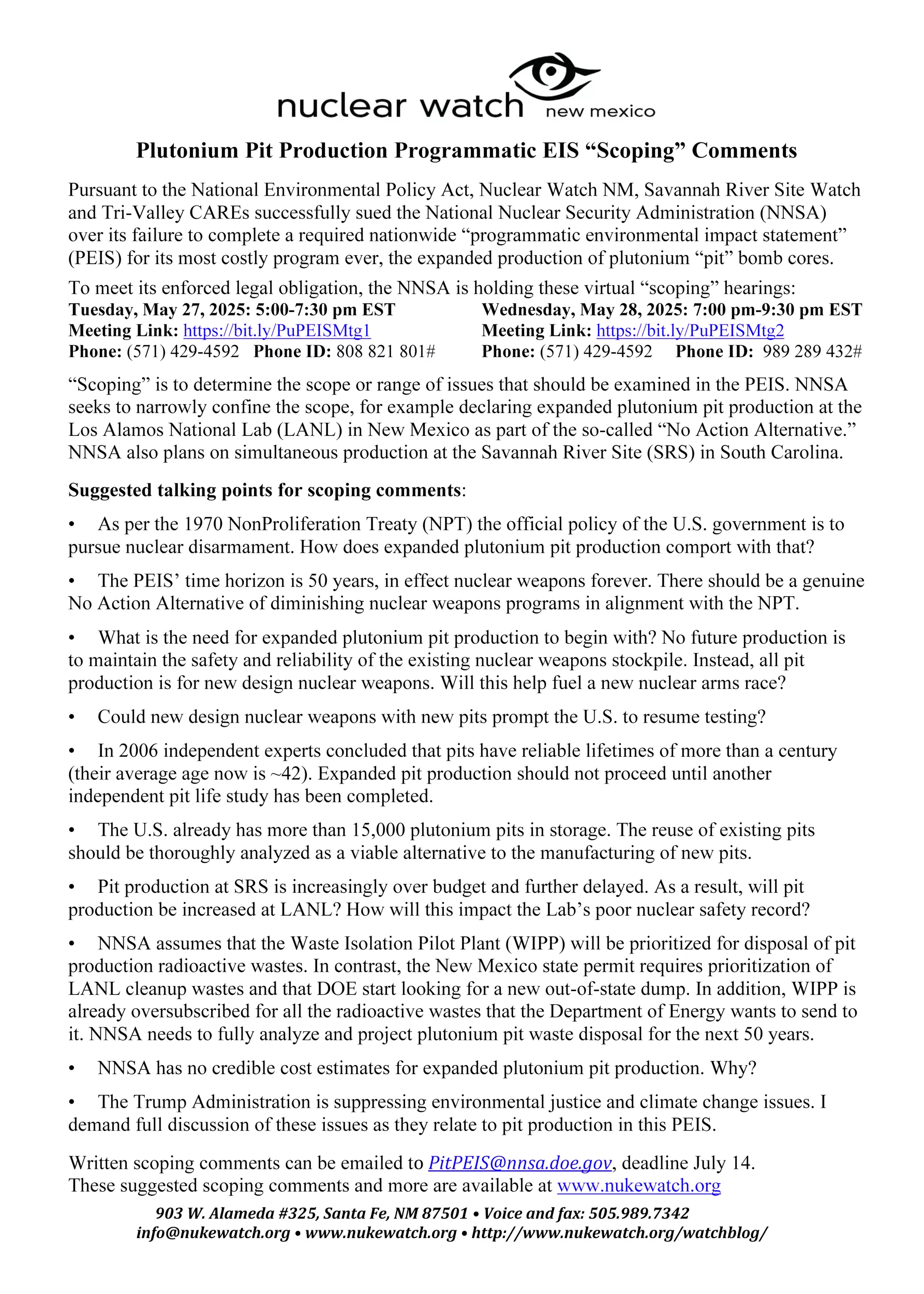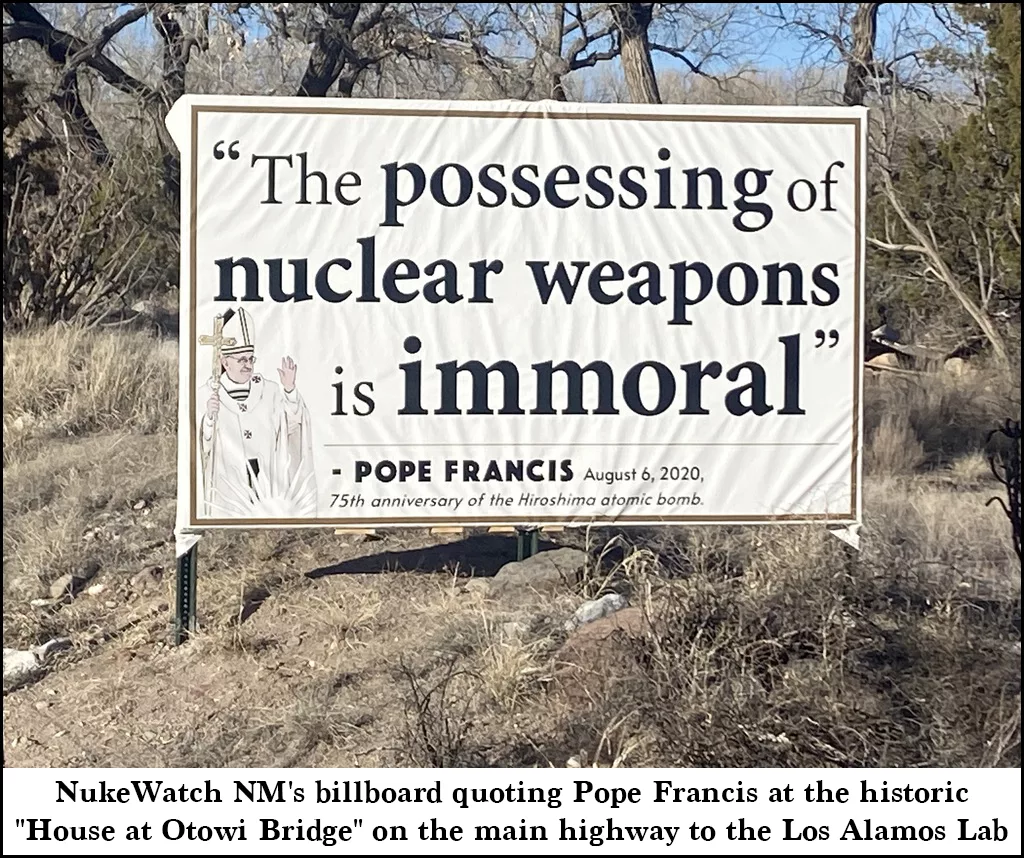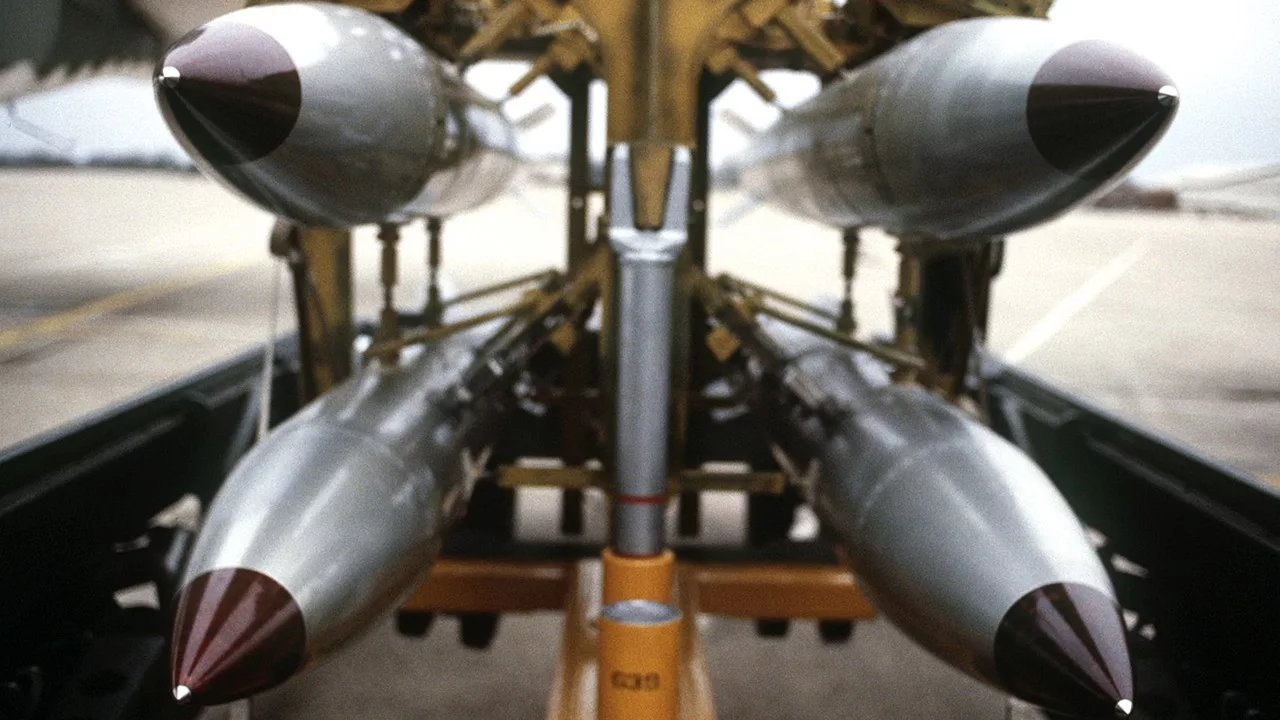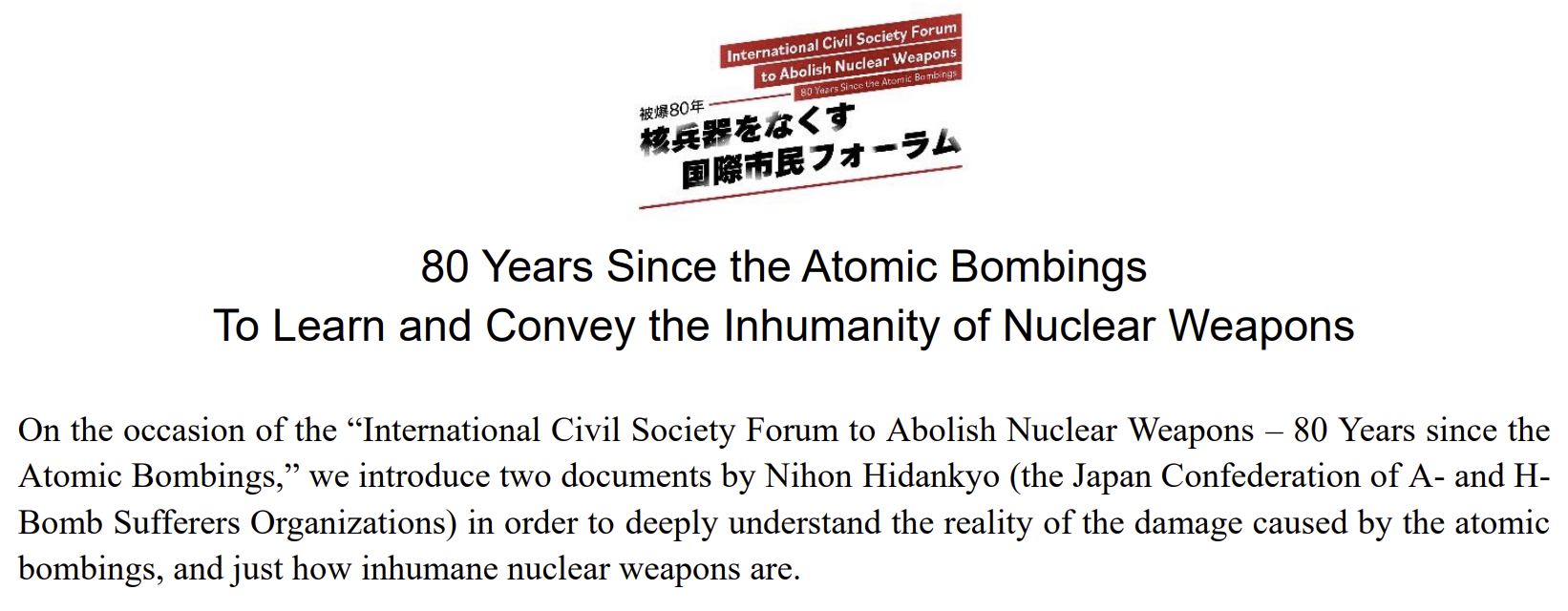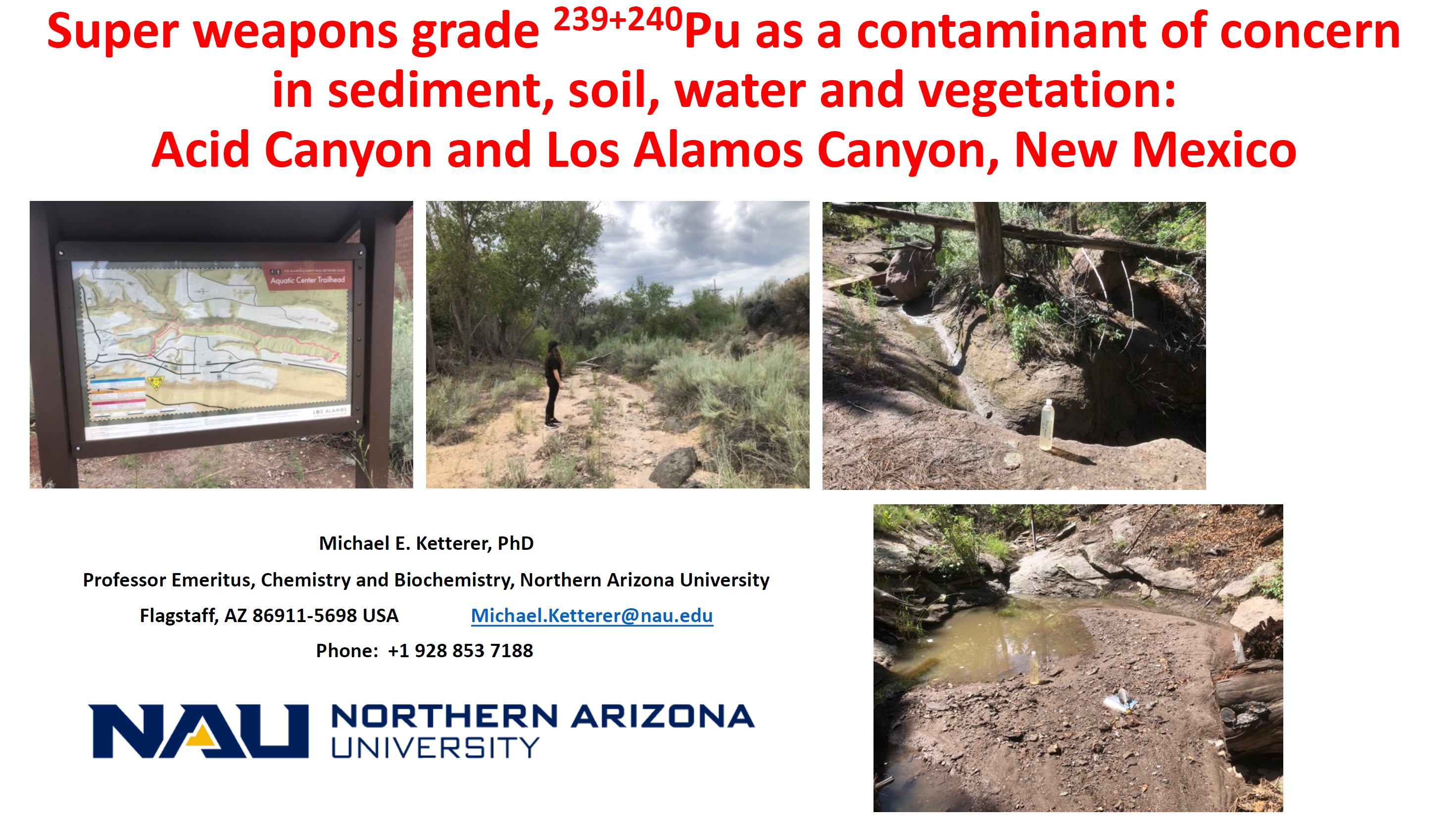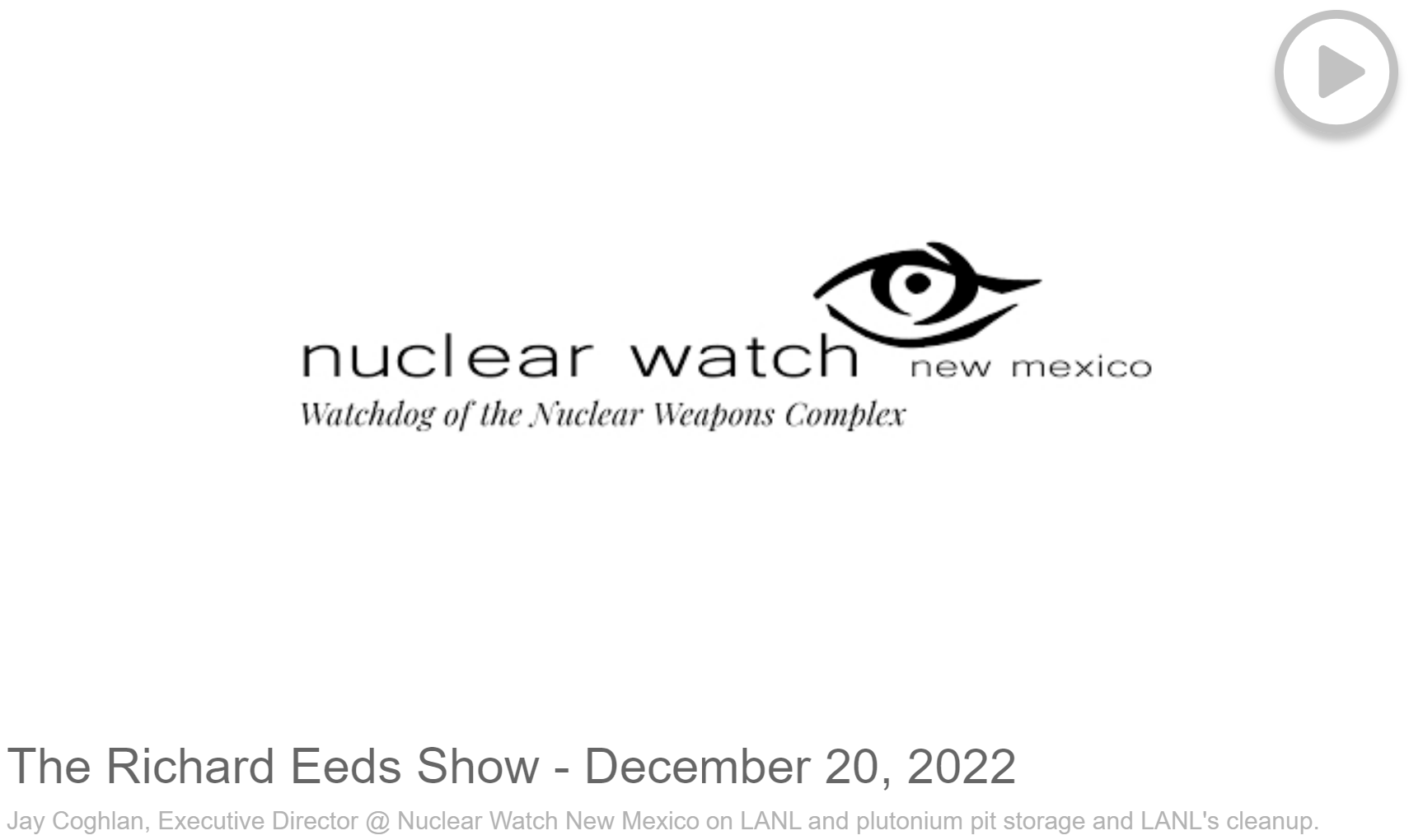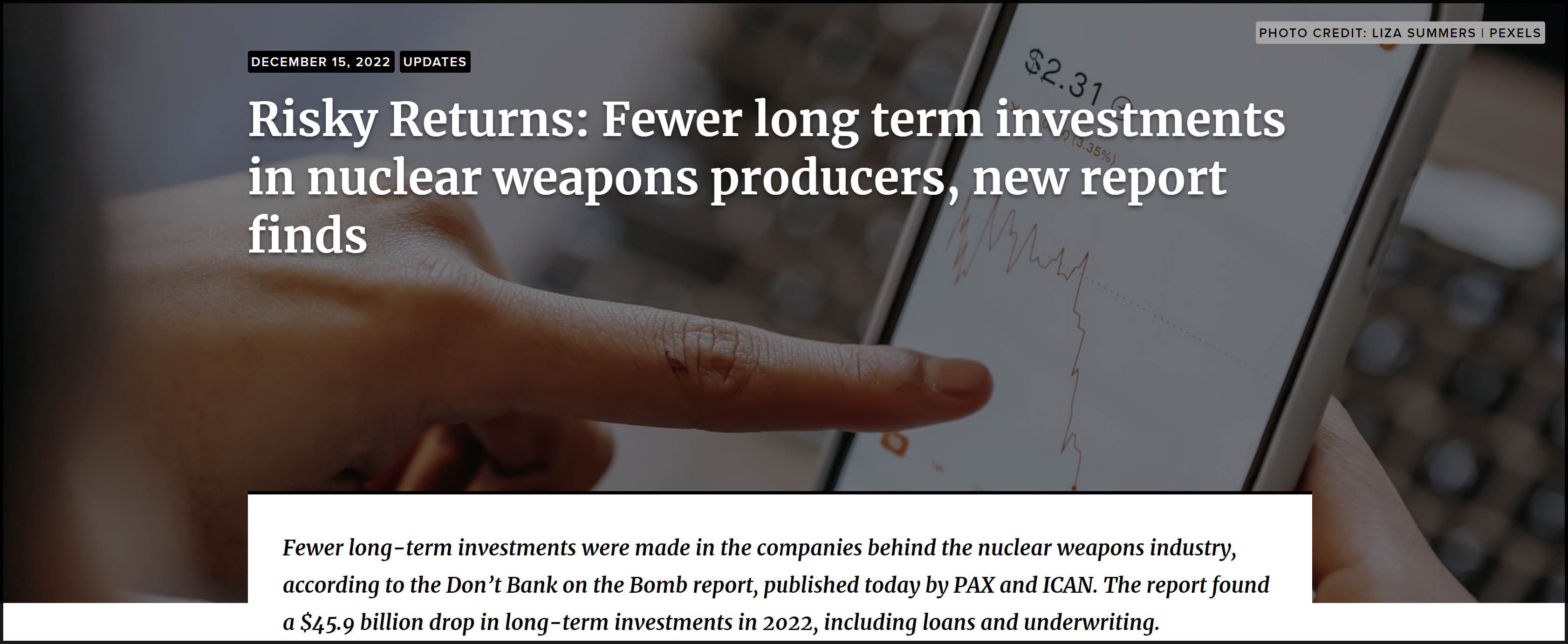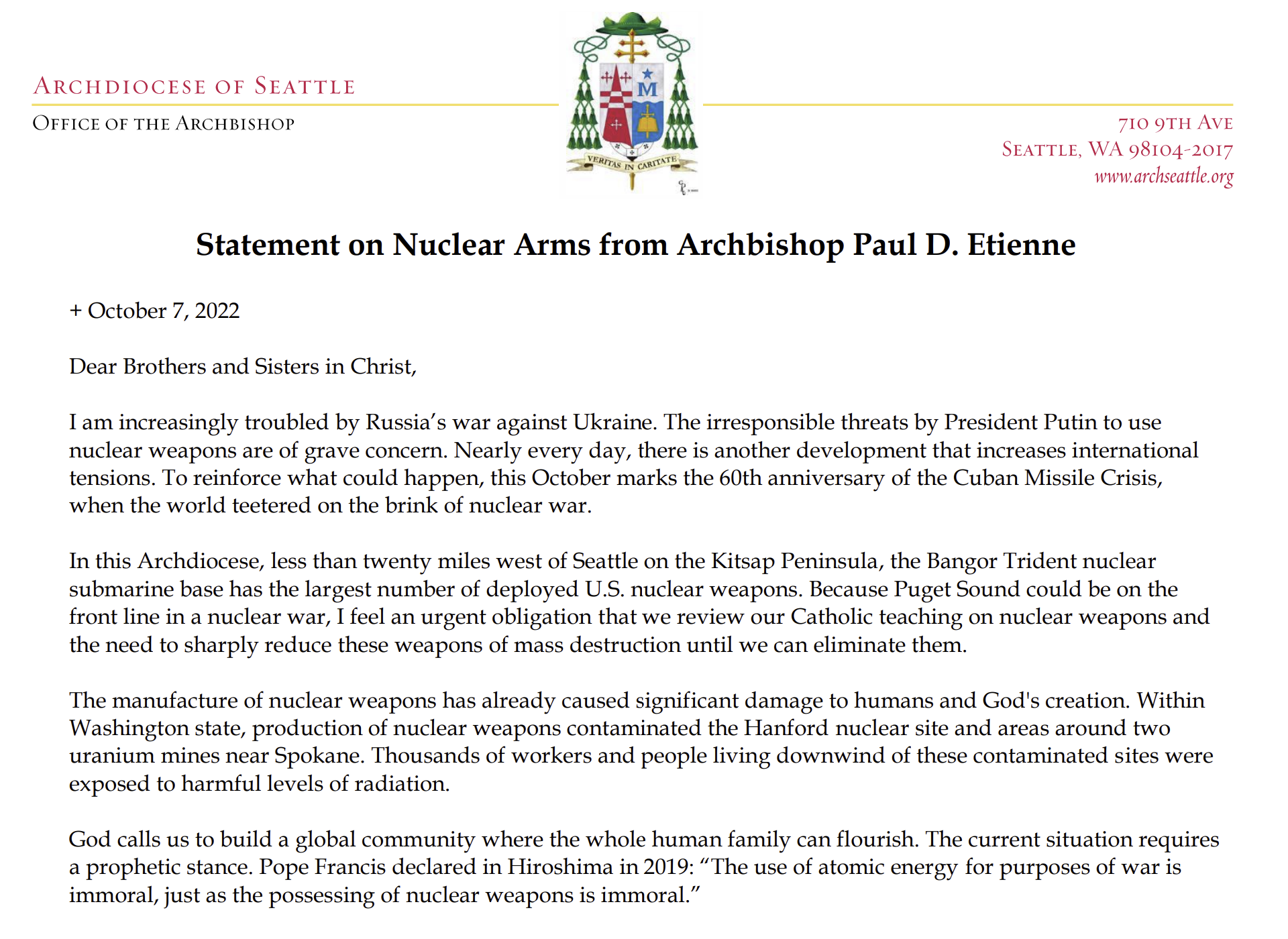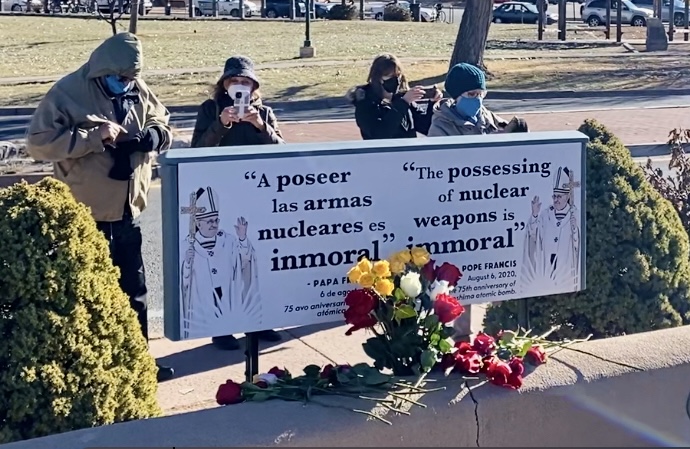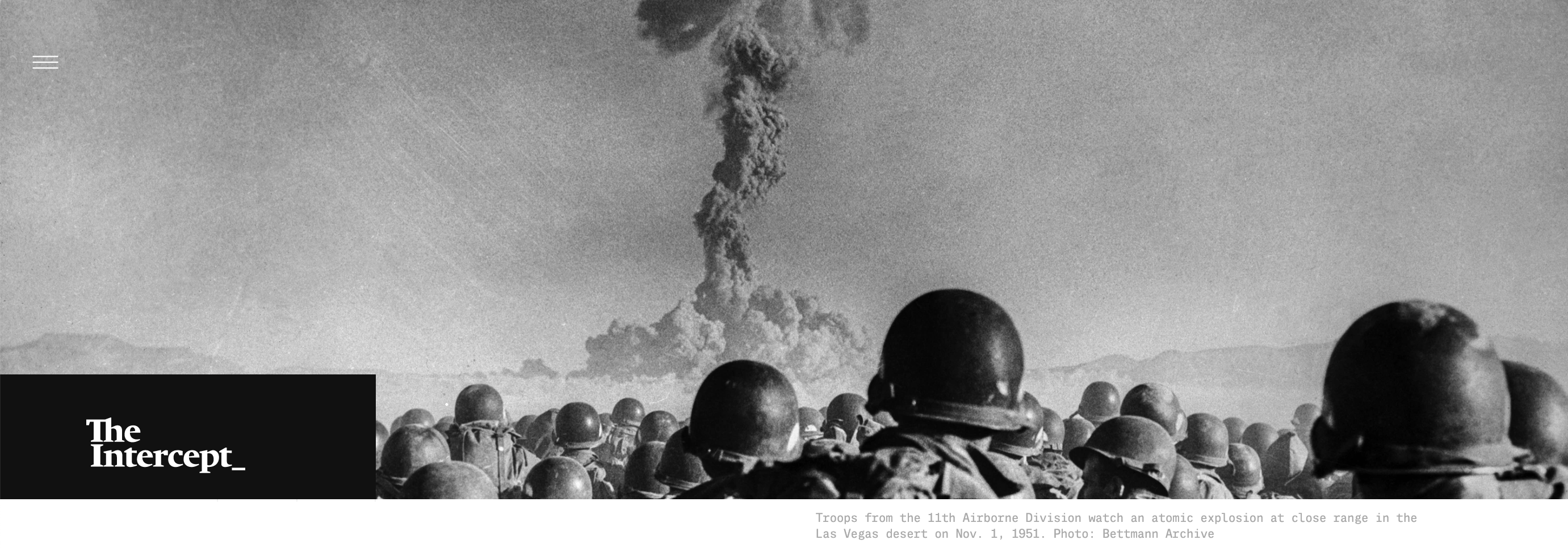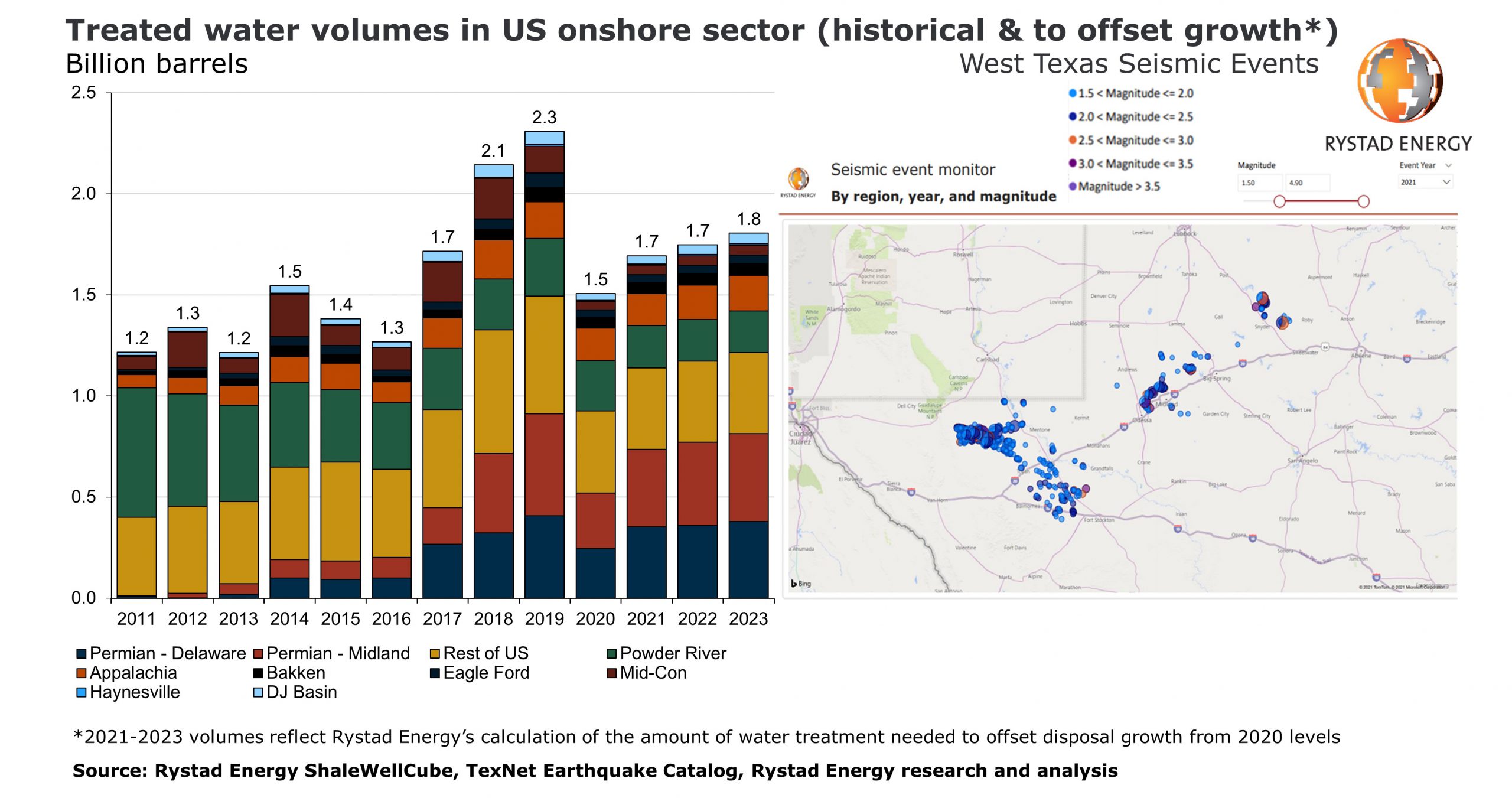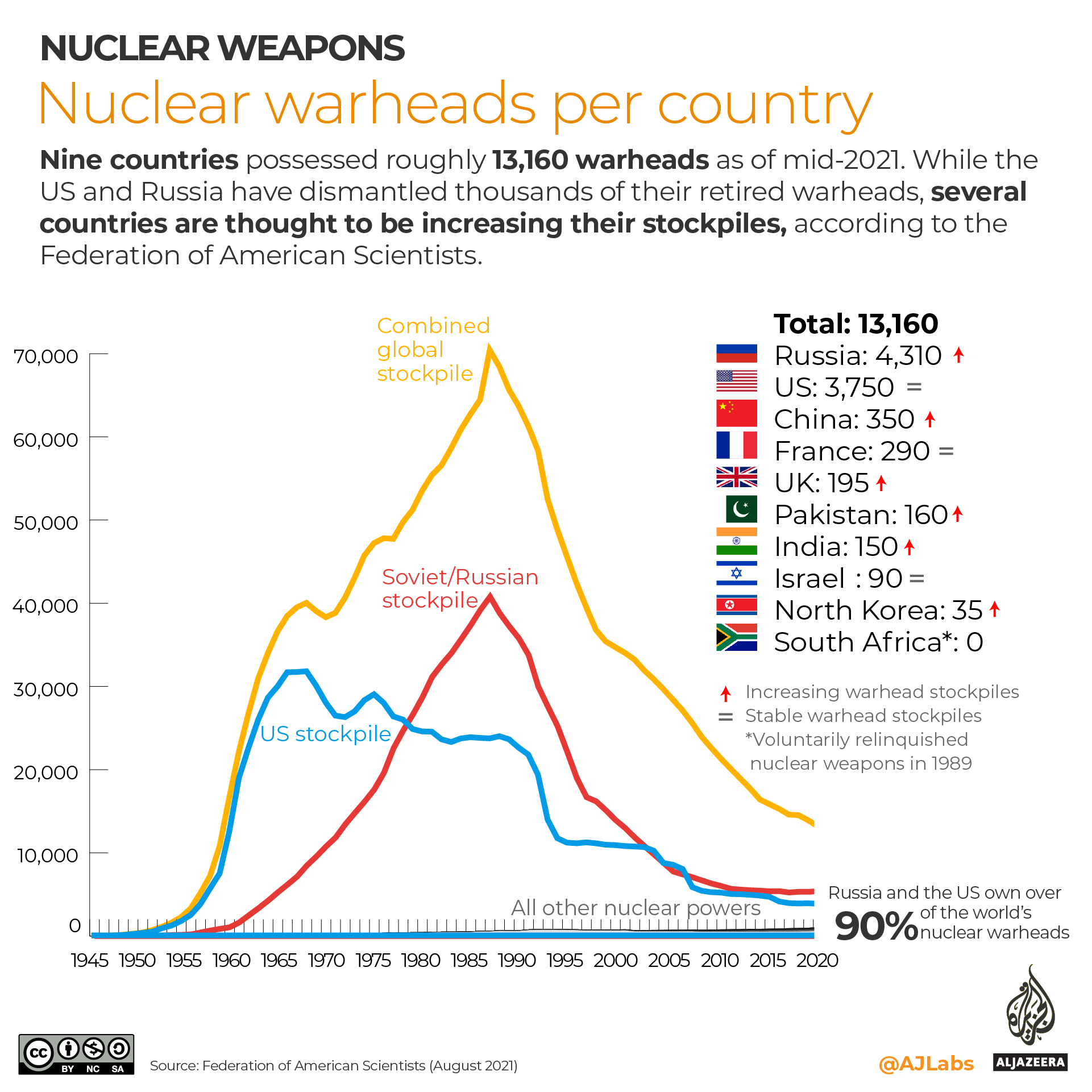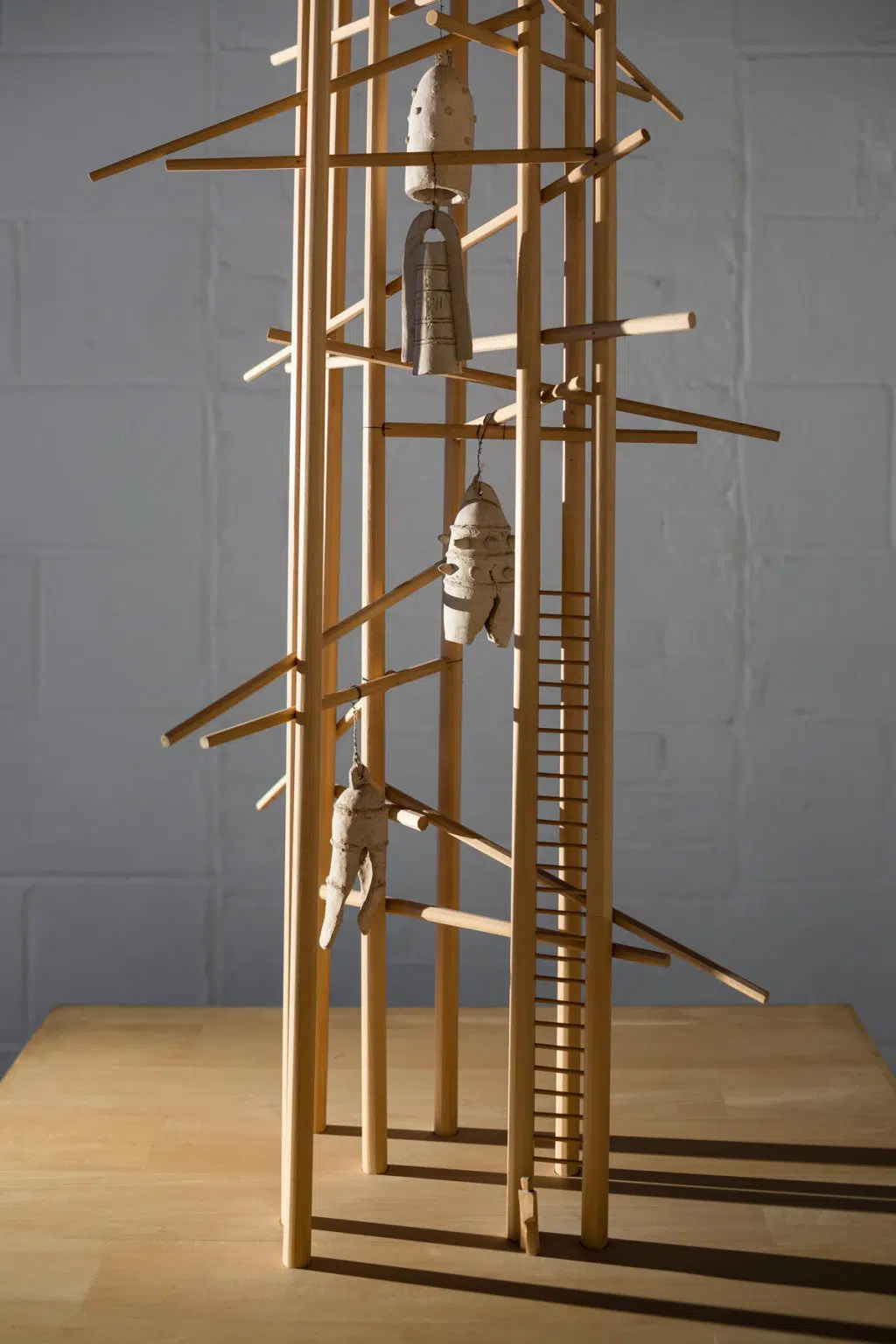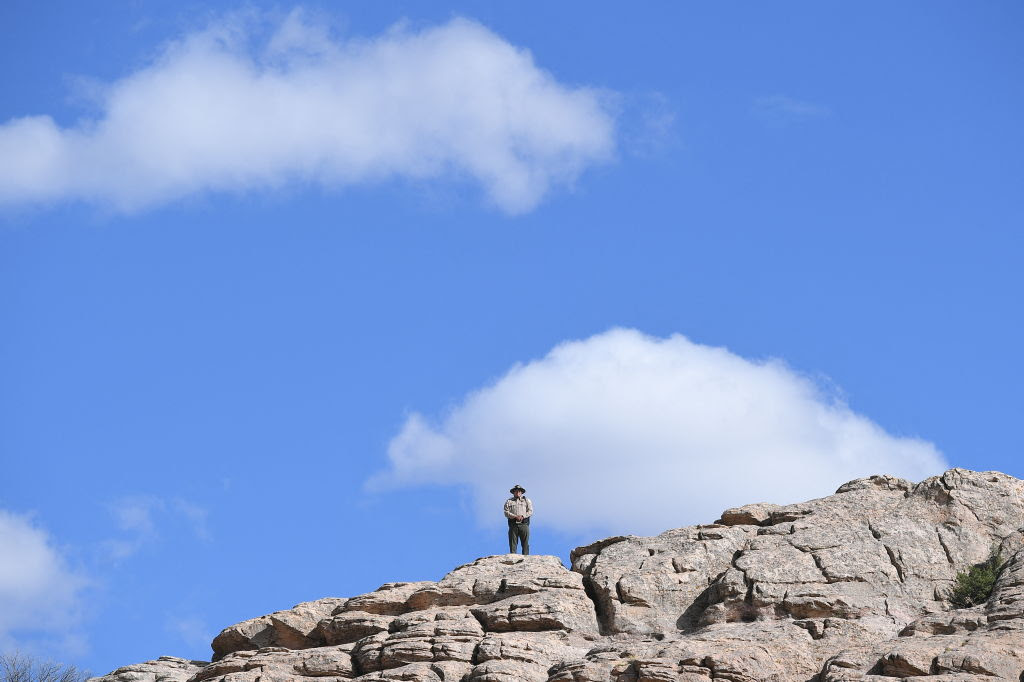Full Recording: Second Scoping Hearing for NNSA’s Programmatic Environmental Impact Statement on Plutonium Pit Production
Operation Crossroads: “The World’s First Nuclear Disaster”
“With Trump back in office, the recurring question of the need for nuclear weapons testing has resurfaced in the national security debate. Project 2025’s directive that the US return to ‘immediate test readiness’ raises further alarm, given the primacy of that document in Trump’s circle. The general uncertainty around current U.S. nuclear posture gives added weight to the historical importance of the atmospheric and underwater nuclear weapons tests conducted on the Bikini Atoll, recounted here by one of the leading advocates for public safety in the nuclear age. —Ed.”
By Robert Alvarez | Washington Spectator, National Security | May 29, 2025, washingtonspectator.com
Beginning in the late 1970’s, I was working for the Environmental Policy Institute around the time when atomic veterans started to descend on the nation’s capital. I would arrange meetings with Congressional offices, and the offices of both the Defense Nuclear Agency and Veterans Affairs, to enable the veterans to share their experiences and seek justice for being sent in harm’s way. About 250,000 soldiers, sailors, Marines, Coast Guard men, and airmen took part in atmospheric nuclear weapons tests from 1945 to 1963.
John Smitherman and Anthony Guarisco were 17- and 18-year-old sailors, respectively, in July of 1946, when they took part in “Operation Crossroads”—the first two nuclear weapons tests following World War II. These tests were conducted on the Bikini Atoll of the Marshall Islands and codenamed “Able” and “Baker.”
As a result of this extraordinary indifference to lethal danger, some 200 U.S. Navy ships were contaminated, and ships carrying radioactive fallout subsequently sailed to home ports in California. These ports are still being cleaned up today, nearly 80 years later. Glenn Seaborg, the chairman of the Atomic Energy Commission from 1961 to 1971, described the Baker test as “the world’s first nuclear disaster.”
Anthony and John were part of the U.S. Navy’s Pacific fleet involving 40,000 service men and 2,000 civilians. They along with others swam in the heavily contaminated Bikini Lagoon. When I met them in 1980, John was suffering from lymphatic cancer and Anthony from a severe form of spinal arthritis.
In March 1983, Anthony and his wife Mary showed up at my cluttered office and ceremoniously handed me a large stack of documents. They had just visited the UCLA library in Los Angeles and found boxes of forgotten, declassified documents belonging to Dr. Stafford Warren, the chief safety officer during both the Manhattan Project and the 1946 Crossroads tests.
Full Recording: First Scoping Hearing for NNSA’s Programmatic Environmental Impact Statement on Plutonium Pit Production
NEW Report on Plutonium Pit Production from the Union of Concerned Scientists
Today, UCS is releasing a comprehensive report on plutonium pit production. It includes a technical assessment of plutonium aging, a critical look at the weapons programs that new pits are slated for, and suggestions for alternatives, including pit re-use.
The final chapter of the study is on the human and environmental impacts of pit production and is intended as a tool for local advocacy groups to deepen their own work around issues such as the programmatic environmental impact survey that has just kicked off.
Links to the report:
https://www.ucs.org/resources/plutonium-pit-production
Spanish language executive summary:
https://es.ucs.org/recursos/la-produccion-de-nucleos-de-plutonio
Plutonium Pit PEIS Scoping Hearing Presentation: Slides and Recording
Get Prepared: A coalition of advocacy groups, including Union of Concerned Scientists, Tri-Valley CAREs, and NukeWatch New Mexico recently held a training to help participants prepare effective comments.
Watch the recording here
Password: gP=&0LYZ
Nuclear Weapons Issues & The Accelerating Arms Race: May 2025
Nuclear Weapons Budget:
• Republicans are pushing for $1 trillion per year for military spending. The fiscal 2026 budget request calls for $892.6 billion in discretionary defense funding — same as FY 2025 (and a cut given inflation). But they are also seeking $119.3 billion through budget “reconciliation.”
• Congressional Budget Office “Projected Costs of U.S. Nuclear Forces, 2025 to 2034,” April 2025:
“Costs of Current Plans: If carried out, DoD’s and DOE’s plans to operate, sustain, and modernize current nuclear forces and purchase new forces would cost a total of $946 billion over the 2025–2034 period, or an average of about $95 billion a year, CBO estimates… CBO’s current estimate of costs for the 2025–2034 period is 25 percent (or $190 billion) larger than its 2023 estimate of $756 billion, which covered the 2023–2032 period.” https://www.cbo.gov/system/files/2025-04/61224-NuclearForces.pdf
Separately it was reported that the twelve new Columbia class submarines will cost $12 billion each, three times more than their projected cost in 2010 and is years behind schedule.
Nuclear Weapons Update:
Nuclear weapons and delivery systems would get an added $12.9 billion in the new reconciliation proposal. This includes $2 billion for sea-launched nuclear cruise missiles and $400 million for their warhead.
Accelerating Arms Race
• The current conflict between India and Pakistan is dangerous.
• 4-4-25 ExchangeMonitor: https://www.exchangemonitor.com/wrap-up-russias-modern-arsenal-and-nukes-in-ukraine-deputy-secretary-of-energy-hearing-rubio-japan-and-rok-in-brussels-more/
“Russia’s top commander in Ukraine Gen. Sergei Surovikin discussed using nuclear weapons to prevent Ukraine from advancing into Crimea in the fall of 2022, the New York Times said March 29. The Times cited U.S. intelligence reports…”
Lawsuit Compels Nationwide Public Review of Plutonium Bomb Core Production
AIKEN, S.C. — Today the National Nuclear Security Administration (NNSA), the semi-autonomous nuclear weapons agency within the Department of Energy, published a formal Notice of Intent in the Federal Register to complete a nationwide “programmatic environmental impact statement” on the expanded production of plutonium “pit” bomb cores. Pits are the essential radioactive triggers of modern nuclear weapons. The NNSA is aggressively seeking their expanded production for new-design nuclear weapons for the new nuclear arms race.
The South Carolina Environmental Law Project (SCELP) successfully represented the Gullah/Geechee Sea Island Coalition and Nuclear Watch New Mexico, Savannah River Site Watch and Tri-Valley Communities Against a Radioactive Environment in a legal challenge to NNSA’s attempt to improperly jump start dual site pit production. On September 30, 2024, United States District Court Judge Mary Geiger Lewis ruled that the NNSA had violated the National Environmental Policy Act (NEPA) by failing to properly consider alternatives before proceeding with its plan to produce at least 30 pits per year at the Los Alamos National Laboratory (LANL) in New Mexico and at least 50 pits per year at the Savannah River Site (SRS) in South Carolina.
NNSA issues plans to assess pits environmental impact
“This programmatic environmental impact statement that we fought long and hard for empowers citizens to tell policy makers what they think about decisions being made in their name,” Jay Coghlan, from environmentalist group Nuclear Watch New Mexico, said Thursday in a press release by the plaintiffs of the case. “Let them know what you think about the $2 trillion ‘modernization’ program to keep nuclear weapons forever while domestic programs are gutted to pay for tax cuts for the rich.”
By ExchangeMonitor | May 9, 2025 exchangemonitor.com
On the heels of a federal judge’s ruling last fall, the Department of Energy’s National Nuclear Security Administration formally announced plans Friday for a detailed review of environmental impacts of planned plutonium pit production.
DOE’s semi-autonomous National Nuclear Security Administration (NNSA) announced in the Federal Register it is kicking off a programmatic environmental impact statement EIS to ensure that large-scale pit production will comply with the National Environmental Policy Act (NEPA).
According to the Federal Register notice, NNSA will hold public meetings and public hearings as part of the process.
Two online public scoping meetings are now scheduled for May 27 and May 28. The May 27 session would commence at 5 p.m. Eastern Time while the May 28 one is scheduled to start at 7 p.m. Eastern. Both can be accessed online or by phone. Details can be found in the Federal Register notice.
A federal district judge ruled last September that DOE and NNSA did not adequately analyze the environmental effects of producing the radioactive cores that trigger nuclear weapons in two different states, but declined to put the pit program, including construction of the Savannah River Plutonium Processing Facility at Aiken, S.C.’s Savannah River Site on hold as a result. In January, the federal government and the plaintiffs, consisting of environmentalists, settled the lawsuit and agreed to leave Los Alamos National Laboratory as the sole pit factory until NNSA completes a nationwide, NEPA-compliant programmatic EIS.Continue reading
US nuclear firm ‘utterly crucial’ to national security expands East Tennessee operations
“Which company produces uranium fuel for U.S. Navy nuclear reactors and manages the only plant where the government disassembles atomic warheads? What about the company helping NASA to develop a nuclear rocket, all while building small modular reactors and developing a pilot plant to restart uranium enrichment for the military?”
By Daniel Dassow, Knoxville News Sentinel | May 5, 2025 newsbreak.com
It’s all the same answer: BWX Technologies , the $2.7 billion juggernaut better known as BWXT has embedded itself in every kind of nuclear project imaginable with a strong and growing presence in East Tennessee, where 1,100 employees at its Nuclear Fuel Services plant in Erwin “downblend” bomb-grade uranium. The facility also creates fuel for the nuclear reactors aboard U.S. Navy submarines and aircraft carriers.
The region is even more important to BWXT after it bought a specialized facility in Jonesborough and 97 acres in Oak Ridge for a centrifuge enrichment project the company says will create hundreds of jobs through millions of dollars in investments.
“We have availed ourselves as a key player in just about every interesting nuclear opportunity that you can think of,” BWXT President and CEO Rex Geveden told Knox News. “We’re all over it.”
BWXT is part of the team led by the Tennessee Valley Authority to build the first small modular nuclear reactors in the U.S. at the federal utility’s Clinch River Nuclear Site in Oak Ridge .
It will manufacture the reactor pressure vessel, the largest component of the 300-megawatt reactor designed by GE Hitachi Nuclear Energy , for small modular reactors in the U.S. and Canada.
Curb the Skyrocketing Cost of U.S. Nuclear Modernization
“Since Russia and the United States agreed 15 years ago to modest nuclear reductions under the New Strategic Arms Reduction Treaty (New START), they also have embarked on extraordinarily expensive campaigns to replace and modernize every component of their respective nuclear arsenals to maintain force levels and provide the option to build up.”
By Daryl G. Kimball, Arms Control Today | May 1, 2025 newsbreak.com
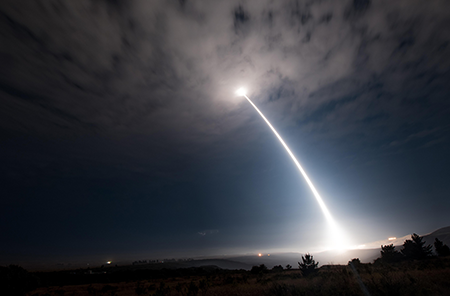
At the same time, their leaders have failed to resolve disputes about existing treaties or launch new negotiations to limit or further cut their deadly arsenals below the New START ceiling of 1,550 deployed nuclear warheads and 700 strategic missiles and bombers each.
In 2018, shortly after he withdrew the United States from the Intermediate-Range Nuclear Forces Treaty, U.S. President Donald Trump foolishly bragged about the nuclear stockpile that “until people come to their senses, we will build it up. It’s a threat to whoever you want, and it includes China, and it includes Russia, and it includes anybody else that wants to play that game.”
China has responded to U.S. nuclear and conventional military plans by pursuing a buildup of its historically “minimal” nuclear force to ensure that it retains an assured “second strike” capability. Russia has continued to develop new types of intermediate range missiles, as well as some new and exotic strategic systems designed to bypass U.S. missile defense capabilities.
Successive presidential administrations and congresses have failed to seriously consider alternatives that would have reduced costs and still maintained a devastating nuclear force.
Now, the cost of the U.S. nuclear modernization program is skyrocketing even further, siphoning resources from other more pressing human needs and national security priorities.
In April, the Congressional Budget Office issued its latest 10-year cost projection of the departments of Defense and Energy plans to operate, sustain, and modernize existing U.S. nuclear forces and purchase new forces: a total of $946 billion in the 2025-2034 period, or about $95 billion per year.
This new estimate is 25 percent, or $190 billion, greater than the last CBO estimate of $756 billion, which covered the 2023-2032 period. Incredibly, the $946 billion estimate does not include all of the likely cost growth of the new Sentinel intercontinental ballistic missile program, which the Pentagon acknowledged in July 2024 would cost 81 percent, or $63 billion, more than the program’s baseline estimate of $78 billion, generated in 2020.
Find Out the Facts & Sign the Petition: Why NMED Should Deny LANL’s Request for Tritium Releases
Why NMED Should Deny LANL’s Request for Tritium Releases
The Los Alamos National Laboratory plans to begin large releases of radioactive tritium gas any time after June 2, 2025. The only roadblock to the Lab’s plans is that it needs a “Temporary Authorization” from the New Mexico Environment Department to do so.
Reasons why NMED should deny LANL’s request are:
- The state Environment Department has a duty to protect the New Mexican As it states, “Our mission is to protect and restore the environment and to foster a healthy and prosperous New Mexico for present and future generations.” 1
- Why the rush? LANL explicitly admits there is no urgency. According to the Lab’s publicly-released “Questions and Answers” in response to “What is the urgency for this project?”
“There is no urgency for this project beyond the broader mission goals to reduce onsite waste liabilities.” 2
-
- In addition, the National Nuclear Security Administration (NNSA) admits that the end time frame for action is 2028, not 2025.3 Therefore, there is time for deliberate consideration.
- Contrary to NMED’s Resource Conservation and Recovery Act permit for LANL, the Lab has not fulfilled its duty to inform the public via NMED of possible alternatives to its planned tritium releases.4 According to Tewa Women United, “LANL has told EPA there are 53 alternatives; that list of alternatives, initially requested in 2022, has not yet been Tewa Women United has repeatedly asked LANL to provide the public with that list.” 5
University of New Mexico to host exhibit on nuclear history, technology, weapons
ALBUQUERQUE, N.M. (KRQE) — A provocative international exhibit will open soon at the University of New Mexico. “the bomb” is an immersive, multi-media installation exploring the history, technology, and threat of nuclear weapons.
By Nicole Sanders, KRQE | April 22, 2025 krqe.com
The installation includes an hour-long film projected on 45 screens conveying the hidden chaos and danger of the nuclear age. The experience is coming to UNM from April 30 to May 30. The full schedule at Zimmerman Library is available below:
- Wednesday, April 30
- Friday, May 2, 2025
- Friday, May 9, 2025
- Friday, May 16, 2025
- Friday, May 23, 2025
- Friday, May 30, 2025
Formal Comments on the Draft Site-Wide Environmental Impact Statement for Continued Operation of the Los Alamos National Laboratory
The National Environmental Policy Act requires the Los Alamos National Laboratory to periodically prepare a new “Site-Wide Environmental Impact Statement (SWEIS) for Continued Operations.”
Please use NukeWatch NM’s recent extensive comments on the Lab’s new draft SWEIS as a resource and citizens’ guide to Lab issues.
Did you know, for example, that:
• LANL’s nuclear weapons production budget has doubled over the last decade?
• The Lab’s so-called cleanup plan is to “cap and cover” some 200,000 cubic yards of radioactive and toxic waste, leaving them permanently buried as a perpetual threat to groundwater?
• There is a planned intentional release of up to 30,000 curies of radioactive tritium gas, all without a public hearing?
Use our lengthy formal comments as a starting point, toolkit or resource for dissecting ongoing and future issues at LANL!
We encourage you to use our comments to ask for follow-up info, either from us here at NukeWatch or from the Lab, and to demand better accountability and transparency! Use as background or briefing material for local and congressional advocacy.
For example:
- Cite or excerpt our comments in future public processes under the National Environmental Policy Act. For example, we are expecting that a nationwide programmatic environmental impact statement for plutonium “pit” bomb core production will be announced soon, the result of a lawsuit in which NukeWatch led.
- Share with those organizing around stopping expanded plutonium pit production and advocating for genuine radioactive and toxic wastes cleanup.
- Learn about LANL’s proposed electrical transmission line across the environmentally and culturally sensitive Caja del Rio and alternatives that were not considered.
- The National Environmental Policy Act itself is under assault by the Trump Administration. We expect environmental justice and climate change issues to be stripped from LANL’s final Site-Wide Environmental Impact Statement. This needs to be resisted!
NukeWatch NM argued that the draft SWEIS should be withdrawn and a new one issued because:
• The NNSA has rigged the draft LANL Site-Wide EIS with three self-serving scenarios:
– Expanded nuclear weapons programs (contradictorily called the “No Action Alternative”).
– Yet more expanded nuclear weapons programs (“Modernized Operations Alternative”).
– Yet far more expanded nuclear weapons programs (“Expanded Operations Alternative”).
• A Reduced Operations Alternative must be included.
• The SWEIS’ fundamental justification for expanded nuclear weapons programs is “deterrence.” But “deterrence” has always included nuclear warfighting capabilities that could end human civilization overnight.
• The SWEIS purports to align with U.S. obligations under the 1970 NonProliferation Treaty. That is demonstrably false.
• Future plutonium pit production is NOT to maintain the safety and reliability of the existing nuclear weapons stockpile. Instead, it is for new-design nuclear weapons that could lower confidence in stockpile reliability and/or prompt a return to testing.
• The SWEIS’ No-Action Alternative violates the National Environmental Policy Act (NEPA).
• The legally required programmatic environmental impact statement on pit production should be completed first, followed by the LANL SWEIS.
• Plutonium pit reuse should be analyzed as a credible alternative to pit production.
• A recent proposal for a data center at LANL is not in the SWEIS. It raises huge issues of future water and electrical use, the appropriateness of commercial interests at a federal lab, and the possible fusion of artificial intelligence and nuclear weapons command and control.
• Recent Executive Orders could strip the final SWEIS of environmental justice and climate change analyses. This must have clarification.
• Planned tritium releases should be fully analyzed.
• The Electrical Power Capacity Upgrade should be analyzed will all credible alternatives.
• The proposed BioSafety Level-3 facility must have its own standalone EIS.
• All Defense Nuclear Facilities Safety Board concerns should be addressed and resolved.
• Genuine comprehensive cleanup should be a preferred alternative.
• A new SWEIS should follow a new overdue Probabilistic Seismic Hazard Analysis.
Nuclear Weapons Issues & The Accelerating Arms Race: April 2025
Nuclear weapons
Air Force Weighs Keeping 1970s-Era Missiles Until 2050
The US Air Force is considering contingency plans that would extend the life of 1970s-era intercontinental ballistic missiles by 11 more years to 2050 if delays continue to plague the new Sentinel models intended to replace them. The current plan is to remove all 400 Minuteman III ICBMs made by Boeing Co. from silos by 2039… The Sentinel was projected last year to be deployed starting in May 2029. The first test flight was once projected for December 2023, but fiscal 2025 budget documents indicated a slip to February 2026.
The estimated cost of the new Sentinel intercontinental ballistic missiles (ICBM), originally at ~$110 billion, is now north of $180 billion. And this is before recognition of the immensity of supplying new command and control communications and recent consideration that its hardened silos may have to be replaced. IMHO it’s a propitious time to argue again for eliminating the land-based ICBM leg of the Triad. After all, one of its stated purposes is to act as a “nuclear sponge” for incoming Russian warheads. The odds of that are not zero and may increase if ICBMs are uploaded with multiple warheads after the New Strategic Arms Reduction Treaty expires in February 2026. More temptation for a preemptive first strike.
Calls to restart nuclear weapons tests stir dismay and debate among scientists
By Emily Conover, Science News | March 27, 2025 sciencenews.org
When the countdown hit zero on September 23, 1992, the desert surface puffed up into the air, as if a giant balloon had inflated it from below.
It wasn’t a balloon. Scientists had exploded a nuclear device hundreds of meters below the Nevada desert, equivalent to thousands of tons of TNT. The ensuing fireball reached pressures and temperatures well beyond those in Earth’s core. Within milliseconds of the detonation, shock waves rammed outward. The rock melted, vaporized and fractured, leaving behind a cavity oozing with liquid radioactive rock that puddled on the cavity’s floor.
As the temperature and pressure abated, rocks collapsed into the cavity. The desert surface slumped, forming a subsidence crater about 3 meters deep and wider than the length of a football field. Unknown to the scientists working on this test, named Divider, it would be the end of the line. Soon after, the United States halted nuclear testing.
Beginning with the first explosive test, known as Trinity, in 1945, more than 2,000 atomic blasts have rattled the globe. Today, that nuclear din has been largely silenced, thanks to the norms set by the Comprehensive Nuclear-Test-Ban Treaty, or CTBT, negotiated in the mid-1990s.
Only one nation — North Korea — has conducted a nuclear test this century. But researchers and policy makers are increasingly grappling with the possibility that the fragile quiet will soon be shattered.
Some in the United States have called for resuming testing, including a former national security adviser to President Donald Trump. Officials in the previous Trump administration considered testing, according to a 2020 Washington Post article. And there may be temptation in coming years. The United States is in the midst of a sweeping, decades-long overhaul of its aging nuclear arsenal…
Nuclear Nightmare: Meet America’s New B61-12 Gravity Bomb
What makes the B61-12 particularly impressive is the bomb’s ability to adjust its destructive yield depending on the operational conditions and demands.
By Stavros Atlamazoglou, National Interest | March 26, 2025 nationalinterest.org
Over the past months, the U.S. Air Force added another potent weapon to its arsenal: a new nuclear bomb, having recently completed production at Sandia National Laboratories in Albuquerque, New Mexico.
The B61-12 nuclear gravity bomb achieved full system production recently and is now fully operational. The nuclear bomb is one of the most versatile munitions of its type in the world, and a useful addition to the U.S. military’s nuclear deterrent capabilities.
The B61-12’s Unique Variable Yield Design
Sandia, one of the three main research and development laboratories for nuclear munitions, completed the production of the B61-12 nuclear gravity bomb. The nuclear munition is now fully operational.
What makes the B61-12 particularly impressive is the bomb’s ability to adjust its destructive yield depending on the operational conditions and demands. Put simply, the B61-12 is four bombs in one. The nuclear munition can be adjusted to four different yields—0.3, 1.5, 10, or 50 kilotons. The difference in yields means that the B61-12 has tactical, operational, and potentially even strategic utility.
Eight decades of nuclear threats are too much
Santa Fe New Mexican: My View John C. Wester
By John Wester, The Santa Fe New Mexican | March 15, 2025 santafenewmexican.com
I am John C. Wester, Archbishop of Santa Fe. I’m speaking on behalf of my archdiocese, and the archbishop of Seattle, the bishop of Hiroshima, and the archbishop of Nagasaki. We take guidance from our Holy Father, Pope Francis, who has declared the very possession of nuclear weapons to be immoral. We pray for his health.
Two years ago, in Nagasaki, on the 78th anniversary of its atomic bombing, we Catholic leaders formally created the Partnership for a World without Nuclear Weapons. Our four dioceses include the birthplace of nuclear weapons, the most deployed weapons in the United States, and the only two cities that to date have suffered atomic bombings. We lend our voices in staunch support of the Treaty on the Prohibition of Nuclear Weapons, at this Third Meeting of State Parties.
In July 2017, the Vatican was the first nation-state to sign and ratify the treaty. We note that the nuclear weapons powers have never honored their long-held obligations, under the 1970 Non-Proliferation Treaty, to enter into serious negotiations leading to global nuclear disarmament.
In contrast, the entry into force of the ban treaty was a great step toward the light of peace. The nuclear armed states have a moral obligation to hear the voices of the majority of the world, and to listen to those who are threatened by annihilation, at the whim of any one of their nine leaders.
The New York Times: DOGE Cuts Reach Key Nuclear Scientists, Bomb Engineers and Safety Experts
“Firings and buyouts hit the top-secret National Nuclear Security Administration amid a major effort to upgrade America’s nuclear arsenal. Critics say it shows the consequences of heedlessly cutting the federal work force.”
“The department has said that most of the fired employees handled administrative and clerical tasks that were not critical to the agency’s operation. But an analysis of the internal documents by The Times, coupled with interviews with 18 current and former agency officials, shows that is not true for the bulk of people who took the buyout,”
By Sharon LaFraniere, Minho Kim and Julie Tate, The New York Times | March 17, 2025 nytimes.com
…The Times reports that many had top-secret security clearance, giving them access to information on how nuclear weapons are made.
North Korea vows to ‘strengthen’ nuclear capabilities, rejecting G7 call for denuclearization
“The G7 called on Friday for North Korea to “abandon” its nuclear program.”
By Kevin Shalvey, ABC News | March 17, 2025 abcnews.go.com
LONDON — North Korea on Monday vowed to “steadily update and strengthen” its nuclear capabilities, a firm rejection of the G7’s call for Pyongyang to “abandon” its nuclear ambitions.
The country’s Foreign Ministry said that its “nuclear armed forces will exist forever as a powerful means of justice which defends the sovereignty of the state, territorial integrity and fundamental interests,” according to the Korean Central News Agency, a state-run media outlet.
How nuclear deterrence in Europe may change
“What does nuclear deterrence look like in Europe now that NATO is unsure whether the U.S. will be a committed partner? NPR speaks with Paul Cormarie, analyst with the Rand Corporation.”
By A Martínez, NPR | March 17, 2025 abcnews.go.com
Russia’s president, Vladimir Putin, says he supports a 30-day ceasefire with Ukraine in theory. But he adds that Ukraine would need to accept further conditions before a deal could be finalized. Now, in the interim, European leaders are discussing ways to discourage future Russian aggression. French President Emmanuel Macron has proposed using France’s nuclear capabilities as a deterrent to Russian threats. But what does nuclear deterrence look like in Europe if NATO is unsure if the U.S. will be a committed partner?
Hanford nuclear site subcontractor, owner to pay $1.1M for COVID loan fraud
“The money was intended to retain and maintain payroll for Hanford site workers assigned to the nuclear reservation in Eastern Washington and also a few Department of Veterans Affairs workers during the COVID-19 pandemic.”
“Within 48 hours of BNL receiving the Paycheck Protection Program loan at least $453,000 had been spent to pay off Stevenson’s personal and family debts, according to an indictment.
That included $100,000 transferred to Stevenson’s father and $48,600 to a family trust, according to court documents.
Much of the rest of the money was used to pay off credit card debt, according to the indictment.
The federal government later forgave the loan, which cleared it from having to be repaid.
BNL and Stevenson later applied for and received another Paycheck Protection Program loan of nearly $820,000.”
By Annette Cary, Tri-City Herald (Kennewick, Wash.) (TNS), The Columbian | March 12, 2025 columbian.com
Mar. 11—A former Hanford nuclear site subcontractor and its owner will pay a total settlement of just over $1.1 million to resolve accusations they defrauded the federal government through a COVID pandemic loan program.
On Wednesday, U.S. Judge Stanley Bastian in Yakima sentenced BNL Technical Services, owned by Wilson Pershing Stevenson III, to pay nearly $494,000 restitution to the federal government, as proposed in a settlement agreement.
That is in addition to $611,000 Stevenson, of Nashville, Tenn., already agreed to pay in a civil settlement to resolve his liability in the case.
Nuclear Watch New Mexico and Santa Fe Archbishop John C. Wester Attend the Third Meeting of States Parties to the Treaty on the Prohibition of Nuclear Weapons
We had the honor of joining the Archbishop of Santa Fe, John Wester, in attending the third Meeting of States Parties to the Treaty on the Prohibition of Nuclear Weapons last week, March 3-7 in New York City. The archbishop gave mass to several different groups (see photos below) and spoke at the UN headquarters as part of Civil Society.
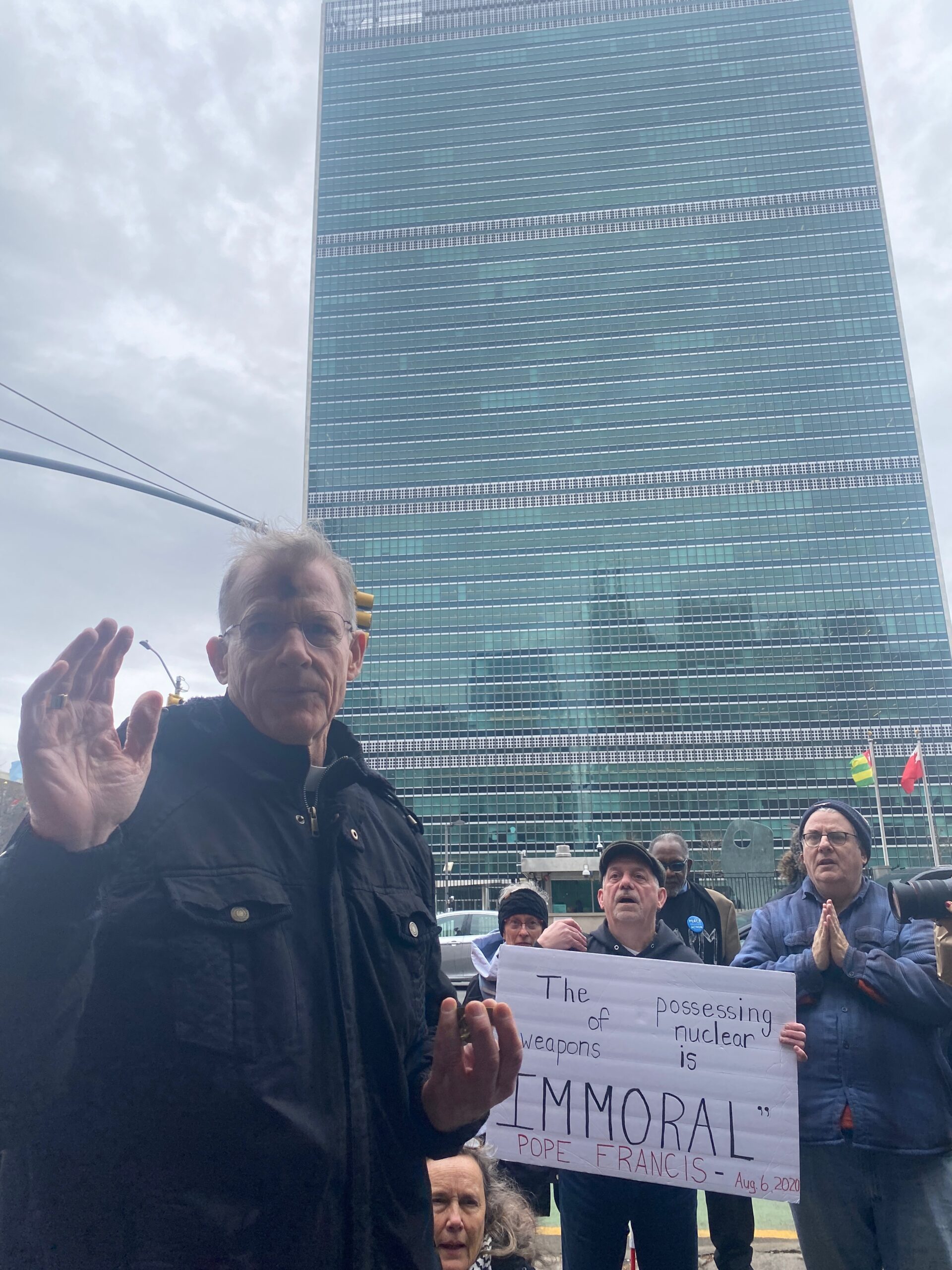

In New York City this week? Join Pax Christi members and friends at Mass with Archbishop John Wester (Santa Fe NM) on Tuesday, March 4, 6 pm, at the Church of Our Saviour, 59 Park Avenue at 38th Street. Use this link to RSVP. #TPNW #3MSP #nucleardisarmamentwww.dorothydayguild.org/WesterMass25
— Pax Christi USA (@paxchristiusa.bsky.social) 2025-03-03T16:35:50.942Z
Germany skips UN conference on banning nuclear weapons in New York
“Germany has decided not to take part in a UN conference in New York to review a landmark treaty on nuclear weapons prohibition.”
By dpa International | March 4, 2025 dpa-international.com
“The Treaty on the Prohibition of Nuclear Weapons dates back to a time before the Russian war of aggression against Ukraine,” the Foreign Office told dpa in Berlin on Tuesday. “The intention and ambition of the treaty no longer reflect the current reality in security policy.”
The treaty was signed in 2017 and came into force in 2021. There are currently 94 signatories and 73 states parties, according to the International Campaign to Abolish Nuclear Weapons (ICAN).
Germany does not possess nuclear weapons but is allied with three nuclear powers in NATO: the United States, France and the United Kingdom.
Berlin is not a signatory to the prohibition treaty, but it participated in previous conferences as observers.
Brief Analysis of Today’s U.S. Supreme Court Oral Arguments on the Illegality of Licensing Radwaste Dumps in TX and NM
Today the United States Supreme Court heard arguments in the case of the Nuclear Regulatory Commission vs. Texas. At issue is whether the NRC exceeded its authority when it approved licenses for proposed “consolidated interim storage facilities” for high-level radioactive waste, and this includes highly irradiated “spent” fuel from nuclear power plants.
Two consolidated interim storage facilities are planned for western Texas and southeastern New Mexico. The Nuclear Waste Policy Act of 1982, as Amended specifically prohibits private “interim” storage of federal spent nuclear fuel, and disallows the Department of Energy from taking title to the waste unless a permanent geologic repository is licensed, built and opened. The law intended to prevent private “interim” storage of federal radioactive waste because interim storage is much less robust than permanent storage, and would double the risk of accident or attack during transport, since consolidated “interim” storage means the waste has to be moved twice, once to the CISF and again to a permanent repository.
Broken arrows: The hidden secret behind America’s missing nuclear weapons
“Dedicated Navy divers, demolition teams, and high-powered sonar spent weeks searching the ocean floor and came up empty.”
By Kaif Shaikh, Interesting Engineering | March 3, 2025 interestingengineering.com
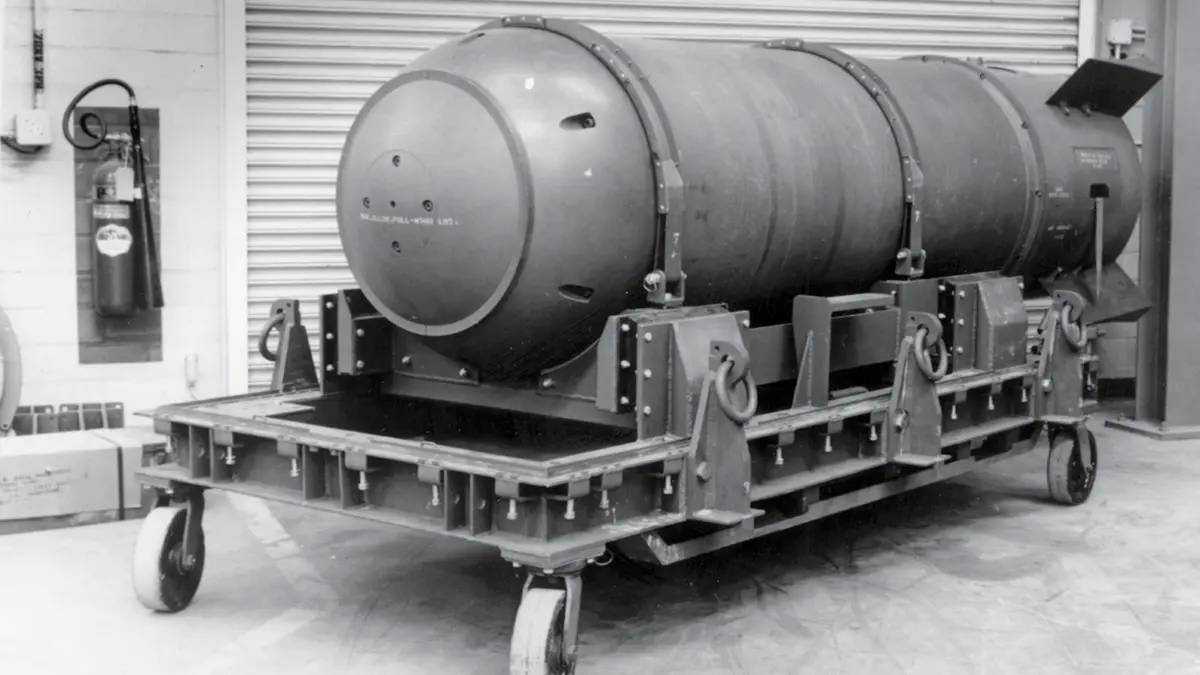
Throughout history, the idea of misplacing a nuclear weapon may sound like a plot twist in an espionage novel. The United States has experienced more than a handful of such incidents. Known as “Broken Arrows,” these events typically refer to any accidents involving nuclear weapons that do not pose an immediate risk of triggering a nuclear war.
For decades, details remained hidden behind top-secret clearances. However, unclassified records reveal that the U.S. military has had a surprising number of mishaps, with some bombs still unaccounted for to this day.
What are broken arrows?
The Department of Defense defines a “Broken Arrow” as any incident involving a U.S. nuclear weapon or warhead that results in accidental launching, firing, detonating, theft, or loss of the weapon. From 1950 to 1980, official sources cite 32 Broken Arrow incidents, but there may have been more, given the secrecy surrounding nuclear matters.
Christie Brinkley: Don’t let the US resume nuclear weapon tests that ended decades ago
“The United States and other nuclear powers are now moving closer to resuming nuclear weapons tests, decades after testing ended. This highly disturbing trend must be halted.”
By Christie Brinkley Special to The Kansas City Star Miami Herald | March 3, 2025 miamiherald.com
Since the atomic age, 2,056 nuclear weapons have been detonated, 528 of them above the ground. The United States and Soviet Union accounted for about 85% of these tests. The explosive power of atmospheric tests equaled 29,000 Hiroshima bombs. Airborne radioactive fallout circled the globe, re-entered the environment through precipitation, and entered human bodies through food and water.
Cold War bomb testing was part of a massive increase in the number of nuclear weapons, which peaked at more than 60,000. After nuclear war was barely avoided during the Cuban missile crisis, public pressure convinced leaders to ban all above-ground tests in 1963 — a treaty that has never been violated.
The test ban treaty was a huge achievement for peace, beginning eased tensions between nuclear nations. It also was a landmark for public health. A study by St. Louis residents and scientists found an enormous buildup of radioactive strontium-90 levels in baby teeth — 63 times higher in children born in 1963 compared to those born in 1950.
LISTEN LIVE TO U.S. SUPREME COURT ORAL ARGUMENTS ON THE ILLEGALITY OF LICENSING RADWASTE DUMPS IN TX AND NM
“The case pits the nuclear industry’s push for CISFs against the interests of fossil fuel companies which object to high-level radioactive waste dumped in their drilling/fracking areas, the state governments of Texas and New Mexico, which have passed laws prohibiting importation of nuclear waste to their states, and cities along the transport routes which object to it being shipped through their jurisdictions. Their amicus briefs in the case are posted here.”
For immediate release
MEDIA ALERT for Wednesday, March 5, 2025
WASHINGTON, D.C.,
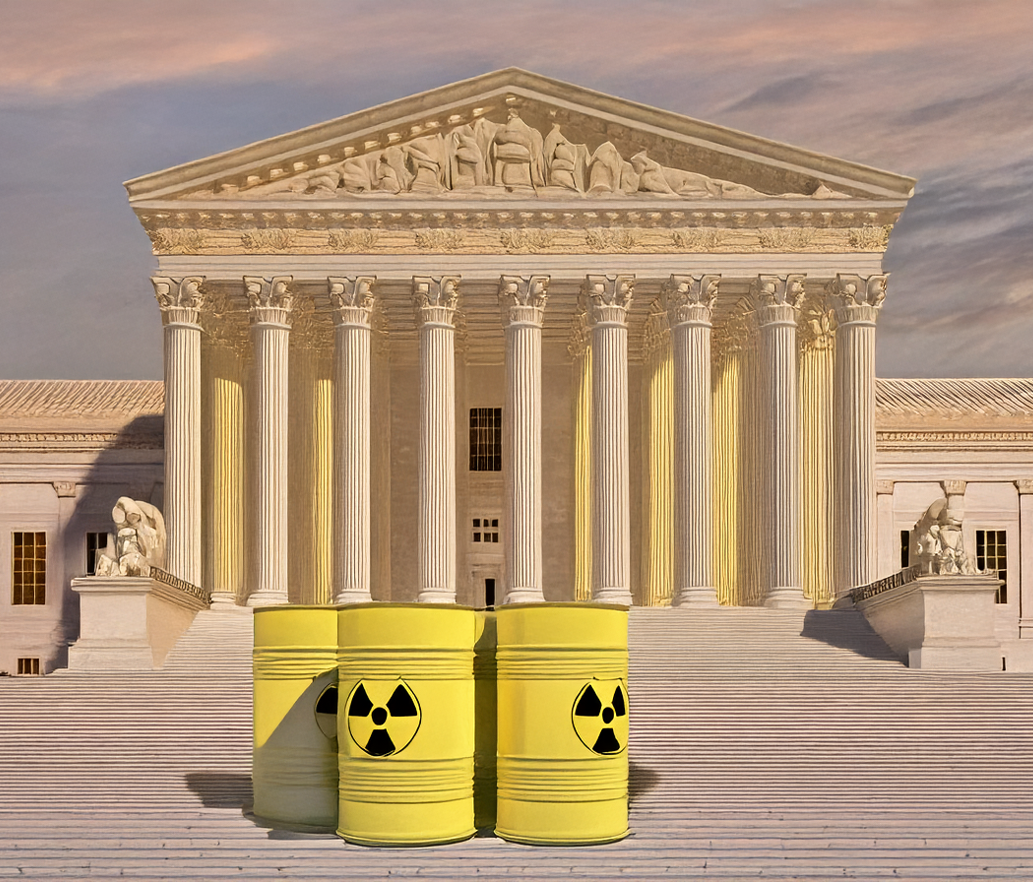 WHAT? Wednesday morning, March 5, the United States Supreme Court will hear oral arguments in Nuclear Regulatory Commission vs. Texas. At issue in the SCOTUS (Supreme Court of the U.S.) proceeding is whether the NRC exceeded its authority when it approved licenses for proposed “consolidated interim storage facilities” for high-level radioactive waste including highly irradiated “spent” fuel from nuclear power plants. Two CISFs are planned for western Texas and southeastern New Mexico. The Nuclear Waste Policy Act of 1982, as Amended specifically prohibits private “interim” storage of federal spent nuclear fuel, and disallows the Department of Energy from taking title to the waste (which would be necessary for DOE to transport it to CISFs), unless and until a permanent geologic repository is licensed, built and opened to receive the waste. The law intended to prevent private “interim” storage of federal radwaste, which is much less robust than permanent storage, and would double the risk of accident or attack during transport, since consolidated “interim” storage necessitates moving the waste twice, once to the CISF and again to a permanent repository. The NRC approved recent CISF license applications despite the law, saying it anticipated Congress would change it in the future. But the federal Fifth Circuit court ruled that the NRC didn’t have that authority. If the Supreme Court strikes that ruling down, it could open the floodgates for thousands of shipments of spent fuel from nuclear power plants across the US, through many states, to CISFs in Texas and New Mexico.
WHAT? Wednesday morning, March 5, the United States Supreme Court will hear oral arguments in Nuclear Regulatory Commission vs. Texas. At issue in the SCOTUS (Supreme Court of the U.S.) proceeding is whether the NRC exceeded its authority when it approved licenses for proposed “consolidated interim storage facilities” for high-level radioactive waste including highly irradiated “spent” fuel from nuclear power plants. Two CISFs are planned for western Texas and southeastern New Mexico. The Nuclear Waste Policy Act of 1982, as Amended specifically prohibits private “interim” storage of federal spent nuclear fuel, and disallows the Department of Energy from taking title to the waste (which would be necessary for DOE to transport it to CISFs), unless and until a permanent geologic repository is licensed, built and opened to receive the waste. The law intended to prevent private “interim” storage of federal radwaste, which is much less robust than permanent storage, and would double the risk of accident or attack during transport, since consolidated “interim” storage necessitates moving the waste twice, once to the CISF and again to a permanent repository. The NRC approved recent CISF license applications despite the law, saying it anticipated Congress would change it in the future. But the federal Fifth Circuit court ruled that the NRC didn’t have that authority. If the Supreme Court strikes that ruling down, it could open the floodgates for thousands of shipments of spent fuel from nuclear power plants across the US, through many states, to CISFs in Texas and New Mexico.
Expanded Plutonium “Pit” Bomb Production is Immoral – Spend Nuclear Weapons “Modernization” Money Ethically ELSEWHERE
Why the nation’s nuclear waste may eventually be headed to northwest Colorado
Nuclear waste is piling up at power plants around the country, and we have no idea where to put it. Many states are aggressively fighting plans for new storage facilities.
But northwest Colorado is quietly opening the door.
By In The NoCo, Scott Franz, Erin O’Toole, Brad Turner | February 22, 2025 kunc.org
KUNC’s investigative reporter Scott Franz recently traveled around rural Colorado talking with people about what nuclear waste storage could do for the local economy – and also interviewing folks who are dead set against that idea.
On this special edition of In The NoCo, we’ve combined all of Scott’s reporting from the past few months into a single episode. You can also see photos and check out more on this investigation.

Arms Control Association – Trump Regains Control Over Nuclear Policy: What’s Next?
It has been barely a month since Inauguration day, but it is apparent that Donald Trump is determined to reshape U.S. foreign policy, radically alter alliance relationships, and upend Washington’s approach toward key adversaries, like Russia, in ways that are not yet clear.
Arms Control Association | February 21, 2025 armscontrol.org
And here at home, Trump’s brash assertion of executive power is putting our nation’s democratic institutions and the rule of domestic law at risk, in part by altering or dismantling key government departments,agencies and functions, all without congressional approval.
All of this makes our mission to provide reliable information and sound policy solutions even more important and difficult.
The Arms Control Association has a clear and focused strategy to reduce the dangers posed by nuclear weapons and other WMD. Many of these priorities are outlined in this ACA-organized January 28 communication to all members of Congress that was endorsed by 16 of our partner organizations and leaders.
Like many others, however, we are still sorting out how to adjust to and contend with the post-Inauguration political dynamics.
But we must and we will, because critical, weapons-related security decisions lie ahead:
- So long as Russia’s assault on Ukraine continues, there is still a heightened risk of nuclear weapons use, and there are narrowing prospects for a deal to maintain limits on the U.S. and Russian nuclear arsenals after New START expires in one year.
- Although Trump has decried exorbitant military expenditures, the authors of Project 2025, the 920-page manifesto crafted by the Heritage Foundation and others, want the United States to spend even more than the current $756 billion ten-year price tag for nuclear modernization in order to increase the size and diversity of the U.S. arsenal. China and Russia are watching and will surely respond to any U.S. nuclear buildup.
- Project 2025 also calls for preparing to resume U.S. nuclear explosive testing for the first time since 1992. Should the United States do so, it would open the door to nuclear testing by other states, unravel the CTBT, and blow apart the global nonproliferation system at a time of increasing nuclear danger.
- Since Trump withdrew from the 2015 Iran nuclear deal, Tehran has expanded its capacity to produce weapons-grade nuclear material and reduced international inspectors’ access. Trump says he wants a nuclear deal; Iran’s president says he wants a nuclear deal. But time is short. Without a deal to scale back tensions and Iran’s nuclear capacity, we could see renewed international sanctions by October, Iranian withdrawal from the NPT, and/or an attempt by Israel to bomb Iran’s nuclear sites.
How exactly the second Trump administration and the new Congress will try to navigate all these nuclear-related challenges ahead is not yet clear — but if Project 2025 becomes the blueprint for U.S. nuclear weapons policy, we are in big trouble.
But, it may also be possible to steer us toward a safer course.
Trump wants to initiate denuclearization talks with Russia and China
On Thursday, President Donald Trump signaled that he wants to engage with Russia and China on denuclearization efforts.
By Erik English, BULLETIN OF ATOMIC SCIENTISTS | February 14, 2025 thebulletin.org
“There’s no reason for us to be building brand new nuclear weapons. We already have so many,” Trump said from the White House.
“You could destroy the world 50 times over, 100 times over. And here we are building new nuclear weapons, and they’re building nuclear weapons, and China’s building nuclear weapons.” The number of nuclear weapons the United States and Russia can have is established by New START, which expires in 2026. Without a new agreement, nuclear states could begin to build up their arsenals for the first time since the Cold War. “Hopefully, there’ll never be a time when we need those weapons,” Trump said. “That’s going to be a very sad day, that’s going to be probably oblivion.”
Share Your Experiences at Los Alamos National Laboratory
The New York Times would like to hear from you about workplace protocols and safety measures at LANL.
By Alicia Inez Guzmán | Alicia Inez Guzmán is reporting on the nuclear industry in New Mexico as part of The Times’s Local Investigations Fellowship – THE NEW YORK TIMES February 11, 2025 nytimes.com
More voices, better journalism. The questionnaire you are reading is just one tool we use to help ensure our work reflects the world we cover. By inviting readers to share their experiences, we get a wide range of views that often lead to a more deeply reported article. We make every effort to contact you before publishing any part of your submission, and your information is secure. Here’s more on how it works and why it’s good for us and you.
The Los Alamos National Laboratory (LANL) has recently embarked on the “new Manhattan Project” — a hiring spree and multibillion dollar expansion to build plutonium bomb cores for nuclear weapons.
The Times is writing about this new mission and how the lab is keeping workers safe, reporting accidents and environmental contamination and making needed upgrades to key facilities, including in Technical Area 55, the heart of bomb core production.
Have you or someone you know worked at TA-55 or another “hot site” and experienced a workplace accident or been exposed to plutonium, beryllium or another radioactive or toxic substance on the job? What safety measures were in place? Were there follow-up health assessments?
Please answer the questions using the form:
LANL Site-Wide EIS Hearings in Santa Fe and Los Alamos Filled with Loud Protest and Vehement Dissent: Nuclear Weapons are IMMORAL
In this Site-Wide EIS we’re given three options: Expanded nuclear weapons programs (hypocritically called the no action alternative), then we’re presented with yet more expanded nuclear weapons programs, and the third alternative is even more expanded nuclear weapons programs. What we really need is a genuine alternative in this Site-Wide, and I hope that citizens will repeatedly bring this up. We need a TRUE ALTERNATIVE in which the US begins to show global leadership towards nuclear disarmament that it promised to in the Non-Proliferation Treaty, and that should be reflected in the sitewide which shows just passive maintenance of the stockpile. We don’t need Pit Production because it’s for NEW designs – NOT to ensure the safety and reliability of the existing stockpile. The US, for our own national security and global security, we need to lead the world towards global nuclear disarmament – and this Site-Wide EIS does the opposite.
The hearings in Santa Fe and Los Alamos on February 11 and February 13, 2025, respectively, both had virtual participation options. The attendees online and in person were equally vehement in protesting the “rigged game” we’re given with this SWEIS and decrying the fact that there is no alternative besides increased nuclear weapons production.
And read an exceprt from the Archbishop of Santa Fe, John Wester’s comments:
“As we all know, we’re in an accelerating new nuclear arms race that’s made even more dangerous because of artificial intelligence, multiple nuclear actors and hypersonic delivery systems. It’s an already scary situation that has become even scarier, and what concerns me is that Los Alamos and Santa Fe play a key role in naturally fostering and promoting this new nuclear arms race – a race which I believe is an affront to all that is good and holy, all from our perspective that God has placed in us to live in harmony with one another. Nuclear weapons pose one of the greatest threats to that harmony. I think it’s important to know what I’m learning more and more about is that expanded plutonium pit production is not simply to maintain the safety and reliability of our existing so-called deterrence. I think it’s important that people are aware that it’s really for new design nuclear weapons for this new particular armed race. I think it’s important that that people recognize that deterrence is not the way to go. In that light, I would say obviously for me is a Catholic Bishop, Pope Francis I think has really changed the whole moral landscape of looking at nuclear weapons. On the 70th anniversary of the Hiroshima atomic bombing, Pope Francis declared that the very possession of nuclear weapons is immoral. As Catholics this was an extremely important shift there. The 1983 United states conference of Catholic Bishops did allow for deterrence – it was promoting disarmament but made caveats for deterrence. But Pope Francis has taken that off the table in saying that even possessing nuclear weapons is immoral, it’s unethical. One of the main reasons for this church’s shift on this was that the nuclear weapons powers really have failed in their pledge in 1970 when they joined the Non-Proliferation Treaty. The TPNW came about because of that failure, and so it seems to me then based on what Pope Francis said, that if possessing nuclear weapons is immoral, then expanding plutonium pit cores and modernizing our weapons systems in order to be more involved in the new nuclear arms race is also immoral. This policy is unethical. Now I want to be careful here, I am not saying that anyone working at Los Alamos or Sandia or Lawrence Livermore in California, I’m not judging them or saying there are immoral – that’s a different matter in one’s conscience. I’m saying that the policy is involved and the Pope said that nuclear weapons themselves are intrinsically immoral. I think that’s an important thing to keep in mind, that that we need to be moving toward disarmament and that if we’re not, if that’s not our trajectory, rather if it’s just to build up our defenses, then that’s an immoral buildup.”
Gearing Up for the Public Hearings on the LANL Draft Sitewide Environmental Impact Statement: Pit Production at LANL
“Nuclear Watch New Mexico hosted a workshop on February 6 on the newly released Draft Sitewide Environmental Impact Statement (SWEIS) for Los Alamos National Laboratory (LANL) to present information and elicit discussion on this NEPA process that Jay Coghlan, executive director of Nuke Watch, referred to as a “rigged game” at the beginning of the workshop. What that means will become evident as I review the part of the workshop I attended.”
By Kay Matthews, La Jicarita | February 7, 2025 lajicarita.wordpress.com
Archbishop John Wester, an outspoken critic of nuclear weapons proliferation under the guise of nuclear deterrence instead of disarmament spoke briefly to open the discussion. Quoting Pope Francis, he said, “possessing nuclear weapons is immoral.” He then said, “Pit production is immoral.” His only qualification is that it’s the policy that’s immoral, not the people who promote it. We’ve failed to uphold already existing treaties and failed to implement new ones. He’ll be going to the United Nations in March for a meeting, Treaty on the Non-Proliferation of Nuclear Weapons, and to Japan in August to meet with his partners in the World Without Nuclear Weapons.
Coghlan explained that next week the Department of Energy (DOE) and the semi-autonomous National Nuclear Security Administration (NNSA) will hold public hearings, as required by NEPA, on the LANL SWEIS, in Santa Fe, Española, and Los Alamos. He cautioned that while we should all be “cynical” about the process, we need to go ahead and protest the fact that all three alternatives provided in the SWEIS expand pit production, just at different amounts. The process is rigged because the DOE and NNSA failed to update a 2008 Environmental Impact Statement before pit production began at LANL (the other nuclear facility, the Savannah River Site in South Carolina, is slated to produce 50 pits a year but is completely unprepared for pit production).
The guest speaker was Dylan Spaulding, Senior Scientist for the Union of Concerned Scientists…
NukeWatch Los Alamos Lab Site-Wide EIS Workshop – February 6, 2025
Full Video Recording: NukeWatch Los Alamos Lab Site-Wide EIS Workshop |
NukeWatch Presentation: Los Alamos Lab Site-Wide EIS Workshop |
|---|---|
|
NukeWatch Los Alamos Lab Site-Wide EIS Workshop |
 |
In Memoriam: Ken Mayers
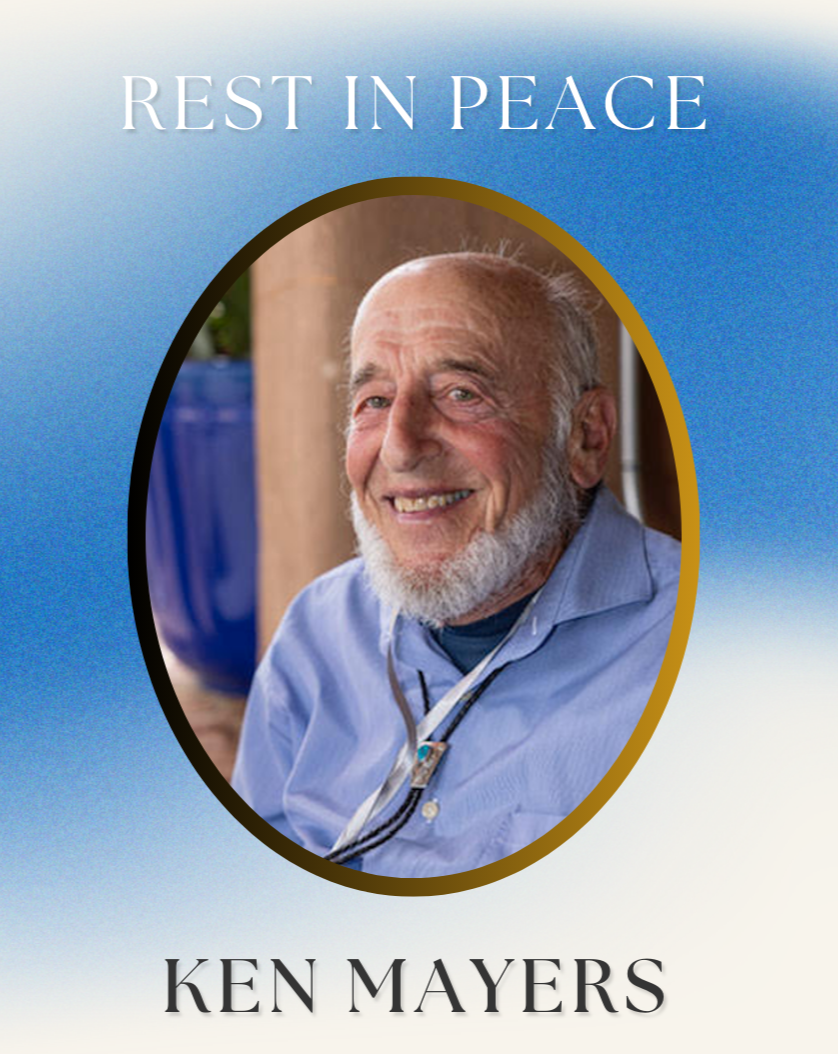 We here at NukeWatch will dearly miss Ken’s weekly presence at the corner vigil to protest Nuclear Weapons in Santa Fe.
We here at NukeWatch will dearly miss Ken’s weekly presence at the corner vigil to protest Nuclear Weapons in Santa Fe.
Locally, Ken was co-founder of the Santa Fe Chapter of Veterans for Peace and an active member of Santa Feans for Justice in Palestine. Ken worked with the local chapter of US Combatants for Peace and the Justice Council of the Unitarian Universalist Congregation in Santa Fe where he was also an enthusiastic baritone and co-founder of the NM Peace Choir.
A Celebration of Ken’s life will be held Friday, April 4 beginning at 12 noon at the corner of Sandoval and West Alameda, (Santa Fe’s weekly vigil to protest Nuclear Weapons), followed by lunch and a hybrid service at the UU Congregation, 107 West Barcelona Street, Santa Fe, NM.
For those wanting to pay tribute to Ken, please consider planting a tree through A Living Tribute (https://shop.alivingtribute.org/) or make a donation in his memory to the Santa Fe Joan Duffy Chapter of Veterans for Peace https://www.vfp-santafe.org/
Ken was a lifelong, passionate defender of peace. Read more:
Nuclear News Archive – 2022
Full Video Recording: NukeWatch and Dr. Michael Ketterer Present Results from Recent Sampling for Plutonium Contamination Around the Los Alamos National Lab
In the Pacific, Outcry Over Japan’s Plan to Release Fukushima Wastewater
“Next year in spring, [Japan] plans to begin releasing the water into the Pacific after treatment for most radioactive particles…”
By Pete McKenzie, NEW YORK TIMES | December 30, 2022 nytimes.com
The proposal has angered many of Japan’s neighbors, particularly those with the most direct experience of unexpected exposure to dangerous levels of radiation.
SANTA FE NEW MEXICAN – OUR VIEW – Getting rid of plutonium pits — so many questions
A Department of Energy proposal to dilute and dispose of plutonium waste at the Waste Isolation Pilot Plant in Carlsbad is ready for public comment — the draft environmental impact statement, all 412 pages of it, has been released.
“Stay alert for notices of meetings and time for public comment. There’s no guarantee informed opposition will change plans by agencies intent on certain action, but speaking up beats staying quiet. Oh, and think about this: before rushing full speed ahead to produce even more plutonium pits, it’s time to at least try to find a way to dispose of the waste we’ve already created.”
[NukeWatch will provide sample comments and make it as easy as possible to participate in the public comment process for the WIPP Permit and Plutonium Waste Disposal plans]
SANTA FE NEW MEXICAN | OUR VIEW December 24, 2022 santafenewmexican.com
The public can weigh in, whether in writing or by showing up for public hearings that will take place early next year.
Buckle up. This is going to be a contentious discussion.
The U.S. wants to be rid of 34 metric tons of plutonium bomb cores, or pits, stored at the Pantex Plant in Amarillo. The pits are Cold War legacies; because WIPP is restricted in the type of waste it can take, before disposing of it, the material must be diluted. Thus, the term, dilute and dispose. The Department of Energy’s decision about the waste was announced two years ago, but with no details.
At one point the Energy Department wanted to turn Cold War plutonium into a mixed oxide fuel for use in commercial nuclear plants. That would have happened at the Savannah River Site in South Carolina, but billions in cost overruns and delays hamstrung the effort, and the Trump administration killed the project in 2018.
It chose the dilute-and-disposal plan.
The draft statement fleshes out just what would happen to prepare the pits for disposal — in a facility, we might point out, that currently is seeking a renewal of its hazardous waste permit from the state of New Mexico. WIPP is open, but state Environment Department Secretary James Kenney and Gov. Michelle Lujan Grisham want more oversight of waste disposal at the plant.
That back and forth is separate from the Energy Department dilute-and-disposal proposal, but the permit discussion provides context for the coming fierce debate.Continue reading
Exposed: The Most Polluted Place in the United States
A new book investigates the toxic legacy of Hanford, the Washington state facility that produced plutonium for nuclear weapons.
“Bechtel is a privately owned corporation and we’re spending billions of dollars paying this company to not get the job done. It’s a big mess.”
By Tara Lohan, The Revelator | December 21, 2022 ecowatch.com

The most polluted place in the United States — perhaps the world — is one most people don’t even know. Hanford Nuclear Site sits in the flat lands of eastern Washington. The facility — one of three sites that made up the government’s covert Manhattan Project — produced plutonium for Fat Man, the atomic bomb dropped on Nagasaki during World War II. And it continued producing plutonium for weapons for decades after the war, helping to fuel the Cold War nuclear arms race.
Today Hanford — home to 56 million gallons of nuclear waste, leaking storage tanks, and contaminated soil — is an environmental disaster and a catastrophe-in-waiting.
It’s “the costliest environmental remediation project the world has ever seen and, arguably, the most contaminated place on the entire planet,” writes journalist Joshua Frank in the new book, Atomic Days: The Untold Story of the Most Toxic Place in America.
It’s also shrouded in secrecy.
Frank has worked to change that, beginning with a series of blockbuster investigations published in Seattle Weekly a decade ago. Atomic Days offers an even fuller picture of the ecological threats posed by Hanford and its failed remediation.
The Revelator spoke with him about the environmental consequences, the botched cleanup operation, and what comes next.
Why is the most polluted place in the country so little known?
We have to understand what it was born out of, which was the Manhattan Project. There were three locations picked — Los Alamos [N.M.], Oak Ridge [Tenn.] and Hanford — to build the nuclear program.
New Mexico Presses US to Develop Other Nuclear Waste Sites
State wants full waste inventory, limits to disposal
WIPP, open since 1999, mining new panels
BLOOMBERG NEWS | December 20, 2022 news.bloomberglaw.com
New Mexico will be “unwavering” in sticking to proposed new conditions on a federal underground nuclear waste repository, a state official said, including one that revokes the facility’s permit should Congress expand its disposal limit.
The state is demanding the Energy Department and its site contractor, Nuclear Waste Partnership LLC, furnish an accurate inventory of all remaining wastes awaiting clean-up and emplacement at the site and an annual report detailing the agency’s progress toward siting another repository in another state.
Clean Energy or Weapons? What the ‘Breakthrough’ in Nuclear Fusion Really Means
 From Tri-Valley CAREs: On NIF, Nuclear Weapons and Fusion Hype
From Tri-Valley CAREs: On NIF, Nuclear Weapons and Fusion Hype

“On December 13, the Department of Energy (DOE) and Livermore Lab held a press conference and, with maximum hoopla, announced that an experiment at the National Ignition Facility earlier that month had achieved fusion “ignition”.
Physicist MV Ramana, who is currently with the University of British Columbia and was previously at Princeton’s Nuclear Futures Laboratory and its Program on Science and Global Security, wrote this article for a science and tech magazine. For more information on what did and did not happen at NIF, we highly recommend it:”
Clean Energy or Weapons? What the ‘Breakthrough’ in Nuclear Fusion Really Means
SCIENCE – THE WIRE | December 19, 2022 science.thewire.in
- On December 13, the US Department of Energy announced that the National Ignition Facility had reached a “milestone”: the achievement of “ignition” in nuclear fusion earlier in the month.
- While the step has been described as a milestone in clean energy, generating electricity commercially or at an industrial scale through fusion is likely unattainable in any realistic sense – at least within the lifetimes of most readers of this article.
- The main utility that the facility offers nuclear weapons designers and planners is by providing a greater understanding of the underlying science and modernizing these weapons.
The Guardian [Letters]: Nuclear fusion ‘holy grail’ is not the answer to our energy prayers
Dr Mark Diesendorf questions the claim that nuclear fusion is safe and clean, while Dr Chris Cragg suspects true fusion power is a long way off. Plus letters from Dick Willis and Martin O’Donovan
“It is great news that scientists have succeeded in getting more energy out of fusion than they put in. It brings to mind a quote from a past director of the Central Electricity Generating Board: ‘One day you may get more energy out of nuclear fusion than you put in, but you will never get more money out than you put in.’” – Martin O’Donovan (Ashtead, Surrey)
THE GUARDIAN: LETTERS | December 19, 2022 theguardian.com
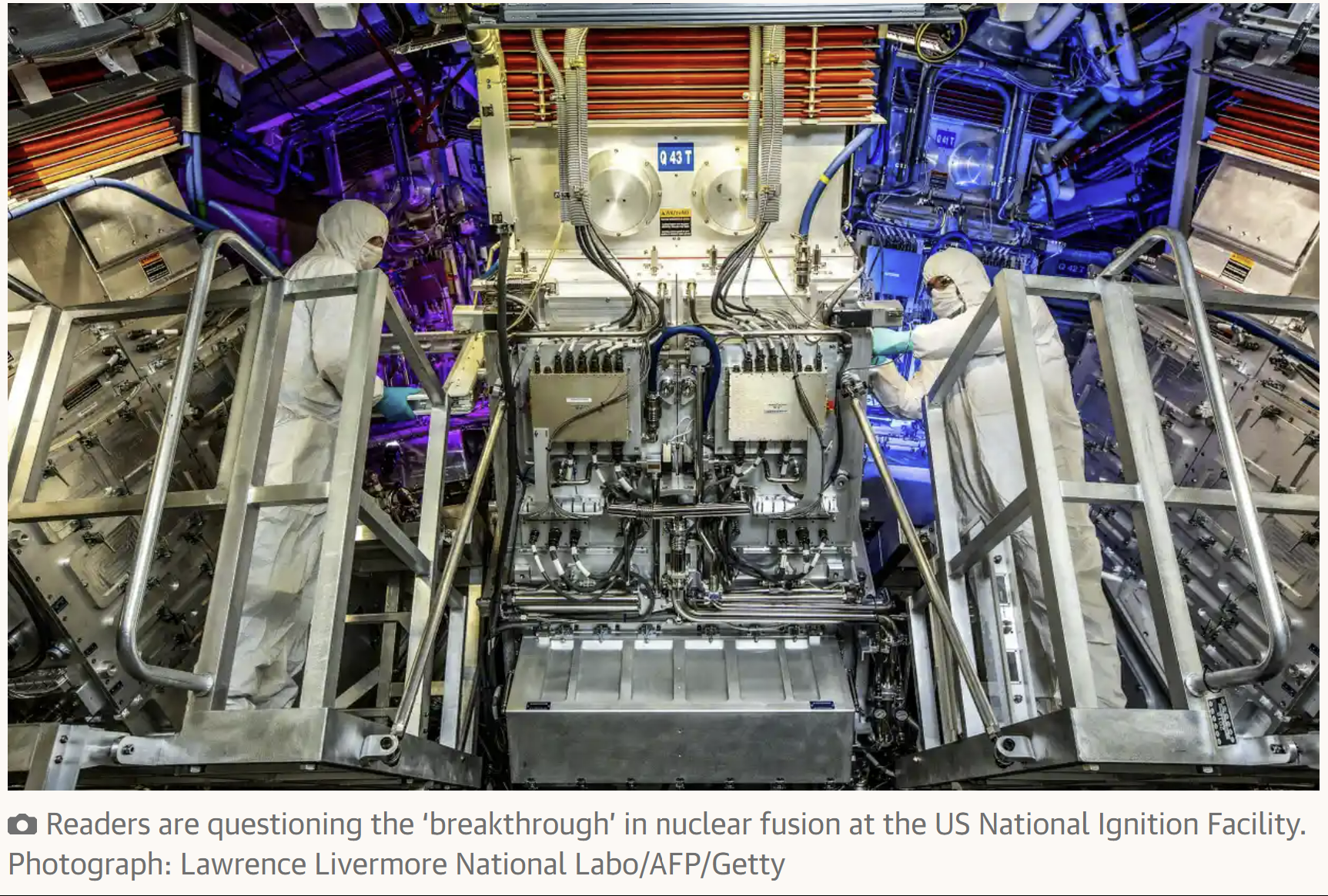
You report on the alleged “breakthrough” on nuclear fusion, in which US researchers claim that break-even has been achieved (Breakthrough in nuclear fusion could mean ‘near-limitless energy’, 12 December). To go from break-even, where energy output is greater than total energy input, to a commercial nuclear fusion reactor could take at least 25 years. By then, the whole world could be powered by safe and clean renewable energy, primarily solar and wind.
The claim by the researchers that nuclear fusion is safe and clean is incorrect. Laser fusion, particularly as a component of a fission-fusion hybrid reactor, can produce neutrons that can be used to produce the nuclear explosives plutonium-239, uranium-235 and uranium-233. It could also produce tritium, a form of heavy hydrogen, which is used to boost the explosive power of a fission explosion, making fission bombs smaller and hence more suitable for use in missile warheads. This information is available in open research literature.
The US National Ignition Facility, which did the research, is part of the Lawrence Livermore National Laboratory, which has a history of involvement with nuclear weaponry.
Dr Mark Diesendorf
University of New South Wales
The Energy Department’s fusion breakthrough: It’s not really about generating electricity
“Because of how the Energy Department presented the breakthrough in a news conference headlined by Energy Secretary Jennifer Granholm, news coverage has largely glossed over its implications for monitoring the country’s nuclear weapons stockpile. Instead, even many serious news outlets focused on the possibility of carbon-free, fusion-powered electricity generation—even though the NIF achievement has, at best, a distant and tangential connection to power production.”
By John Mecklin, THE BULLETIN OF ATOMIC SCIENTISTS | December 16, 2022 thebulletin.org
This week’s headlines have been full of reports about a “major breakthrough” in nuclear fusion technology that, many of those reports misleadingly suggested, augurs a future of abundant clean energy produced by fusion nuclear power plants. To be sure, many of those reports lightly hedged their enthusiasm by noting that (as The Guardian put it) “major hurdles” to a fusion-powered world remain.
Indeed, they do.
The fusion achievement that the US Energy Department announced this week is scientifically significant, but the significance does not relate primarily to electricity generation. Researchers at Lawrence Livermore National Laboratory’s National Ignition Facility, or NIF, focused the facility’s 192 lasers on a target containing a small capsule of deuterium–tritium fuel, compressing it and inducing what is known as ignition.
New trend: long-term investments in the nuclear weapons industry are dropping
The report “Risky Returns” provides an overview of investments in 24 companies heavily involved in the production of nuclear weapons for the arsenals of China, France, India, the Russian Federation, the United Kingdom and the United States in 2022. Overall, the report finds that 306 financial institutions made over $746 billion available to these companies, in loans, underwriting, shares or bonds. US-based Vanguard remains the largest single investor, with $68,180 million invested in the nuclear weapon industry.
By ICAN | December 15, 2022 icanw.org
While the total value of investments in the 24 nuclear weapon producers was higher than previous years, this is also attributed to share price variances through a turbulent year in the defence sector. Some nuclear weapon producers also produce conventional weapons and saw their stock values rise, likely resulting from the announcements by NATO states that they would significantly increase defence spending. Yet the report found no increase in the number of investors in the nuclear weapon producers.
Atomic Days: The Untold Story of the Most Toxic Place in America
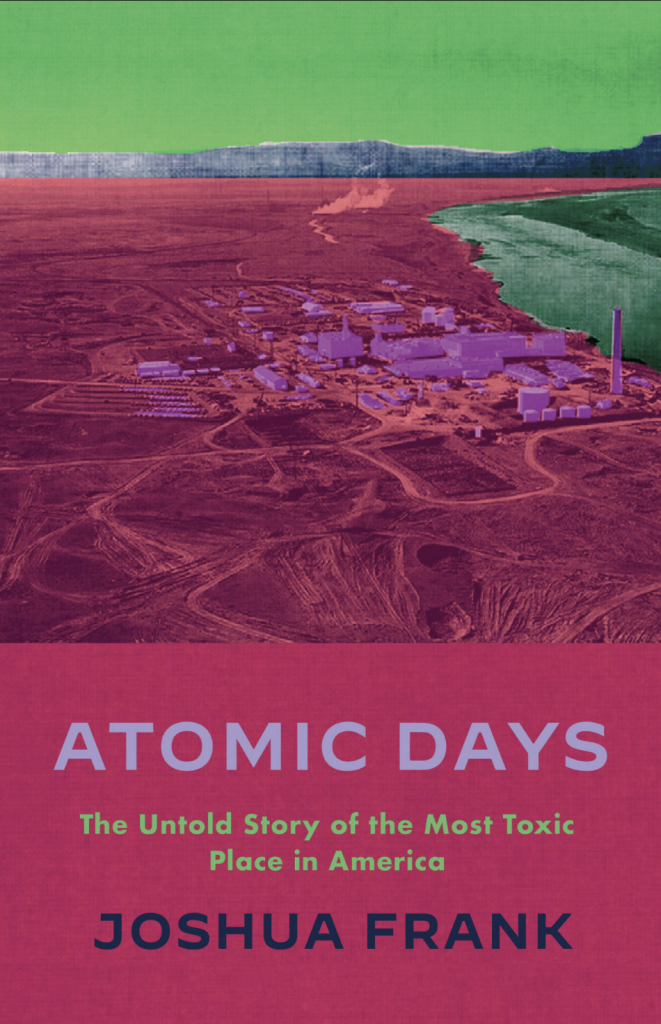
A new book is out about Hanford, by Joshua Frank, co-editor of Counterpunch, Atomic Days: The Untold Story of the Most Toxic Place in America.
Once home to the United States’s largest plutonium production site, the Hanford Nuclear Reservation in Washington state is laced with 56 million gallons of radioactive waste. The threat of an explosive accident at Hanford is all too real—an event that could be more catastrophic than Chernobyl.
Continue reading
Fallout from a nuclear past: A new book explores the human toll of “nuclear colonization” in New Mexico
Of the three waves of colonization New Mexico has undergone — Spanish, American and nuclear — the latter is the least explored. And for author Myrriah Gómez, there were personal reasons to reveal the truth about how “nuclear colonization” has altered the state’s past and continues to shape its future.
By Alicia Inez Guzmán Searchlight New Mexico | December 2022 searchlightnm.org
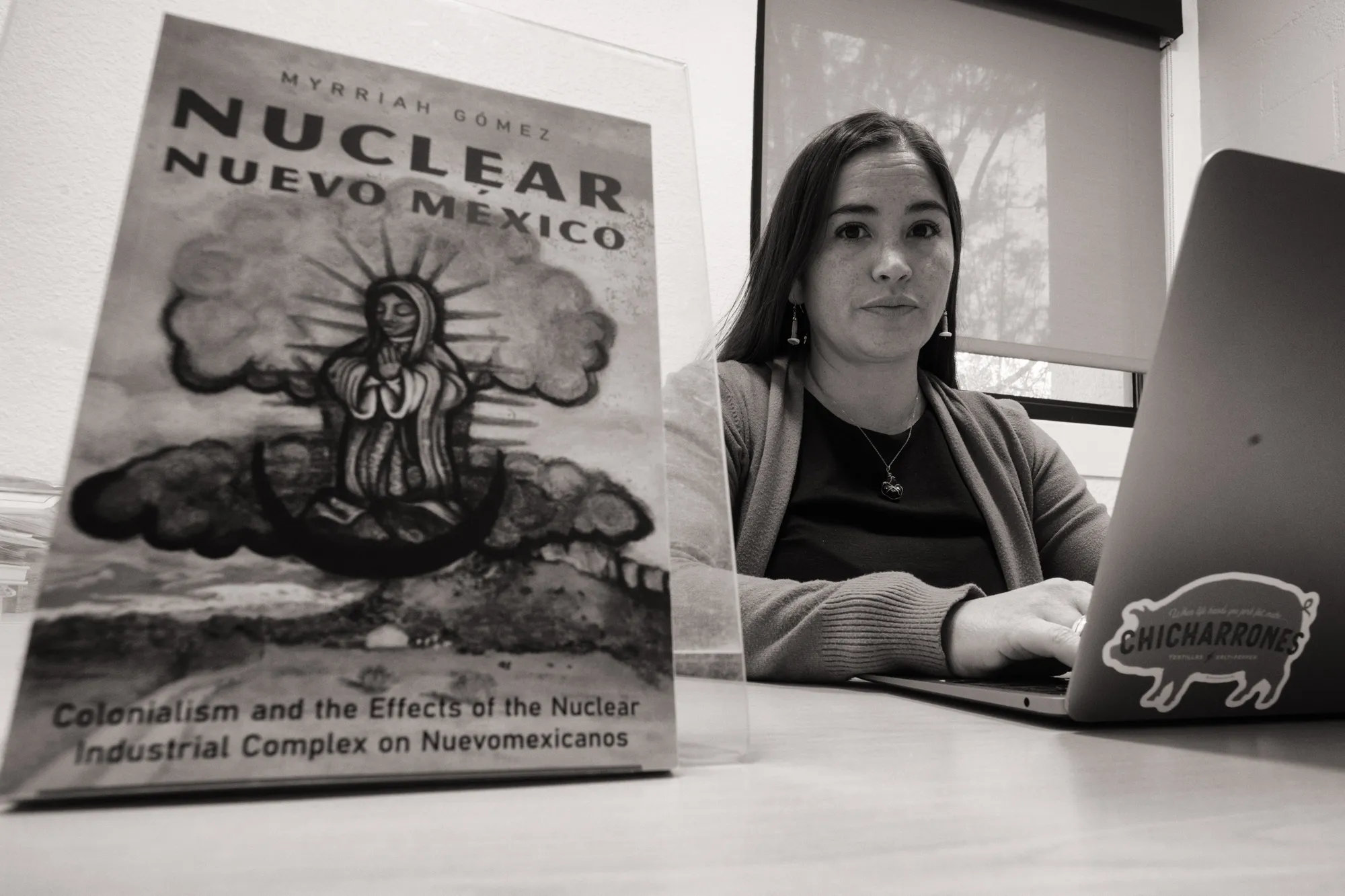 Gómez, an assistant professor at the University of New Mexico, is the author of “Nuclear Nuevo México,” a book that explores the history of the Los Alamos National Laboratory and the fundamental tension of living in its shadow. Its publication this month by the University of Arizona Press couldn’t be timelier: Los Alamos is currently preparing to build plutonium “pits” that act as triggers in nuclear weapons, putting the lab front and center in an ongoing national debate about nuclear impacts.
Gómez, an assistant professor at the University of New Mexico, is the author of “Nuclear Nuevo México,” a book that explores the history of the Los Alamos National Laboratory and the fundamental tension of living in its shadow. Its publication this month by the University of Arizona Press couldn’t be timelier: Los Alamos is currently preparing to build plutonium “pits” that act as triggers in nuclear weapons, putting the lab front and center in an ongoing national debate about nuclear impacts.
“If Spanish colonialism brought Spanish colonizers and U.S. colonialism brought American colonizers,” as Gómez writes in her book, “then nuclear colonialism brought nuclear colonizers, scientists, military personnel, atomic bomb testing, and nuclear waste among them.”
Ukraine still fears another Chernobyl-size disaster at Europe’s largest nuclear plant
“Why did they say it was safe to go outdoors? Why did they build it so close to Kyiv?…Why was it all such a secret?” – Yuriy Samoilenko, chief environmental inspector at Kyiv’s city hall at the time of the Chernobyl meltdown.
By JULIAN HAYDA, NPR | December 11, 2022 npr.org
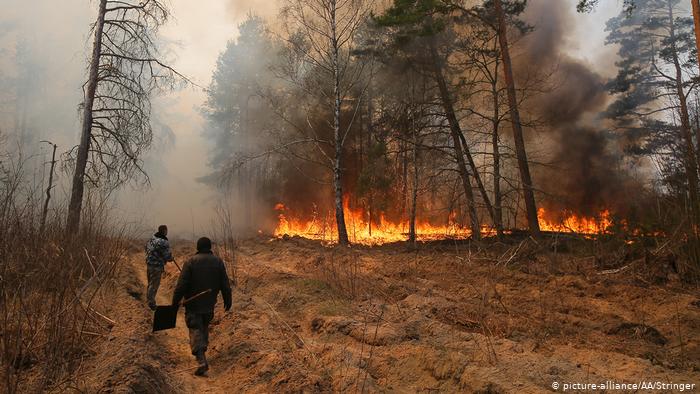
CHERNOBYL, Ukraine — Sophia Arkadiyivna remembers when the Soviet Union built the Chernobyl Nuclear Power Plant in 1977, just 20 miles from the village where she served as mayor.
After years of atomic energy powering big Russian cities like Moscow, Leningrad and Voronezh, the USSR was finally ready to expand the technology to other Soviet republics like Ukraine. Soviet propaganda promised easier jobs and cleaner air.
“We didn’t have a reason to distrust the government. They showed us how good things could be,” she says.
Or so she thought at the time. It didn’t take long for Arkadiyivna to turn skeptical.
Nuclear waste permit ‘more stringent’ New Mexico says as feds look to renew for 10 years
NMED Cabinet Secretary James Kenney said the State wanted a permit with stronger regulations moving forward, to better protect people and the environment from the impacts of nuclear waste disposal.
“It will be more stringent, full stop,” Kenney said. “The conditions were adding to it are designed to add more accountability to the whole complex that are sending waste to WIPP.”
By Adrian Hedden, Carlsbad Current-Argus | December 10, 2022 currentargus.com
 Tougher rules for a nuclear waste repository near Carlsbad could be on the way as New Mexico officials sought “more stringent” regulations as the federal government sought to renew its permit with the state for the facility.
Tougher rules for a nuclear waste repository near Carlsbad could be on the way as New Mexico officials sought “more stringent” regulations as the federal government sought to renew its permit with the state for the facility.
The State sought new requirements to prioritize nuclear waste from within New Mexico for disposal, called for an accounting of all of the waste planned for disposal in the next decade and regular updates on federal efforts to find the location for a new repository as conditions of the permit.
The Waste Isolation Pilot Plant is owned by the U.S. Department of Energy which holds a permit with the New Mexico Environment Department (NMED) that must be updated every 10 years.
The facility sees transuranic (TRU) nuclear waste from DOE facilities around the country disposed of via burial in an underground salt formation about 2,000 feet beneath the surface.
The Bizarre Mystery of the Only Armed Nuke America Ever Lost
The lost nuke has never been found—only the pilot’s helmet was recovered, and the government kept it secret for years.
By Matthew Gault, Vice News | 2022 vice.com
In the early days of the Cold War, the United States wanted to make sure it could launch a retaliatory strike against the Soviet Union as quickly as possible if it launched a nuclear strike. The goal was 15 minutes. This was before the advent of submarines that launch ballistic missiles and intercontinental ballistic missile silos. From 1960 until 1968, America maintained that 15-minute ability to pepper the globe with nukes by putting pilots on 24-hour alert. For more than a decade, hundreds of U.S. pilots criss-crossed the planet in planes loaded with nuclear bombs. To keep up with brutal hours, many of the pilots and crew took amphetamine.
As noted in Task & Purpose, the U.S. military had 32 nuclear accidents during the Cold War, and six of the weapons are still unaccounted for. Every story of a Broken Arrow—the military term for a missing nuke—is harrowing, but what happened off the coast of Japan in 1965 was especially frightening.
On December 5, 1965, U.S. Navy Lt. Douglas Webster was supposed take an A-4E Skyhawk loaded with a nuclear bomb into the sky. On the USS Ticonderoga aircraft carrier, stationed in the Philippine Sea about 70 miles from Okinawa, Japan, the crew loaded the weapon onto the vehicle and Webster got into the cockpit. The crew then pushed the plane to an elevator that would bring it up to the flight deck.
Watch a brief YouTube Clip about this event:
Making the Case That Nuclear Weapons Are Immoral: An Interview With Archbishop John C. Wester
If nuclear weapons are ever eliminated, it will be the result of actions big and small at every communal level, from international leaders to civil society.
Arms Control Association | December 2022 armscontrol.org
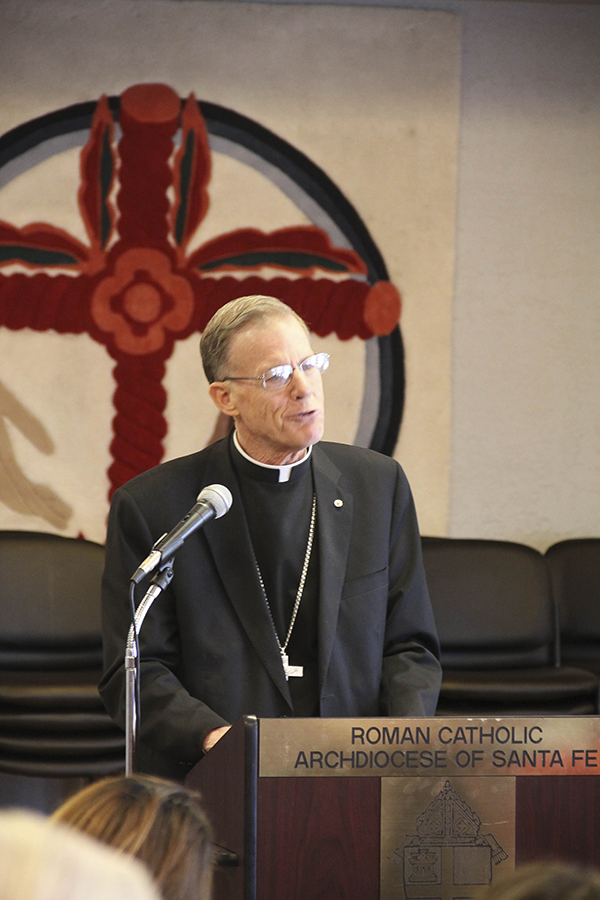
The Reverend John C. Wester occupies a unique role in this continuum as the Roman Catholic archbishop of Santa Fe, whose archdiocese is home to the Los Alamos and Sandia national nuclear laboratories and site of the first Manhattan Project nuclear tests. In January, Wester issued a pastoral letter, “Living in the Light of Christ’s Peace: A Conversation Toward Nuclear Disarmament,” which called for the abolition of nuclear weapons and declared that the archdiocese “must be part of a strong peace initiative.” He had a compelling basis for action: In 2021, Pope Francis shifted the church’s position from accepting deterrence as a legitimate rationale for nuclear weapons to decrying the possession of nuclear weapons as “immoral.” Even with the pope’s admonition, however, Wester is finding his peace initiative slow going. He discussed his efforts with Carol Giacomo, editor of Arms Control Today. This interview has been edited for length and clarity.
ARMS CONTROL TODAY: You often tell the story of visiting Hiroshima and Nagasaki in 2017. It almost seems like an epiphany. How did that trip and other forces, including serving as the top Roman Catholic Church official in Santa Fe, home to Los Alamos and Sandia, propel you to take on the mission of eliminating nuclear weapons?
Archbishop John C. Wester: Until I came here to Santa Fe, I was pretty much like I believe most people are, lulled into a false sense of complacency.
Where Are All the Nuclear Bunkers?
Many of these shelters, which are marked by a characteristic yellow sign, were not specifically designed for such purposes and may not have provided sufficient levels of protection against radiation.
BY ARISTOS GEORGIOU, Newsweek | November 22, 2022 newsweek.com
Since Russia launched its invasion of Ukraine in late February, concerns over the potential use of nuclear weapons have grown. Specially designed bunkers may provide some degree of protection to people in the event of a nuclear attack.
But where are all the nuclear bunkers in the United States and who are they for?
During the Cold War, the U.S. government constructed a number of bunkers around Washington, D.C., and elsewhere that were designed to provide a safe haven for high-ranking members and staff during a nuclear attack on the country.
Nuclear watchdog accuses ex-environment official of conflicting interests after she accepts LANL job
“Jay Coghlan, executive director of Nuclear Watch New Mexico, said there’s a long list of Environment Department officials who went to work for the lab or the agencies that manage it.
He noted Chris Catechis, acting director of the state Resources Protection Division, is going to work for the lab just weeks after Stringer took a job with the nuclear security agency.”
BY SCOTT WYLAND, THE SANTA FE NEW MEXICAN | November 28, 2022 santafenewmexican.com
A nuclear watchdog group wants a state commission to nullify its decision on a permit for Los Alamos National Laboratory’s radioactive liquid waste treatment facility, arguing the panel’s former chairwoman backed a ruling favorable to the lab while she sought a job with the federal agency that oversees it.
Strong earthquake rattles remote West Texas desert
Many of these shelters, which are marked by a characteristic yellow sign, were not specifically designed for such purposes and may not have provided sufficient levels of protection against radiation
BY ASSOCIATED PRESS TEXAS | November 16, 2022 spectrumlocalnews.com
MENTONE, Texas (AP) — A strong earthquake shook a sparsely populated patch of desert in West Texas on Thursday, causing tremors felt as far away as the Mexican city of Ciudad Juárez. The magnitude 5.3 earthquake struck around 3:30 p.m., according to Jim DeBerry, a meteorologist with the National Weather Service in the West Texas city Midland. He said the strength of the quake means it likely caused damage in the remote oil patch and scrubland, but none had been reported so far.
DeBerry said the epicenter was about 23 miles (37 kilometers) south of Mentone, a tiny community south of the New Mexico state line and 95 miles (153 kilometers) west of Midland.
State Rep. Eddie Morales, Jr., whose district includes Mentone, said he spoke with local authorities and there were no reported injuries. He said via Twitter that state officials will be “inspecting roads, bridges and other infrastructure as a precaution.”
DeBerry said there were reports of people feeling vibrations from the quake 200 miles (515 kilometers) west in the border city of Ciudad Juárez and as far south as Terlingua, a small community near the Rio Grande and Big Bend National Park.
Russia-US nuclear disarmament talks postponed
Officials from the two countries were due to meet in the Egyptian capital of Cairo from November 29 to December 6.
ALJAZEERA | November 28, 2022 aljazeera.com
Nuclear disarmament talks between Russia and the United States set to take place this week have been postponed, according to Moscow’s foreign ministry and the US Embassy.
Officials from the two countries were due to meet in the Egyptian capital of Cairo from November 29 to December 6 to discuss resuming inspections under the New START nuclear arms reduction treaty, which had been suspended in March 2020 due to the COVID-19 pandemic.
After decades as a nuclear powerhouse, France makes its play in offshore wind
EDF says the 480-megawatt Saint-Nazaire Offshore Wind Farm would help to “support the French State’s energy transition goals.”
By Anmar Frangoul | November 25, 2022 cnbc.com
A facility described as “France’s first commercial-scale offshore wind project” is fully operational, multinational utility EDF said this week.
The news represents a significant step forward for the country’s offshore wind sector, with more projects set to come online in the years ahead.
In a statement Wednesday, EDF said the 480-megawatt Saint-Nazaire Offshore Wind Farm would help to “support the French State’s energy transition goals, which include targets to generate 32% of its energy from renewable sources by 2030.” EDF’s majority shareholder is the French state.
Gov. Lujan Grisham demands President Biden block nuclear waste site in southeast New Mexico
Nuclear waste storage in southeast New Mexico drew the ire of Gov. Michelle Lujan Grisham, who called on President Joe Biden via a Wednesday letter to block such a project near Carlsbad and Hobbs for perceived threats to nearby residents and implications of environmental racism.
“New Mexico has grave concerns for the risk this proposed storage site would pose to our citizens and communities, our first responders, our environment, and to New Mexico’s agriculture and natural resource industries,” Lujan Grisham wrote.
CALRSBAD CURRENT ARGUS | By Adrian Hedden, Carlsbad Current-Argus | November 18, 2022 currentargus.com
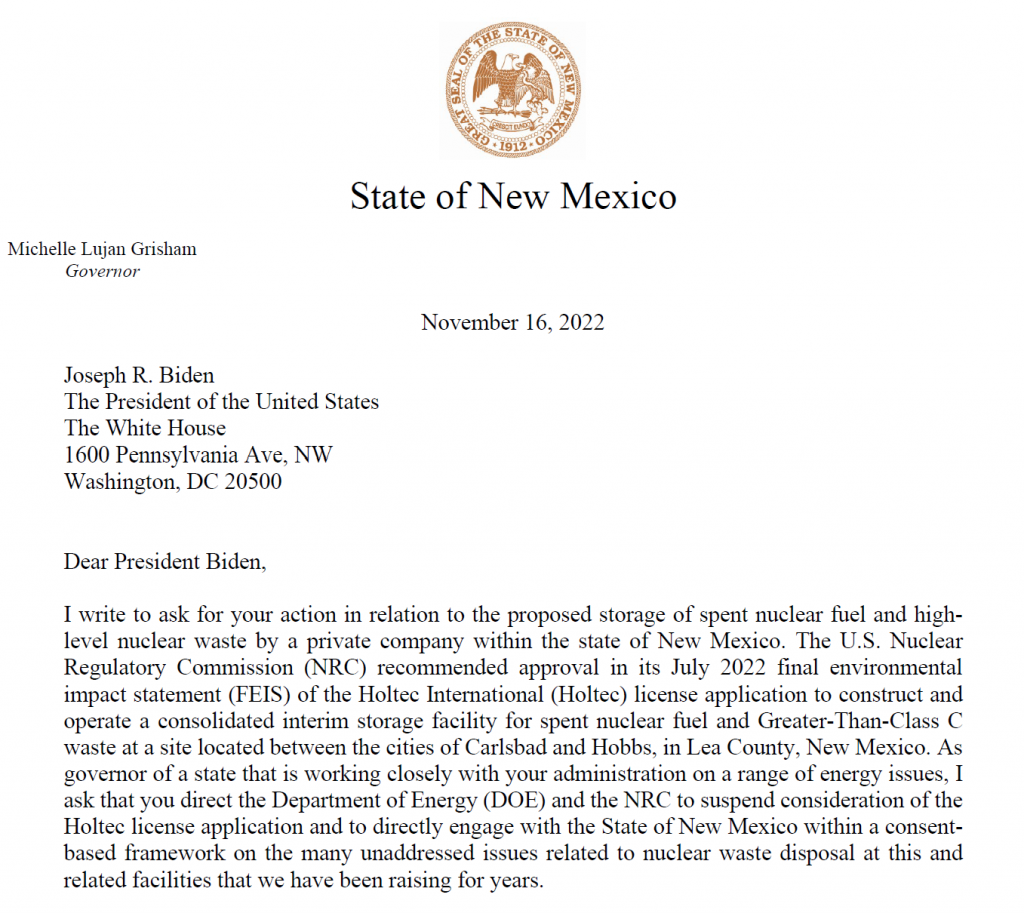 Holtec International proposed the project, which would store up to 100,000 metric tons of spent nuclear fuel rods on the surface in a remote area near the Eddy-Lea county line, after being recruited by a consortium of local leaders in the area known as the Eddy-Lea Energy Alliance.
Holtec International proposed the project, which would store up to 100,000 metric tons of spent nuclear fuel rods on the surface in a remote area near the Eddy-Lea county line, after being recruited by a consortium of local leaders in the area known as the Eddy-Lea Energy Alliance.
The Alliance provided the land, about 1,000 acres amid the oilfields of the Permian Basin, and worked with Holtec to promote the project and seek public support.
But Lujan Grisham, her administration and elected officials both at the state government and in Congress became opposed to the project, frequently voicing their disapproval in the years since.
Russia’s invasion of Ukraine could start a race for nukes, Austin says
The Defense secretary painted a bleak picture for the world, alluding to a scenario in which autocrats will race to acquire the bomb if Russia isn’t repelled.
“Austin further warned that “Putin may resort again to profoundly irresponsible nuclear saber-rattling” as the war drags on and if Ukrainian forces continue their gains against Russian troops.”
POLITICO | By PAUL MCLEARY & ALEXANDER WARD, November 19, 2022 politico.com
HALIFAX, Nova Scotia — Russia’s invasion of Ukraine could entice autocrats around the world to race to develop nuclear weapons, Defense Secretary Lloyd Austin said Saturday, potentially sparking a dangerous era of nuclear proliferation.
Moscow has threatened to use tactical nuclear weapons against Ukraine several times over the past nine months, leading to a flurry of phone calls this month between U.S., European and Russian officials trying to tamp down tensions.
A day before he leaves for a multi-day swing through the Indo-Pacific, Austin painted a bleak picture for the world, alluding to a scenario in which autocrats will race to acquire the bomb if Putin isn’t successfully repelled.
Watchdog agency grills LANL, nuclear officials on lab safety
[NukeWatch would amend this headline to add “‘lightly’ grills” – The DNFSB was asking tough questions, but DOE and the LANL contractors were not forthcoming with those answers.]
“Much of the discussion involved complex, technical subjects. But board Chairwoman Joyce Connery said a basic complaint is the lack of response the board has gotten at times when raising concerns in letters sent to the lab and nuclear security agency.”
THE SANTA FE NEW MEXICAN | By Scott Wyland, November 16, 2022 santafenewmexican.com
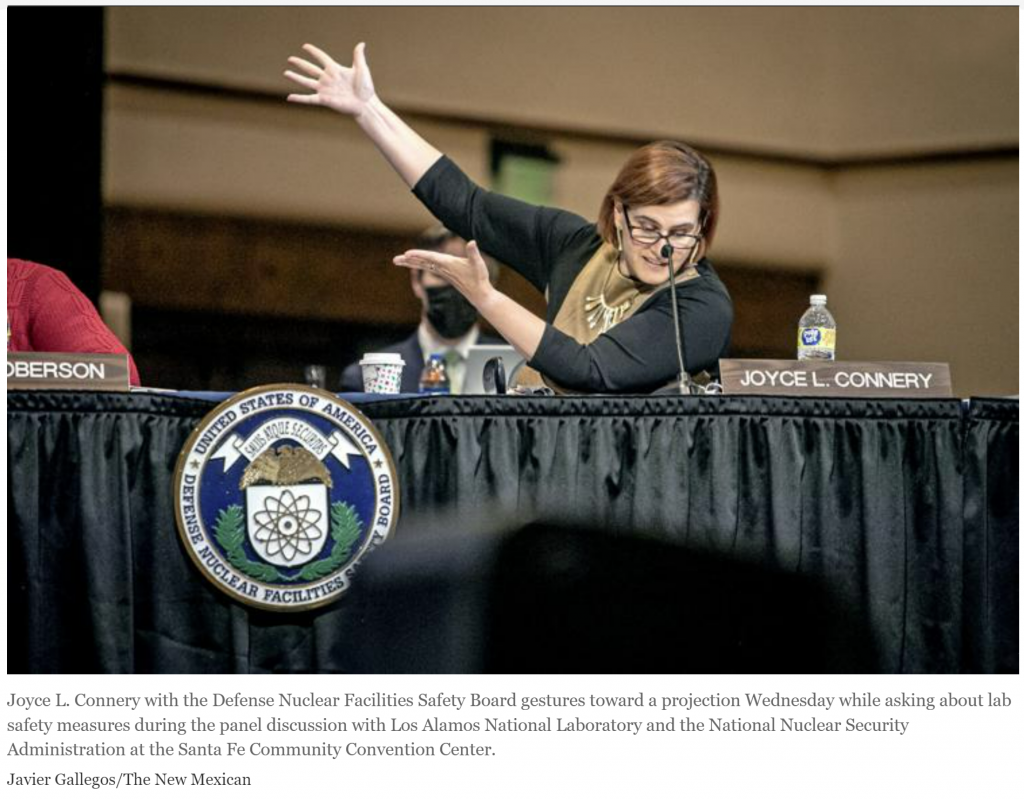
A federal watchdog agency on Wednesday grilled top officials from Los Alamos National Laboratory and the agency that oversees nuclear weapons about ongoing safety concerns and how they aim to resolve them as the lab gears up to produce an unprecedented number of warhead triggers.
The Defense Nuclear Facilities Safety Board, an independent organization within the executive branch, questioned lab Director Thom Mason and National Nuclear Security Administration head Jill Hruby about safety issues that could prove important as the lab moves toward making 30 bomb cores, known as pits, per year by 2026.
The board provides recommendations and advice to the president and the secretary of energy regarding public health and safety issues at Department of Energy defense nuclear facilities.
The daylong hearing was held at the Santa Fe Community Convention Center. It is the first time in several years the safety board has held a public hearing in the Santa Fe area.
Continue reading
A Clear Case of Disqualification of NMED Deputy Cabinet Secretary Stephanie Stringer – Concerned Citizens For Nuclear Safety
The National Nuclear Security Administration (NNSA) has provided evidence to CCNS and Honor Our Pueblo Existence (HOPE) that Stephanie Stringer, a New Mexico Environment Department Deputy Cabinet Secretary and Chair of the New Mexico Water Quality Commission, made adjudicatory decisions against the non-governmental organizations while she was applying for NNSA employment.
CONCERNED CITIZENS FOR NUCLEAR SAFETY | November 17, 2022 nuclearactive.com
![]() This is the second time NNSA has hired an adjudicatory decision-maker during an ongoing proceeding addressing the groundwater discharge permit, DP-1132, for the Radioactive Liquid Waste Treatment Facility at Los Alamos National Laboratory. http://nuclearactive.org/wp-content/uploads/2019/06/190606-CCW-Petition-for-Mandamus-2019-06-06.pdf , see ¶¶ 14 – 24.
This is the second time NNSA has hired an adjudicatory decision-maker during an ongoing proceeding addressing the groundwater discharge permit, DP-1132, for the Radioactive Liquid Waste Treatment Facility at Los Alamos National Laboratory. http://nuclearactive.org/wp-content/uploads/2019/06/190606-CCW-Petition-for-Mandamus-2019-06-06.pdf , see ¶¶ 14 – 24.
This time, Stephanie Stringer, after applying for the NNSA job, demonstrated her bias by not recusing herself from the matter. She voted against the NGOs in the requested permit review before the Water Quality Control Commission.
New study reveals ‘shocking’ number of deaths in southern Ohio county
“PORTS is a massive complex that dominates the landscape in Pike County and, for people in the communities that surround it, so do cancer and death.”
OHIO, LOCAL12 NEWS | By DUANE POHLMAN, WKRC | November 16, 2022 local12.com
ANOTHER SOMBER MOMENT IN THE CEMETERY
PIKE COUNTY, Ohio (WKRC) – On a crisp, sun-drenched day, the shadow of sadness followed Larry Farmer as he made a now-routine somber walk at Mound Cemetery in Piketon, Ohio.
Larry comes there three-to-four times a month to visit his son.
“I come in here and talk to Zach,” Larry said, at a spot overlooking a tombstone with etched pictures of his son smiling in his baseball uniform.
AN ALL-AMERICAN STORY
Zach Farmer was an All-American baseball pitcher at Piketon High School and rising start at Ohio State, when his dreams of making it to the big leagues were cut down by acute myeloid leukemia.
He died in 2015, just eight days after he turned 21.
“You’re never going to find peace,” Larry said as he recalled the pain of losing his son.
Watch: DNFSB Hearing on “Legacy cleanup activities, nuclear safety, and increased production activities” at Los Alamos National Laboratory (LANL)
Russia and US to hold first nuclear talks since Ukraine war
“While the U.S. has cut off most contacts with Russia over the invasion, some channels remain. In Moscow, officials have called for a resumption of broader strategic dialogue, including on a possible successor treaty to New START. The U.S. has said that’s not possible until the inspections resume.”
PONCA CITY NEWS | November 12, 2022 poncacitynews.com
 Russia said it will hold talks with the U.S. from late November to early December in Cairo about inspections of atomic weapons sites under the New START treaty, a first step toward reviving broader arms-control talks suspended since the Russian invasion of Ukraine.
Russia said it will hold talks with the U.S. from late November to early December in Cairo about inspections of atomic weapons sites under the New START treaty, a first step toward reviving broader arms-control talks suspended since the Russian invasion of Ukraine.
The consultations in the Egyptian capital will last about a week, Russian Deputy Foreign Minister Sergei Ryabkov said Friday, according to state news service RIA Novosti.
The Guardian – Letters: nuclear power is not the only option (UK Opinions)
THE GUARDIAN | November 13, 2022 theguardian.com

I do not share your enthusiasm for the “good news” that Sizewell C is believed to be safe from Jeremy Hunt’s budgetary cuts (“Britain can’t afford to waver over nuclear power – soon it will be too late”, Editorial). “On a freezing cold, windless, winter’s evening”, Britain’s grid will indeed need an alternative power source to wind or solar, but why is it assumed that only nuclear can provide an alternative base load? And at the cost of how many billions? And how many decades of lead time?
Geothermal could do the job faster, more safely and cheaply – for about a quarter of the cost. Geothermal power plants operate already in the United States, Italy and Iceland. And nothing is more certain and regular than the tide twice a day; sea turbines already operate in tidal flows off Orkney and Shetland and are another safe source of energy baseload. Let us not be blinkered by nuclear.
Wendy Fowler
Carnac-Rouffiac, France
Sweden to spurn nuclear weapons as NATO member, foreign minister says
Sweden plans to declare nuclear weapons cannot be stationed on its territory when the country joins the NATO military alliance, following in the footsteps of its Nordic neighbors, the Swedish foreign minister told local news agency TT on Friday.
REUTERS | November 11, 2022 reuters.com
Sweden and Finland applied to join NATO earlier this year in a move triggered by Russia’s invasion of Ukraine. So far, the application has been ratified by 28 of NATO’s 30 countries.
Sweden’s supreme commander raised eyebrows this month when he recommended that the government should not insert any red lines in the final negotiations with NATO, such as bans against permanent alliance bases or nuclear weapons on Swedish soil.
However, Foreign Minister Tobias Billstrom said Sweden would join Denmark and Norway in unilaterally declaring that it would not allow nuclear weapons in Sweden.
“It is still the long-term Moderate Party position,” he told TT. “We have never intended to change the conditions for the application submitted by the previous government,” he said.
A Moderate Party-led alliance won the September general election, ending eight years of Social Democratic rule in Sweden.
US warns Australia against joining treaty banning nuclear weapons
“Australia must ‘make sure that we are able to be good nuclear stewards from cradle to grave’.” – Defence Minister of Australia Richard Marles
THE GUARDIAN | Daniel Hurst November 6, 2022 theguardian.com
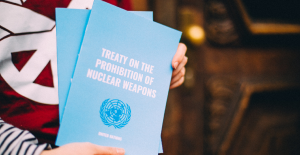 The US has warned Australia against joining a landmark treaty banning nuclear weapons, saying the agreement could hamper defence arrangements between the US and its allies.
The US has warned Australia against joining a landmark treaty banning nuclear weapons, saying the agreement could hamper defence arrangements between the US and its allies.
But New Zealand said it was “pleased to observe a positive shift” in Australia’s position in a United Nations vote and “would, of course, welcome any new ratifications as an important step to achieving a nuclear weapon-free world”.
Sullivan has held talks with Putin aides amid nuclear fears: WSJ
“White House national security adviser Jake Sullivan has held talks with top aides to Russian President Vladimir Putin amid rising tensions between Washington and Moscow in recent weeks, according to the Wall Street Journal.
“After a series of setbacks in Ukraine, Putin has signaled that he was willing to use nuclear weapons to defend Russia, causing Biden to warn of a nuclear ‘Armageddon.’”
THE HILL | BRAD DRESS | November 6, 2022 thehill.com
U.S. officials and allies told the news outlet that Sullivan has been in talks with Yuri Ushakov, a foreign-policy adviser to Putin, as well as Nikolai Patrushev, head of Russia’s security council.
It’s unclear how many times Sullivan has spoken with the officials, but the conversations have been focused on preventing escalation of the war as fears of Russia using nuclear weapons have been rising, according to the Wall Street Journal.
Expanded WIPP mission? No shortcuts
“This “bait and switch” tactic, where WIPP is marketed with one mission in mind, then greatly expanded decades later, contradicts DOE’s professed dedication to a consent-based process that, in their own words, “focuses on the needs and concerns of people and communities.”
This expansion represents such a dramatic change in WIPP’s core mission that its managers must reassess safety issues and negotiate a new social contract with the public before moving forward.”
MY VIEW: Santa Fe New Mexican, By Dennis McQuillan and Rodney Ewing | October 29, 2022 santafenewmexican.com
 The U.S. Department of Energy proposes a dramatic expansion of the type and amount of radioactive waste for burial at the Waste Isolation Pilot Plant. In March, community groups rallied outside the state Capitol protesting this planned expansion, and Gov. Michelle Lujan Grisham sent the Department of Energy a letter in April that cited “ongoing frustration among New Mexicans regarding the lack of meaningful and transparent public engagement from the DOE on waste clean-up, shipments, and long-term plans for the WIPP.”
The U.S. Department of Energy proposes a dramatic expansion of the type and amount of radioactive waste for burial at the Waste Isolation Pilot Plant. In March, community groups rallied outside the state Capitol protesting this planned expansion, and Gov. Michelle Lujan Grisham sent the Department of Energy a letter in April that cited “ongoing frustration among New Mexicans regarding the lack of meaningful and transparent public engagement from the DOE on waste clean-up, shipments, and long-term plans for the WIPP.”
While it may seem too late to protest a facility that has operated for decades, citizen activists are right to object, and the governor is right to demand the Department of Energy address the concerns of state citizens.
Nuclear injustice: How Russia’s invasion of Ukraine shows the staggering human cost of deterrence
“Even a “limited” regional nuclear war could kill millions or even billions, disrupt global climate, and lead to mass starvation. Nuclear winter would not stop at the borders of nuclear perpetrator states—the entire global population would bear the costs of catastrophic deterrence failure or accidents.
Complicating the setting, it would most likely be future generations that would have to cope with the devastating consequences, which makes necessary action today appear to be a less pressing concern.
After all, why should today’s decision-makers—particularly in democracies, and nuclear-armed ones at that—care more about future voters than their current electorates?”
THE BULLETIN| Franziska Stärk & Ulrich Kühn October 29, 2022 thebulletin.org
The global nuclear order—built on policies of nuclear deterrence, nonproliferation, and disarmament—is unjust. Russia’s war against Ukraine proves that the distribution of the costs and benefits of nuclear deterrence is particularly discriminatory. The current situation is a painful reminder that nuclear weapons are to global security what fossil fuels are to a green economy: a costly legacy of past generations thwarting justice and sustainability efforts in the long-term.
It is time for nuclear scholars, policy makers, and the general public to (re)politicize the ongoing and future negative effects of this Nuclear Injustice and push for fundamental change in the role of nuclear weapons in the world. They can do so by making Nuclear Injustice front and center at all relevant conferences and actively engaging in the debate about the nuclear lessons learned from the war in Ukraine.
LANL remains key part of U.S. nuclear weapons plan
“Jay Coghlan, executive director of Nuclear Watch New Mexico, said given the reported problems the lab and Savannah River are grappling with, the review might be trying to add “wiggle room” to production goals.
“It’s interesting how vague the Nuclear Posture Review is on both the rate and timing of pit production,” Coghlan said.”
BY SCOTT WYLAND, THE SANTA FE NEW MEXICAN | October 27, 2022 santafenewmexican.com
Los Alamos National Laboratory received only a brief mention in the Biden administration’s much-awaited update of the country’s nuclear strategy, but it’s clear the Pentagon views …
Department of Energy Official Reveals More Delays in Plans for New Plutonium Pit Facility at DOE’s Savannah River Site
“A lawsuit remains before a federal judge in South Carolina in which the plaintiffs – SRS Watch, Nuclear Watch New Mexico (Santa Fe, NM) and Tri-Valley CAREs (Livermore, CA) – have demanded that a programmatic environmental impact statement (PEIS) on pit production be prepared. The PEIS would analyze impacts of pit production at all DOE sites, including heretofore unanalyzed disposal of plutonium by-product waste (transuranic waste) from pit production in the Waste Isolation Pilot Plant (WIPP) in New Mexico.”
By Savannah River Site Watch | October 5, 2022 einpresswire.com
SRS Pit Plant would Fabricate Plutonium Pits (Cores) for New and Old Nuclear Weapons; Schedule Delays, Cost Increases Mounting, with Cost Nearing $12 Billion
Our prediction that the unneeded SRS plutonium pit plant would continue to face significant delays and substantial cost increases is sadly being proven true”
COLUMBIA, SOUTH CAROLINA, US – A facility proposed to make the key plutonium component for new U.S. nuclear warheads faces another substantial delay, according a U.S. Department of Energy official at a nuclear meeting this week in South Carolina. The delay of construction of the Plutonium Bomb Plant, proposed to make plutonium “pits” at the U.S. Department of Energy’s sprawling 310-square-mile Savannah River Site (SRS) near Aiken, SC, could push the price tag to $11.5 billion or higher.
Archbishop renews call for dialogue on ridding world of nuclear weapons
“Congress should have the courage to begin to help lead us toward a future world free of nuclear weapons…In particular, I call upon the New Mexican congressional delegation to end their support for unneeded, exorbitantly expensive plutonium pit production for nuclear weapons. ”
Catholic News Service | October 23, 2022 osvnews.com

ALBUQUERQUE, N.M. (CNS) — The world still has not learned “the essential lesson” of the Cuban Missile Crisis that “the only way to eliminate the nuclear danger is through careful, universal, verifiable steps to eliminate nuclear weapons,” said Archbishop John C. Wester of Santa Fe, New Mexico.
“It is the very nature of these weapons that the possession of any nuclear weapons is an existential danger to all,” he said. “And Pope Francis has been explicitly clear that ‘the possessing of nuclear weapons is immoral.’”
He renewed his call “for dialogue on the existential issue of eliminating nuclear weapons” and said New Mexico’s congressional delegation should help lead this dialogue,” given that the federal government spends billions in the state on weapons production while New Mexico “remains mired at the bottom of numerous socioeconomic indicators.”
Group behind Jana Elementary radioactive study says tipster led them into their investigation
Investigators arrived in St. Louis on Aug. 15, 2022. The study was released in mid-October with the results of radioactive lead found at Jana Elementary School.
Boeing’s Weak Santa Susana Cleanup Triggers Lawsuit
Sweetheart Deal Negotiated Behind Closed Doors Violates CEQA Mandates
PRESS RELEASE
Thursday, October 6, 2022
Contact
Jeff Ruch, PEER, jruch@peer.org (510) 213-7028
Melissa Bumstead, Parents Against Santa Susana Field Lab Santasusanacampaign@gmail.com (818) 233-0642
Denise Duffield, Physicians for Social Responsibility, dduffield@psr-la.org (310) 339-9766
Lawrence Yee lhyee306@gmail.com
Oakland — The Newsom administration’s backroom deal with the Boeing Co. to dramatically weaken cleanup standards at the profoundly polluted Santa Susana Field Laboratory violates the public involvement and transparency requirements of the California Environmental Quality Act (CEQA), charges a lawsuit filed today by community and public health groups. The suit would open the cleanup agreement to public scrutiny and force the state agencies and the Boeing Co. to justify a cleanup methodology that leaves 90% of the contamination onsite.
Filed today in Ventura County Superior Court by Parents Against Santa Susana Field Lab, Physicians for Social Responsibility (LA Chapter), and Public Employees for Environmental Responsibility (PEER), the suit would, if successful, vacate both the cleanup agreement and an accompanying promise to free Boeing from toxic stormwater discharge requirements.
“This suit does not prevent cleanup from beginning immediately but instead aims to ensure it continues until it is fully completed,” stated Pacific PEER Director Jeff Ruch, noting that under a prior Consent Order, the cleanup was supposed to have been completed back in 2017. “This lawsuit is about having this cleanup done right and well beyond the outrageous ‘rip and skip’ deal that Boeing wrangled behind closed doors.”
After repeatedly promising to enforce a 2007 legally binding cleanup agreement with Boeing, the Newsom administration secretly negotiated an 800-page agreement that “supersedes” the prior order by substantially relaxing key cleanup requirements, allowing hundreds of times higher levels of toxic chemicals than previously permitted, and leaving much of the contamination onsite.
Nuclear News Archives – 2021
Full Video Recording: NukeWatch and Dr. Michael Ketterer Present Results from Recent Sampling for Plutonium Contamination Around the Los Alamos National Lab
Will Construction be Delayed on the New Shaft at WIPP?
“The Environment Department “should be equally considerate towards the judicial review process as it was in the administrative permit modification process, to ensure the courts have sufficient time to review objectively the facts and arguments associated with the appeal.” – Steve Zappe, a member of the Environment Department who worked on WIPP for 17 years.”
Concerned Citizens for Nuclear Safety | December 23, 2021
Two appeals have been filed in the New Mexico Court of Appeals to challenge the decision by New Mexico Environment Department Secretary James Kenney to approve the new shaft at the Waste Isolation Pilot Plant (WIPP). Concerned Citizens for Nuclear Safety filed the second appeal on November 29th. On November 9th, Southwest Research and Information Center and Cynthia Weehler had filed the first appeal. Visit: env.nm.gov/opf/docketed-matters/, scroll down to HWB 21-02 – APPEAL: Waste Isolation Pilot Plant: Class 3 Permit Modification Request, “Excavation of a New Shaft and Associated Connecting Drifts.
SRIC and Weehler also asked Secretary Kenney for a stay, that is, a delay, of shaft construction until the Court of Appeals rules on their appeal. On the stay motion, Secretary Kenney can grant, or deny, or take no action. If he does not grant the stay, or if he takes no action by January 10th, a stay motion then could be filed with the Court of Appeals. Visit: env.nm.gov/opf/docketed-matters/ , scroll down to HWB 21-02 –Waste Isolation Pilot Plant: Class 3 Permit Modification Request, “Excavation of a New Shaft and Associated Connecting Drifts.
Unfortunately, key documents are missing, including the SRIC/Weehler Motion for Stay Pending Appeal, the Hearing Officer’s Report and the Secretary’s Final Order.
The stay motion was supported by three affidavits. Cynthia Weehler stated that she purchased her home near U.S. Highway 285 knowing that the WIPP Permit anticipated that shipments to WIPP would end in 2024. Now, the WIPP expansion plan that requires the new shaft “would result in thousands of additional shipments coming near my house for many decades.” She is very concerned that accidents could result in health effects and “such shipments will reduce my property values.”
 Kathleen Wan Povi Sanchez, an Elder from the Tewa Pueblo of San Ildefonso and among the founding mothers of Tewa Women United, stated in her affidavit that an increase in waste transportation near two schools located on New Mexico Highway 502 would endanger the health of Pueblo children in attendance. Further, “The WIPP expansion plan would result in thousands of new shipments using [] Highway 502 for decades transporting plutonium from the Pantex Plant near Amarillo, Texas to [Los Alamos National Laboratory], and from [Los Alamos] to the Savannah River Site, followed by shipments from that site to WIPP.”
Kathleen Wan Povi Sanchez, an Elder from the Tewa Pueblo of San Ildefonso and among the founding mothers of Tewa Women United, stated in her affidavit that an increase in waste transportation near two schools located on New Mexico Highway 502 would endanger the health of Pueblo children in attendance. Further, “The WIPP expansion plan would result in thousands of new shipments using [] Highway 502 for decades transporting plutonium from the Pantex Plant near Amarillo, Texas to [Los Alamos National Laboratory], and from [Los Alamos] to the Savannah River Site, followed by shipments from that site to WIPP.”
Some LANL plutonium stored in vulnerable containers
An anti-nuclear group said this type of plutonium isn’t explosive but would be hazardous to breathe.
It’s possible the lab made this type of plutonium a lesser priority while ramping up pit production, and now it plans to take big shipments, said Scott Kovac, research and operations director for the nonprofit Nuclear Watch New Mexico.
“That’s a huge amount to accept,” Kovac said. “Now they’re asking NNSA to say that’s OK.”
BY SCOTT WYLAND, THE SANTA FE NEW MEXICAN | December 23, 2021 santafenewmexican.com
Los Alamos National Laboratory wants to store high heat-emitting plutonium in uncertified containers that, if breached in a fire or an earthquake, could expose workers and the public to hazardous doses of radiation, according to a government watchdog’s report.
The lab’s primary contractor seeks a waiver to store large quantities of plutonium-238 in unapproved containers that, if breached, could expose the public to 83 to 378 rem, the Defense Nuclear Facilities Safety Board said in a December report, referring to the unit that measures radiation absorbed in living tissue.
US Still Doesn’t Know How and Where It Will Store Its Growing Pile of Nuclear Waste
The estimated cost of handling the degrading radioactive material is rising steadily — $512 billion at last count.
“DoE is now running up against a statutory limit for how much waste it can store in the space, so it recently changed its counting method to exclude space between storage drums as storage space. New Mexico regulators approved the change but the matter is being challenged in court.
“They knocked a third out of it with a slight of hand. That will allow them a lot more waste,” complains Scott Kovac, operations & research director of Nuclear Watch New Mexico (NWNM), a local anti-nuclear group.”
BY CHARLES PEKOW, EARTH ISLAND JOURNAL | December 23, 2021 earthisland.org
A nuclear watchdog group wants a state commission to nullify its decision on a permit for Los Alamos National Laboratory’s radioactive liquid waste treatment facility, arguing the panel’s former chairwoman backed a ruling favorable to the lab while she sought a job with the federal agency that oversees it.
U.S. Urges Japan Not to Join Nuclear Ban Treaty Meeting
“Germany’s move [planning to to attend the meeting as an observer] has put Japan — which has stated it aspires to a world free of nuclear weapons as the only country to have suffered the devastation of atomic bombings — in the spotlight. Both countries are key U.S. allies that rely on American nuclear forces for protection.”
© KYODO NEWS | December 20, 2021
The United States has urged Japan not to attend as an observer the first meeting of signatories to a U.N. treaty banning nuclear weapons, according to U.S. government sources, reflecting Washington’s opposition to the pact.
The Japanese government has suggested it will come into line with the United States and take a cautious approach to the issue, the sources said. Prime Minister Fumio Kishida told a parliamentary committee on Thursday that Tokyo has no “concrete plans” to attend the meeting as an observer.
The sources said the U.S. administration of President Joe Biden made the request to Japan through diplomatic channels after German political parties announced Nov. 24 that the deal for the new ruling coalition included taking part as an observer at the meeting scheduled for March in Vienna.
Maybe because of the request, Kishida also suggested last week that participation in the meeting would be premature “before building a relationship of trust with President Biden.”
Archbishop calls for nuclear disarming
At least 125 people were present for the service, many bearing roses in honor of the Lady of Guadalupe. Among them was Karen Weber, who said it’s “highly symbolic” for Wester to speak out on the “abolishment of nuclear weapons.”
SANTA FE NEW MEXICAN By Robert Nott rnott@sfnewmexican.com
Looking up at the sky as a young teen one day in Daly City, Calif., Archbishop John C. Wester had one thought as he saw military planes overheard.
Were they ours, or were they Russian planes?
The year was 1962, perhaps the first time nuclear war between the two superpowers seemed likely to erupt as the Cuban Missile Crisis played out and students were taught to prepare for an atomic attack by diving under their desks at schools.
“I don’t think going under our desks was very helpful,” Wester said Sunday in Santa Fe, moments before issuing a call for the world to rid itself its nuclear weapons.
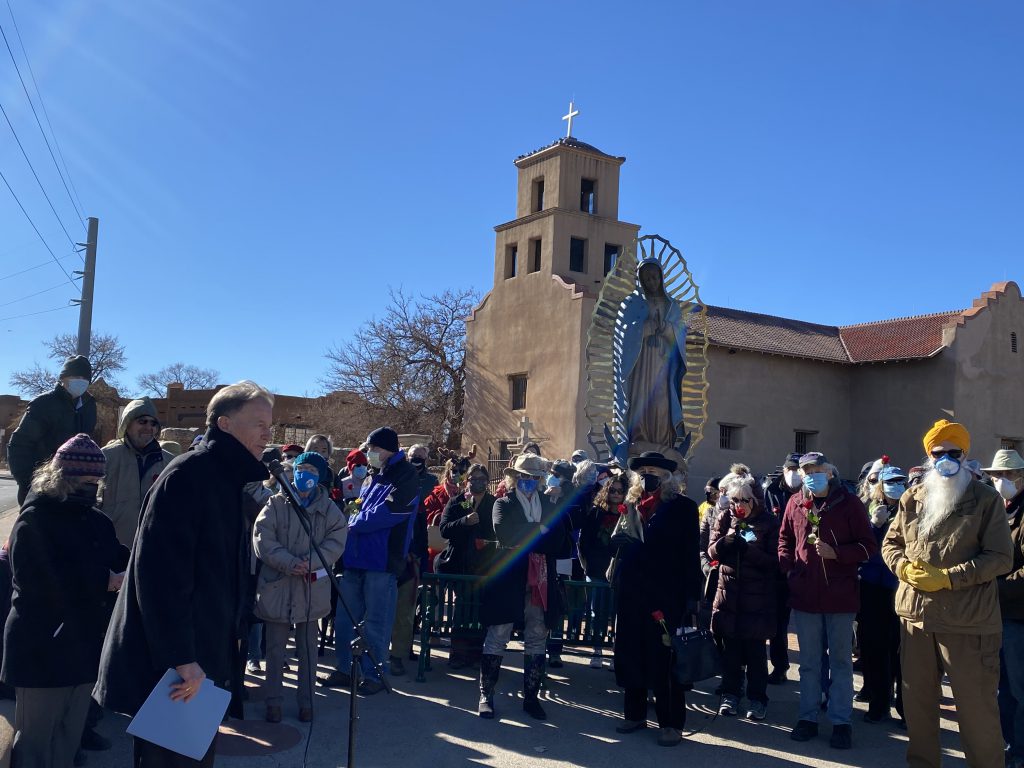
Now, some 60 years later, he said he wants to do more to end the threat of an atomic war. Wester spoke and prayed during a 30-minute prayer service and ceremony at the Shrine of Our Lady of Guadalupe before he unveiled a sign bearing an image of Pope Francis and a quote uttered by the pope in Hiroshima in 2020: “The possession of nuclear arms is immoral.”
Wester said “our archdiocese needs to be facilitating, encouraging an ongoing conversation” about nuclear disarmament.
Why Los Alamos lab is working on the tricky task of creating new plutonium cores
“While the labs work on relearning high-stakes industrial techniques for terrifying weapons, it is estimated that most of the existing warheads will remain fully functional for at least 100 years after first manufacture. Given an arsenal of hundreds of deployed warheads, the stakes of failure to modernize are that, in the event of the worst war humanity has ever known, some warheads might fail to detonate, letting millions live.”
BY KELSEY D. ATHERTON | POPULAR SCIENCE popsci.com December 18, 2021

Plutonium pits, the potent hearts of modern nuclear weapons, degrade over time. As these cores decay, so too does the certainty that they will work as designed when detonated. Los Alamos National Laboratory, the organization that grew out of the Manhattan Project to design and equip the nuclear arsenal of the Cold War, is advancing towards its goal of manufacturing 30 new plutonium pits to go inside nuclear bomb cores by 2026.
The project is both a specific manufacturing challenge, and an opening for the United States to newly consider how many warheads it needs on hand to achieve its stated strategic objectives.
Inside a nuclear warhead, a plutonium pit is crucial to setting off the sequence of reactions that make a thermonuclear explosion. Inside the pit is a gas, like deuterium/tritium, and around the pit is chemical explosive. When the chemical explosive detonates, it compacts the plutonium around the gas until the core is dense enough to trigger a fission reaction. What makes a warhead thermonuclear, as opposed to just atomic, is that this is combined in the same warhead with a uranium core, which creates a fusion explosion.
Hundreds of Scientists Ask Biden to Cut the U.S. Nuclear Arsenal
The letter argued that “by making clear that the United States will never start a nuclear war, it reduces the likelihood that a conflict or crisis will escalate to nuclear war.” And it would demonstrate, they argued, that the United States was committed to the Nuclear Non-Proliferation Treaty, which obliges the nuclear-armed states to move toward reducing their arsenals.
Written By: Jesus Jiménez © 2021 The New York Times Company The New York Times | December 17, 2021
Nearly 700 scientists and engineers, including 21 Nobel laureates, asked President Joe Biden on Thursday to use his forthcoming declaration of a new national strategy for managing nuclear weapons as a chance to cut the US arsenal by a third and to declare, for the first time, that the United States would never be the first to use nuclear weapons in a conflict.
The letter to Biden also urged him to change, for the first time since President Harry S. Truman ordered the dropping of the atomic bomb over Hiroshima, the American practice that gives the commander in chief sole authority to order the use of nuclear weapons. The issue gained prominence during the Trump administration, and the authors of the letter urged Biden to make the change as “an important safeguard against a possible future president who is unstable or who orders a reckless attack.”
Today I had the honor of delivering a letter on nuclear weapons issues to @POTUS signed by 697 scientists & engineers, including 21 Nobel laureates & 69 members of the National Academies. It recommends four steps to reduce the likelihood of nuclear war: https://t.co/o9ktgLlOxd pic.twitter.com/stjn9BJCCu
— Stephen Young (@StephenUCS) December 16, 2021
Politico-Opinion | Congress Approved $778 Billion for the Pentagon. That Means We Can Afford Build Back Better.
Some senators say Biden’s social and climate bill costs too much, but comparing it to the military spending plan they just passed suggests otherwise.
This week, the families of 61 million children received their final payments under the expanded Child Tax Credit. This credit has kept 10 million children above the poverty line, but it is expiring as the Senate delays a vote to renew it through the Build Back Better Act.
Instead, on the same day these last payments went out, the Senate voted to approve a $778 billion military spending budget — four times as much as the annual cost of the entire Build Back Better plan. Yet we’ve heard endlessly about how it’s Build Back Better that needs to be gutted so we can skimp and save.
Germany’s Baerbock pushes for nuclear disarmament
German Foreign Minister Annalena Baerbock called for a “new momentum” to nuclear disarmament as she met with her Swedish counterpart with an eye toward a review of a non-proliferation treaty.
By Ali Harb Aljazeera aljazeera.com
Germany and Sweden have paired up to find ways to get the world’s nuclear powers to move toward committing to disarmament. The foreign ministers met in Stockholm to plot the way forward ahead of next month’s review of the Non-Proliferation Treaty (NPT).
Baerbock has been in talks with her Swedish counterpart Ann Linde and met with the Stockholm Initiative, a group of 16 countries seeking to get rid of nuclear weapons.
“Our joint goal is clear: a world free of atomic weapons,” Baerbock said during a press conference with Linde.
“Our message to the review conference will be clear: Nuclear weapons countries have to push ahead with nuclear disarmament,” read a statement from the initiative, calling for an irreversible, transparent end to nuclear weapons subject to oversight.
Protesters Denounce French Push to Label Nuclear as Sustainable Energy
“By taking the lead of the toxic alliance between fossil gas and nuclear (energy) at a European level, Emmanuel Macron clearly sides with the polluters’ camp. Nuclear is not a green energy: it produces radioactive waste that piles up across the country”
By Reuters | December 14, 2021
PARIS (Reuters) – Demonstrators unfurled a banner declaring “Gas & nuclear are not green” outside France’s foreign ministry on Tuesday in protest at a government drive to label nuclear energy and fossil gas as sectors for climate-friendly investment.
One of the about 20 protesters, wearing a mask of President Emmanuel Macron, chained himself to a gas bottle and a nuclear barrel outside the ministry’s headquarters in Paris. Another held a banner that read “Macron shame on you.”
The European Union is preparing a rulebook on climate friendly investments, which from next year will define which activities can be labelled as green in sectors including transport and buildings.
The EU’s aim is to restrict the green investment label to climate-friendly activities, steer cash into low-carbon projects and stop companies or investors making unsubstantiated environmental claims.
NEW Y-12 CONTRACTORS HAVE HISTORY OF NUCLEAR SAFETY FAILURES, MILLIONS IN PENALTIES AND FINES FOR VIOLATIONS
“The public deserves an explanation,” said Ralph Hutchison, coordinator of the Oak Ridge Environmental Peace Alliance. “Given the persistent criticality safety problems at Y-12, it is astonishing that the National Nuclear Security Administration has turned the management over to Fluor and Amentum, two companies that have racked up millions of dollars in fines in the last two decades for nuclear safety violations.”
immediate release: December 13, 2021
more information: Ralph Hutchison 865 776 5050 / orep@earthlink.net
According to the web site goodjobsfirst.com, which tracks violations in government contracting, AECOM, parent company of Amentum, has been penalized more than $167 million for 114 violations since 2000. Fifty-one of those violations were safety related, for a total of $4.5 million in penalties and fines; of that total, $3,866,250 was assessed for nuclear safety violations.
“From the beginning of October to mid-November, the Defense Nuclear Facilities Safety Board documented nine nuclear safety incidents at Y-12, an average of more than one a week,” Hutchison said. “Unfortunately, this is not an anomaly—Y-12 is consistently plagued by nuclear safety issues, many of them from legacy activities or the ongoing degradation of the buildings used to manufacture nuclear weapons components.
“And the equally sad truth is that contractors at Y-12 have a history of failing to aggressively address issues as they arise. An outside assessment delivered in October noted that Consolidated Nuclear Services declared some cases ‘closed’ even though the actual problem had not been corrected and the cases were, in fact, still open.
Pilgrim Nuclear Plant Will Not Release Contaminated Water In 2022
By CBSBoston.com Staff December 7, 2021
PLYMOUTH (CBS) – The company managing the shutdown of the Pilgrim Nuclear Plant now says it will not release contaminated water into Cape Cod Bay in 2022 as planned.
Holtec International planned to discharge the water sometime early next year.
But in a statement on Monday, they promised to store the water on site through 2022 and search for other options to get rid of it.
“We appreciate and understand the public’s questions and concerns and remain committed to an open, transparent process on the decommissioning of Pilgrim Station focused on the health and safety of the public, the environment, and on-site personnel,” Holtec said in a statement.
Pilgrim went offline in 2019.
House Passes $768 Billion Defense Policy Bill
“I support having by far the strongest military in the world and the good-paying defense jobs in my district that protect our troops,” said Representative Andy Levin, Democrat of Michigan. “But I cannot support ever-increasing military spending in the face of so much human need across our country.”
By: Catie Edmondson The New York Times | December 7, 2021
WASHINGTON — The House on Tuesday overwhelmingly passed a $768 billion defense policy bill after lawmakers abruptly dropped proposals that would have required women to register for the draft, repealed the 2002 authorization of the Iraq war and imposed sanctions for a Russian gas pipeline, in a late-year drive to salvage a bipartisan priority.
The legislation, unveiled hours before the vote, put the Democratic-led Congress on track to increase the Pentagon’s budget by roughly $24 billion above what President Biden had requested, angering antiwar progressives who had hoped that their party’s control of the White House and both houses of Congress would lead to cuts to military programs after decades of growth.
Instead, the measure provides significant increases for initiatives intended to counter China and bolster Ukraine, as well as the procurement of new aircraft and ships, underscoring the bipartisan consensus on Capitol Hill for continuing to spend huge amounts of federal money on defense initiatives, even as Republicans lash Democrats for spending freely on social programs.
Energy Department to spend $15.5M to upgrade route from Los Alamos lab to waste site [WIPP]
“Essentially blessing what DOE was going to have to do anyway in order to expand nuclear weapons activities and waste disposal,” said Jay Coghlan, executive director of Nuclear Watch New Mexico. “And once again demonstrated the subservience of our state government to the nuclear weapons industry here in New Mexico.”
By Scott Wyland swyland@sfnewmexican.com Santa Fe New Mexican December 6, 2021 santafenewmexican.com
The N.M. 4 and East Jemez Road intersection in the far northwestern corner of Santa Fe County will be improved as part of a $15.5 million upgrade of routes on which Los Alamos National Laboratory transports nuclear waste to an underground disposal site in Southern New Mexico.
The U.S. Energy Department will spend $3.5 million to improve the intersection, which lies just outside Los Alamos County, and another $12 million to upgrade routes it owns and uses mostly to ship transuranic waste — contaminated gloves, clothing, equipment, soil and other items — to the Waste Isolation Pilot Plant near Carlsbad.
REPORT: BIT BY BIT, THE NOOSE IS TIGHTENING AROUND THE NUCLEAR WEAPONS INDUSTRY
Human beings are not necessarily destined to annihilate ourselves.
“…the actual danger of nuclear conflict is now greater than at any point in history.”
By Jon Schwarz THE INTERCEPT December 5, 2021 theintercept.com
FOR YEARS, the Dutch organization PAX has been issuing reports detailing the Armageddon that’s hiding in plain sight. The business of nuclear weapons — and it is in fact a business — does not for the most part take place in secret underground lairs. It is all around us, conducted by corporations and banks that might otherwise make cellphones or cornflakes or autonomous vacuum cleaners.
PAX’s newest paper, “Perilous Profiteering,” should be front-page news around the world. Why it is not is an interesting question.
Nuclear war is still a threat to humanity. It’s true that it’s generally vanished from popular culture and our imagination since the end of the Cold War 30 years ago. What almost no one knows, however, is that many serious observers believe that the actual danger of nuclear conflict is now greater than at any point in history.
The Bulletin of the Atomic Scientists invented its Doomsday Clock in 1947 to express how close the world was to self-destruction. It was initially set at seven minutes to midnight. Since then it has varied, being set both closer to and further away from midnight. But today, in 2021, it is the closest it’s ever been: 100 seconds to midnight. The publication’s reasoning can be read here.
Or take it from such anti-peaceniks as former Secretaries of State Henry Kissinger and the late George Shultz. Together they warned for years of the tremendous danger of nuclear war and called for “a world free of nuclear weapons.”
‘Not in my backyard’: The thorny issue of storing German nuclear waste
“Germany is to shut down its last nuclear reactors next year. However, the country still has no place to store the 27,000 cubic metres of highly radioactive material it has already produced, with the amount set to grow as power stations are decommissioned and dismantled. German authorities have set a deadline of 2031 to find a permanent storage location – but for now, the waste is being stored in temporary locations, much to the anger of local residents.”
© FRANCE 24 By: Anne MAILLIET | Nick SPICER france24.com December 4, 2021 / Originally published on:
ORIGINAL ARTICLE
One dead, three injured after gas leak at Spanish nuclear plant
A fault in the plant’s fire prevention system caused the gas leak, which was not linked to any radioactive material, the regional fire service posted on Twitter.
MADRID, Nov 24 (Reuters) – One person has died and three have been taken to hospital after a carbon dioxide leak at the Asco nuclear power plant in the Spanish region of Catalonia, local emergency services said on Wednesday.
Shortly afterwards, the fire service said it was preparing to leave the site after checking over the extractor fans with the plant’s staff and ensuring the systems were working properly.
The three people taken to hospital suffered light injuries from carbon dioxide inhalation, emergency services said.
Iran nuclear talks resume with upbeat comments despite skepticism
Russia’s envoy to the talks, Mikhail Ulyanov, said on Twitter they “started quite successfully.” Asked he if was optimistic, Iran’s top negotiator, Ali Bagheri Kani, told reporters: “Yes, I am.”

Vienna, Austria EU, Iranian and Russian diplomats sounded upbeat as Iran and world powers held their first talks in five months on Monday to try to save their 2015 nuclear deal, despite Tehran taking a tough stance in public that Western powers said would not work.
“I feel extremely positive about what I have seen today,” Enrique Mora, the EU official chairing the talks, said after the meeting — the seventh round of talks aimed at reviving a deal under which Iran limited its disputed uranium enrichment program in return for relief from US, EU and UN economic sanctions.
“They have accepted that the work done over the first six rounds is a good basis to build our work ahead,” he said. “We will be of course incorporating the new political sensibilities of the new Iranian administration.”
Nuclear power is never safe or economical
“I hope Sen. Durbin changes his mind about promoting nuclear energy. The real carbon-free sources of electricity are wind and solar.”
Letters to the Editor Chicago Sun Times
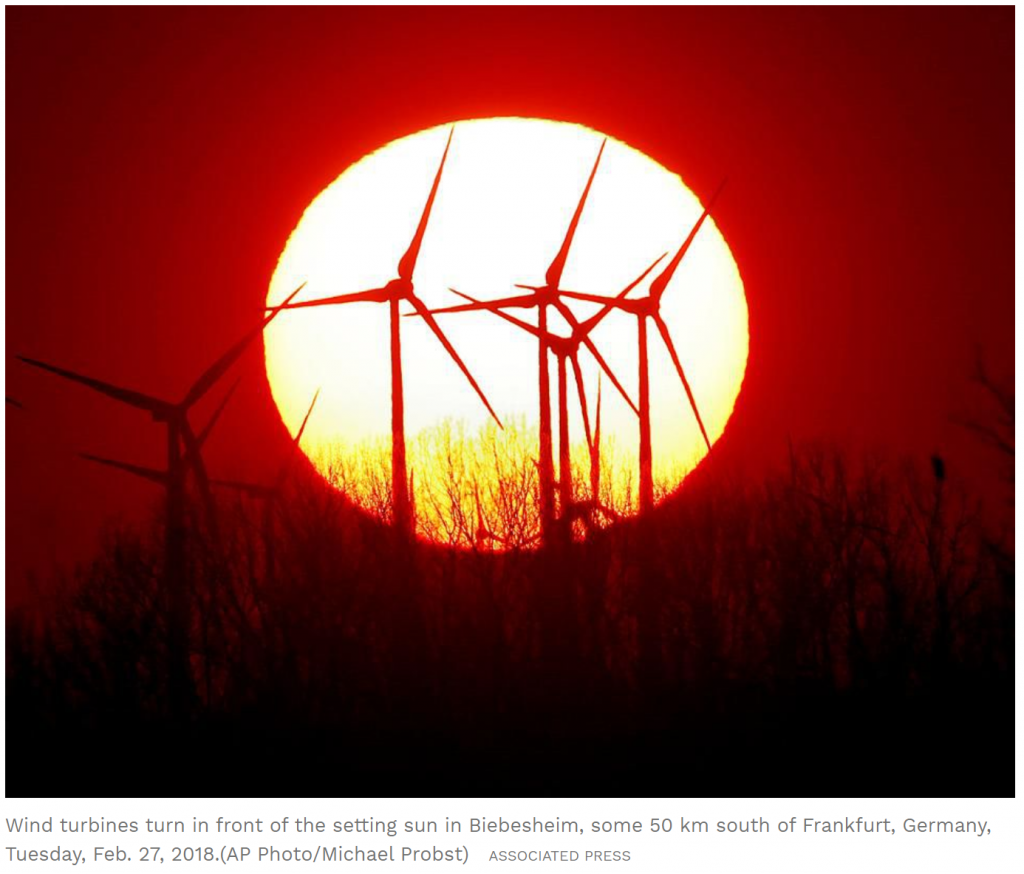
I cannot disagree more with the assertion by Sen. Dick Durbin in a recent Sun-Times op-ed that nuclear power is a necessary and viable way to combat climate change.
Electricity production by nuclear power is not, and can never be made, safe and economical.
When nuclear power plants were first touted in the 1950s as a new and safe method for producing electricity, it was said the electricity would be “too cheap to meter.” This is pure nonsense! If it was so safe, why weren’t any power plants built and put on line until passage of the Price-Anderson Act? The law has been amended a number of times and greatly limits the liability of operators of nuclear power plants.
Anything paid out beyond the limits set in Price-Anderson would take years of lawsuits.
Sen. Durbin wrote “It is past time for Congress to step up and develop a comprehensive, consent-based plan to store nuclear waste.” That’s an understatement. Nuclear waste is stored within a half-mile of Lake Michigan at the now-closed Zion nuclear power plant. Why is it close to the source of our drinking water? Because there is nowhere to ship it! Plans to ship such waste to a depository in Yucca Mountain in the southwest fell through when some improperly stored barrels burst into flames, releasing large amounts of high-level radioactive material.
Who does the senator think will agree to a “consent-based plan” when there is no known method of safely storing these dangerous materials for thousands of years, the time it takes for radioactive decay to make it safe for the environment?
Sen. Durbin argued that “we must ensure the nuclear fleet remains safe and economical,” but nuclear power has never been economical. As far as I know, the last time a permit was approved for a new nuclear plant was during the Obama administration. That plant in Georgia is only about half complete, although it was to be finished by now and the cost is already double the initial estimate.
The current “fleet,” as Sen. Durbin called them, of nuclear power plants were designed and engineered to last about 30 to 40 years. Most of our country’s plants are near that age. Their internal systems are constantly bombarded by radioactive particles, making the metal in the systems more brittle and prone to failure every year. Subsidizing them is a waste of taxpayer money and a dangerous gamble with our lives.
I hope Sen. Durbin changes his mind. The real carbon-free sources of electricity are renewables: wind and solar.
George Milkowski, West Ridge
Letters to the Editor: Nuclear energy may not emit carbon, but it isn’t ‘clean’

To the editor: Steven Chu and Ernest Moniz are both professors who served as U.S. Energy secretary. They have more science credentials than most mortals. I am none of those things.
Yet, I was concerned when I read in their piece advocating for the continued use of the Diablo Canyon nuclear plant past the planned 2025 decommissioning that they referred to the electricity it produces as “clean.”
I recognize that they did so in order to differentiate nuclear from energy sources that emit carbon dioxide. However, the lack of carbon emissions notwithstanding, can nuclear energy truly be called clean?
There is the not-so-small matter of spent nuclear fuel. Where does it go? Where will it go? It’s currently in a cooling pool on-site. Owner Pacific Gas and Electric has requested permission to develop a dry cask storage system on-site; it did not estimate how long the spent fuel would be stored there.
Spent fuel is radioactive for a very long time. Whichever way you store it, if anything compromises the containment, the danger is released.
Carbon emissions or none, it is misleading to refer to nuclear energy as clean, especially when it comes to its impact on the environment.
Elise Power, Garden Grove
..
To the editor: I was energized by the piece on the Diablo Canyon nuclear plant. It reminded me of the sad situation at our local San Onofre Nuclear Generating Station.Continue reading
Pilgrim nuclear plant may release 1M gallons of radioactive water into bay. What we know
“Diane Turco, of Harwich, the director of Cape Downwinders, a citizen group that was at the forefront of the effort to close Pilgrim, called any option that included sending radioactive water into the bay “outrageous” and “criminal.” Turco said she has no confidence in the decommissioning process.
“The process has been to allow radioactivity into the environment,” she said. “The answer should be no you can’t do that.””
PLYMOUTH — One of the options being considered by the company that is decommissioning the closed Pilgrim Nuclear Power Station is to release around one million gallons of potentially radioactive water into Cape Cod Bay.
The option had been discussed briefly with state regulatory officials as one possible way to get rid of water from the spent fuel pool, the reactor vessel and other components of the facility, Holtec International spokesman Patrick O’Brien said in an interview Wednesday. It was highlighted in a report by state Department of Environmental Protection Deputy Regional Director Seth Pickering at Monday’s meeting of the Nuclear Decommissioning Citizens Advisory Panel in Plymouth.
“We had broached that with the state, but we’ve made no decision on that,” O’Brien said.
As of mid-December, Holtec will complete the process of moving all the spent fuel rods into casks that are being stored on a concrete pad on the Pilgrim plant site in Plymouth. After that, O’Brien told the panel, the removal and disposal of other components in those areas of the facility will take place and be completed sometime in February.
What to expect as Iran nuclear talks resume next week
“New round of talks unlikely to produce breakthrough but will shed light on posture of new Iranian government, analysts say.”
By Ali Harb Aljazeera aljazeera.com

“We’re going to find out how different these [Iranian] hardliners are from previous hardliners; we’re going to find out if they’re going to be a little softer,” said Negar Mortazavi, an Iranian-American journalist and analyst.
“And we’re also going to find out if the Americans have really realised that they missed an opportunity, and that they should change their position to some extent.”
Proponents of the deal, including Mortazavi, have criticised US President Joe Biden for not moving with urgency to restore the agreement in the first months of his administration, when a more moderate Iranian government headed by former President Hassan Rouhani was in charge.
Six rounds of talks in Vienna between April and June failed to forge a path back into the agreement.
“That golden window of opportunity was short, and the Biden team completely missed it,” Mortazavi told Al Jazeera.
A spin on Kirtland Air Force Base’s (which shares runways with the ABQ International Airport) true mission from the ABQ Journal: “Air Force lab injects $2B into NM’s economy”
The Kirtland Air Force Lab is dedicated to militarizing space, not improving the lives of New Mexico citizens.
As stated by the Arms Control Association in an April 2021 article titled Apes on a Treadmill in Space:
“The United States should recognize that a pattern of continued militarization of space is insufficient to provide the stability on which its economy and its armed forces depend, so the tools of diplomacy and international law should be marshalled too.”

By Kevin Robinson-Avila / Journal Staff Writer – Albuquerque Journal abqjournal.com
Air Force Research Laboratory spending on space and “directed energy” technology like lasers and microwaves boosted the local economy by nearly $2 billion over the past three years, according to a new economic impact report.
Risk of quakes caused by oil, gas in New Mexico rising
“The occurrence of smaller earthquakes began to increase in 2017, when oil and gas boomed in the region, up to about three per day recently. In 2021, records show the region was on track for more than 1,200 earthquakes with magnitudes of 1 to 4.”
CARLSBAD, N.M. (AP) — Multiple earthquakes were felt earlier this fall in West Texas, leading regulators in that state to designate a seismic response area and call for less wastewater from oil and gas development to be injected in disposal wells.
As more seismic activity was reported closer to the state line, officials in New Mexico have been watching closely and gathering data. Some officials are concerned that as Texas limits the injection of produced water as a means to curb the seismic activity, that could affect producers in New Mexico.
Moscow says U.S. rehearsed nuclear strike against Russia this month
“Against this backdrop, Russo-Chinese coordination is becoming a stabilising factor in world affairs,” said Russian Defence Minister Sergei Shoigu.
By Andrew Osborn and Phil Stewart (Reuters)

MOSCOW/WASHINGTON, Nov 23 (Reuters) – Russia’s defence minister on Tuesday accused U.S. bombers of rehearsing a nuclear strike on Russia from two different directions earlier this month and complained that the planes had come within 20 km (12.4 miles) of the Russian border.
But the Pentagon said its drills were announced publicly at the time and adhered to international protocols.
Moscow’s accusation comes at a time of high tension with Washington over Ukraine, with U.S. officials voicing concerns about a possible Russian attack on its southern neighbour – a suggestion the Kremlin has dismissed as false.
Moscow has in turn accused the United States, NATO and Ukraine of provocative and irresponsible behaviour, pointing to U.S. arms supplies to Ukraine, Ukraine’s use of Turkish strike drones against Russian-backed separatists in eastern Ukraine, and NATO military exercises close to its borders.
Explainer: Will Germany’s next government ditch U.S. nuclear bombs?
“Germany can, of course, decide whether there will be nuclear weapons in (its) country, but the alternative is that we easily end up with nuclear weapons in other countries in Europe, also to the east of Germany,” NATO Secretary-General Jens Stoltenberg said.
BERLIN, Nov 22 (Reuters) archivemd.com
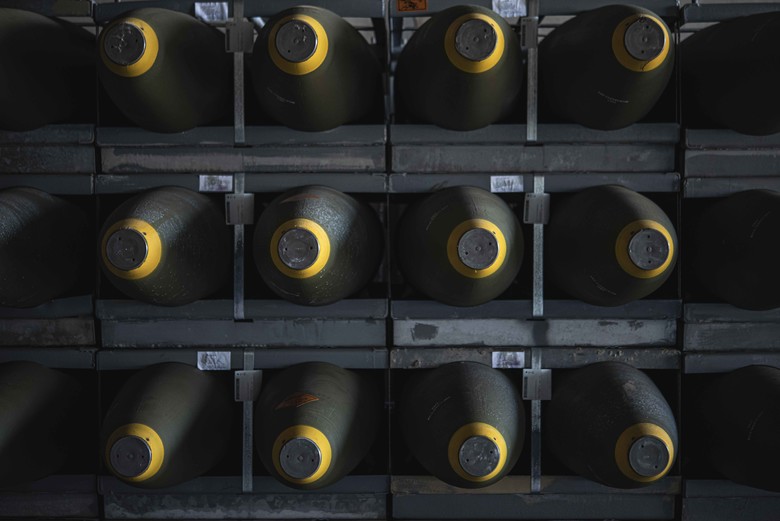
Perilous Profiteering: The companies building nuclear arsenals and their financial backers
PAX and ICAN have released the latest Don’t Bank on the Bomb report “Perilous Profiteering: The companies building nuclear arsenals and their financial backers“, which names the 338 investors backing 25 nuclear weapon producing companies and the size of their investments. This report is also the first time we were able to find information on Russian and Chinese investments.

The report also found three clear signs that financial institutions are starting to see nuclear weapons as risky business, and are leaving them behind:
• From 2019 to 2021, the total amount made available for nuclear weapons producing companies dropped by an impressive $63 billion, and the total number of financial institutions willing to invest in nuclear weapons producing companies went down too.
• Nuclear weapons producing companies, despite billion dollar contracts, have debt. But investors are moving away. So instead, they’re borrowing from wherever they can to raise cash. In other words: producing weapons of mass destruction has become extremely unattractive.
• 127 financial institutions stopped investing in companies producing nuclear weapons this year!
Of course, we still have a lot of work to do to hold these profiteers accountable. Banks, insurers, asset managers and pension funds still made $685 billion available for the companies producing nuclear weapons (like Northrop Grumman, which has $24 billion in outstanding contracts).
Our banks, insurers, and pension funds have no business investing in companies that choose to be involved in illegal weapons of mass destruction, and we need to tell them. Read the key findings of the report HERE.
Federal inspection of Pilgrim plant finds only ‘minor’ violations
A federal inspection of the decommissioned Pilgrim Nuclear Power Station in Plymouth that began in July and stretched through September found “no violations of more than minor significance,” the U.S. Nuclear Regulatory Commission said.
By Colin A. Young, State House News Service PATRIOT LEDGER NEWS patriotledger.com

The inspection included “an evaluation of the safety screening, safety review, onsite management review, engineering change processes, the fire protection program, maintenance program, and the available results for site radiological and non-radiological characterization,” the Nuclear Regulatory Commission said. The agency also conducted “a review and observation of the independent spent fuel storage installation (ISFSI) dry cask activities.”
Inspectors visited Pilgrim at least five times during the announced quarterly inspection to observe Holtec Decommissioning International’s activities “as they relate to safety and compliance with the commission’s rules and regulations” and the conditions of the company’s license.
“Based on the results of this inspection, no violations of more than minor significance were identified,” the Nuclear Regulatory Commission wrote in the inspection report.
The Plymouth nuclear plant, which employed about 600 people and had been generating about 680 megawatts of electricity per year since coming online in 1972, permanently ceased operations May 31, 2019.
Holtec has estimated that it can complete decommissioning work by the end of 2027.
WIPP: Judge upholds change in how nuke waste is counted. Could keep site open to 2050
“We know it’s part of expanding WIPP. We know what DOE is doing but DOE doesn’t want to publicly admit it and the Environment Department doesn’t want to deal with it…The reason the laws have always put limits on WIPP is that the DOE was supposed to be finding locations for other repositories. There is no other repository and that’s why they don’t want to have a limit on what goes into WIPP.” — Don Hancock, nuclear waste program director at Southwest Research and Information Center.
By Adrian Hedden Carlsbad Current-Argus November 15, 2021 currentargus.com
A New Mexico appellate judge upheld a change in how the volume of nuclear waste disposed of at the Waste Isolation Pilot Plant is counted, shifting the repository from being halfway to capacity to only a third full.
In 2018, the U.S. Department of Energy requested to modify its WIPP operating permit with the New Mexico Environment Department (NMED) to change how it counts the amount of waste toward the facility’s statutory limit of 6.2 million cubic feet of transuranic (TRU) waste consisting of clothing materials and equipment irradiated during nuclear activities.
The change was intended to count the inner volume of the waste as opposed to the volume of the outer containers that hold the waste, seeking to avoid counting air between the waste itself and waste drums.
NMED approved the permit modification request (PMR) in 2019, but Albuquerque-based watchdog groups Southwest Research and Information Center and Nuclear Watch New Mexico immediately appealed the decision.
Australia Could Push To Acquire Retired US Navy Los Angeles Class Nuclear Submarines
“The rules for transferring a nuclear-powered vessel to a foreign power are uncharted waters…”
U.S., UK aid to Australia’s acquisition of nuclear submarines “sheer act of nuclear proliferation”: Chinese envoy
“This literally turns existing precedence and practice on their heads in order to extend traditionally northern hemisphere cooperation to Australia and bolster its role in countering an increasingly assertive China.” https://thebulletin.org
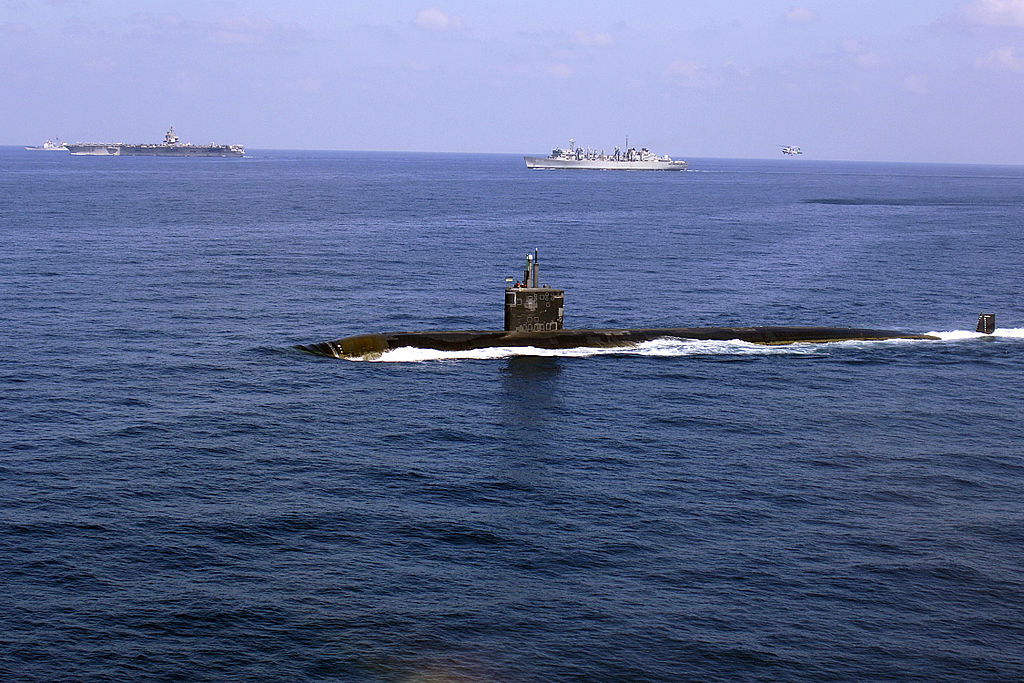
The recently signed Australia–United Kingdom–United States defense agreement, or AUKUS, calls for the United States and Britain to share nuclear-submarine technology with Australia. Although the agreement was light on details of what, when, and how, plans apparently are for Australia to eventually build at least eight nuclear-powered attack submarines. In the interim, former Australian Prime Minister Tony Abbott is now advocating for Australia to obtain used nuclear submarines to get the sharing started so as to spin up the Royal Australian Navy’s submarine capabilities and nuclear know-how. Australia has never had a nuclear power plant of any kind.
Speaking last Friday at a Wilson Center event in Washington, D.C., Abbott suggested that, in the short term, Australia should consider leasing or purchasing one or more existing U.S. submarines to develop Australia’s capability to operate nuclear-powered submarines.
Abbott has posed the question, “Might it be possible for Australia to acquire a retiring [Los Angeles] class boat or two and to put it under an Australian flag and to run it, if you like, as an operational training boat?” Abbott added that he’d make a similar proposal for British nuclear-powered submarines “were I in London.”
COP26: Fossil fuel industry has largest delegation at climate summit
“There are more delegates at COP26 associated with the fossil fuel industry than from any single country, analysis shared with the BBC shows.”
By Matt McGrath • BBC NEWS bbc.com
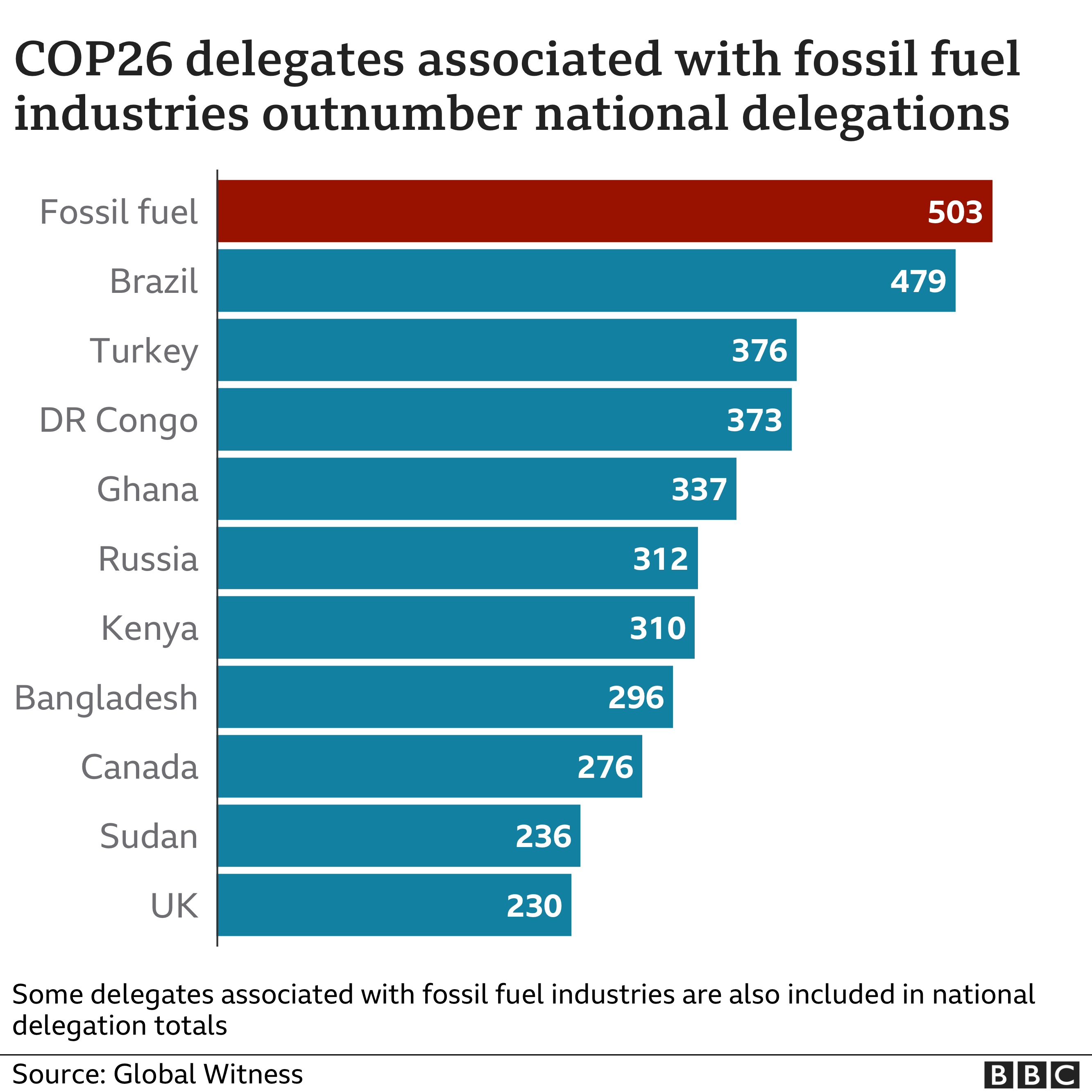
Campaigners led by Global Witness assessed the participant list published by the UN at the start of this meeting.
They found that 503 people with links to fossil fuel interests had been accredited for the climate summit.
These delegates are said to lobby for oil and gas industries, and campaigners say they should be banned.
“The fossil fuel industry has spent decades denying and delaying real action on the climate crisis, which is why this is such a huge problem,” says Murray Worthy from Global Witness.
“Their influence is one of the biggest reasons why 25 years of UN climate talks have not led to real cuts in global emissions.”
About 40,000 people are attending the COP. Brazil has the biggest official team of negotiators according to UN data, with 479 delegates.
The UK, which is hosting the talk in Glasgow, has 230 registered delegates.
U.S. ‘very bullish’ on new nuclear technology, Granholm says
“These advanced nuclear reactors, and the existing fleet, are safe,” Granholm says. “We have the gold standard of regulation in the United States.”
Actually…According to a UCS report, if federal regulators require the necessary safety demonstrations, it could take at least 20 years—and billions of dollars in additional costs—to commercialize such reactors, their associated fuel-cycle facilities, and other related infrastructure.
The Nuclear Regulatory Commission (NRC) may have to adapt some regulations when licensing reactor technologies that differ significantly in design from the current fleet. Lyman says that should not mean weakening public health and safety standards, finding no justification for the claim that “advanced” reactors will be so much safer and more secure that the NRC can exempt them from fundamental safeguards. On the contrary, because there are so many open questions about these reactors, he says they may need to meet even more stringent requirements.
By Ben Adler • Yahoo News news.yahoo.com
GLASGOW, Scotland — In an interview at the U.N. Climate Change Conference, Secretary of Energy Jennifer Granholm told Yahoo News on Friday that the Biden administration is “very bullish” on building new nuclear reactors in the United States.
“We are very bullish on these advanced nuclear reactors,” she said. “We have, in fact, invested a lot of money in the research and development of those. We are very supportive of that.”
Nuclear energy is controversial among environmental activists and experts because while it does not create the greenhouse gas emissions that cause climate change, it has the potential to trigger dangerous nuclear meltdowns and creates radioactive nuclear waste [not a small issue].
Al Jazeera Infographic: The World Nuclear Club
While 32 countries generate atomic energy, nine have nuclear weapons and seven countries have both.
By Mohammed Haddad and Hanna Duggal Al Jazeera aljazeera.com
Nuclear warheads per country
Nine countries possessed roughly 13,150 warheads as of August 2021, according to the Federation of American Scientists. More than 90 percent are owned by Russia and the US.
At the peak in 1986, the two rivals had nearly 65,000 nuclear warheads between them, making the nuclear arms race one of the most threatening events of the Cold War. While Russia and the US have dismantled thousands of warheads, several countries are thought to be increasing their stockpiles, most notably China.
According to the Pentagon’s 2021 annual report (pdf), China’s nuclear warhead stockpile is expected to more than triple and reach at least 1,000 by 2030.
The only country to voluntarily relinquish nuclear weapons is South Africa. In 1989, the government halted its nuclear weapons programme and in 1990 began dismantling its six nuclear weapons. Two years later, South Africa joined the Treaty on the Non-Proliferation of Nuclear Weapons (NPT) as a non-nuclear country.
With the 26th UN Climate Change Conference over, nations are making plans to move to green energy in a bid to tackle global warming.
But nuclear energy is a particular sticking point. While it is the largest source of low-carbon electricity in OECD countries, some nations have spoken out against the categorisation of nuclear energy as climate-friendly.
Across the globe, 34 countries harness the power of splitting atoms for generating electricity or for nuclear weapons. (Al Jazeera)
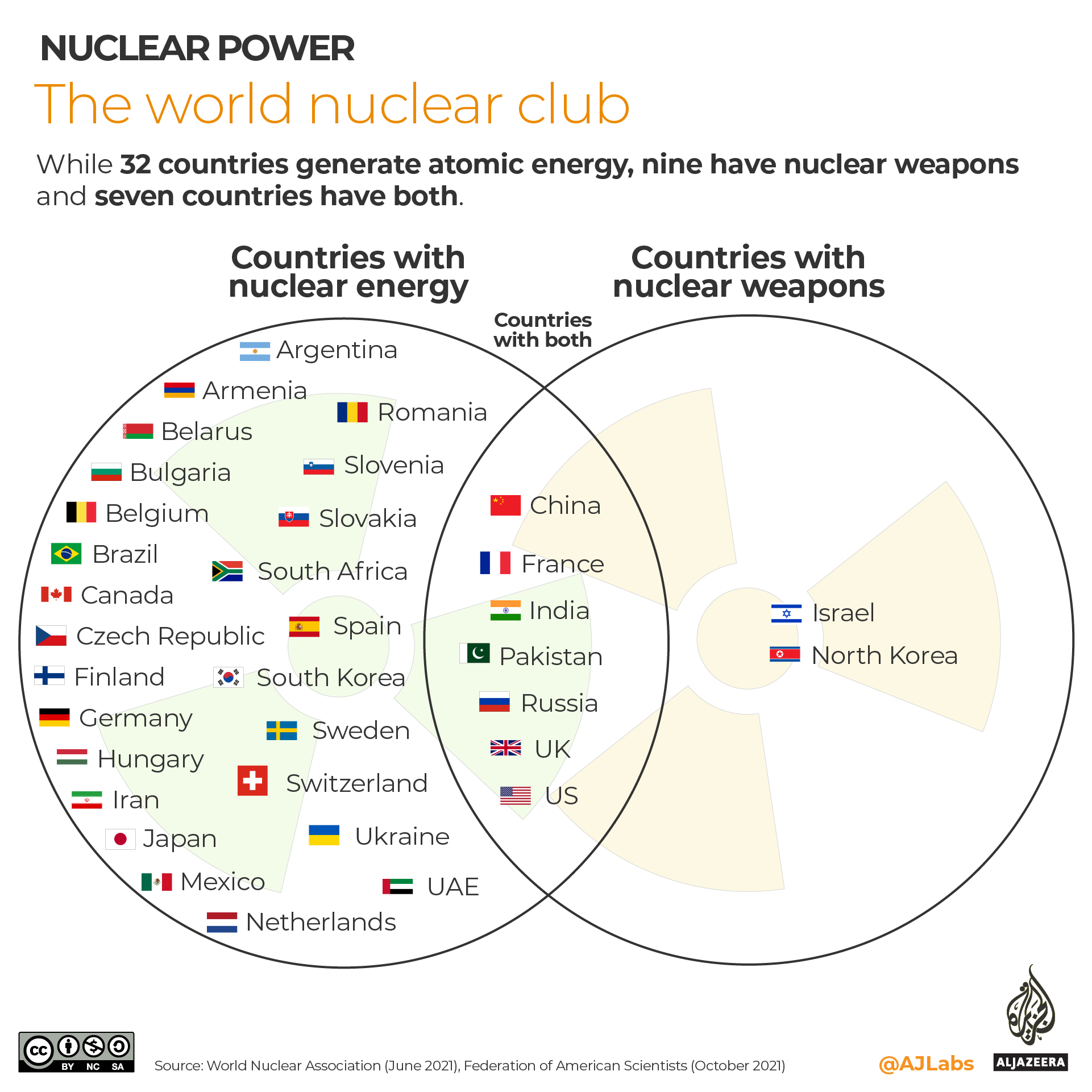
Global nuclear energy
Nuclear energy provides roughly 10 percent of the world’s electricity. Of the 32 countries with nuclear power reactors, more than half (18) are in Europe. France has the world’s highest proportion of its electricity – at 71 percent – coming from atomic power.
Up until 2011, Japan was generating some 30 percent of its electricity from nuclear reactors; however, following the Fukushima disaster, all nuclear power plants were suspended for safety inspections. As of 2020, just 5 percent of Japan’s electricity came from nuclear power, according to the World Nuclear Association.
Nuclear power constitutes some 20 percent of the United States’ electricity. About 60 percent of the country’s energy comes from fossil fuels, including coal, natural gas and petroleum, with the remaining 20 percent coming from renewable sources – wind, hydro and solar.
Flooding and Nuclear Waste Eat Away at a Tribe’s Ancestral Home
The federal government allowed a stockpile of spent fuel on a Minnesota reservation to balloon even as a dam project whittled down the amount of livable land.
Interviews and documents obtained by The New York Times show how the state of Minnesota and the federal government ignored warnings about potential dangers posed to the tribe as they kept allowing the amount of waste stored on the reservation to expand and did little to address annual flooding that harms the tribe’s economy.
“I mean, this is a classic environmental justice fact pattern,” said Heather Sibbison, chair of Dentons Native American law and policy practice at Dentons Law Firm. “We have a minority community, a disadvantaged community, bearing the brunt of two huge infrastructure projects that serve other people.”
By Mark Walker NEW YORK TIMES nytimes.com
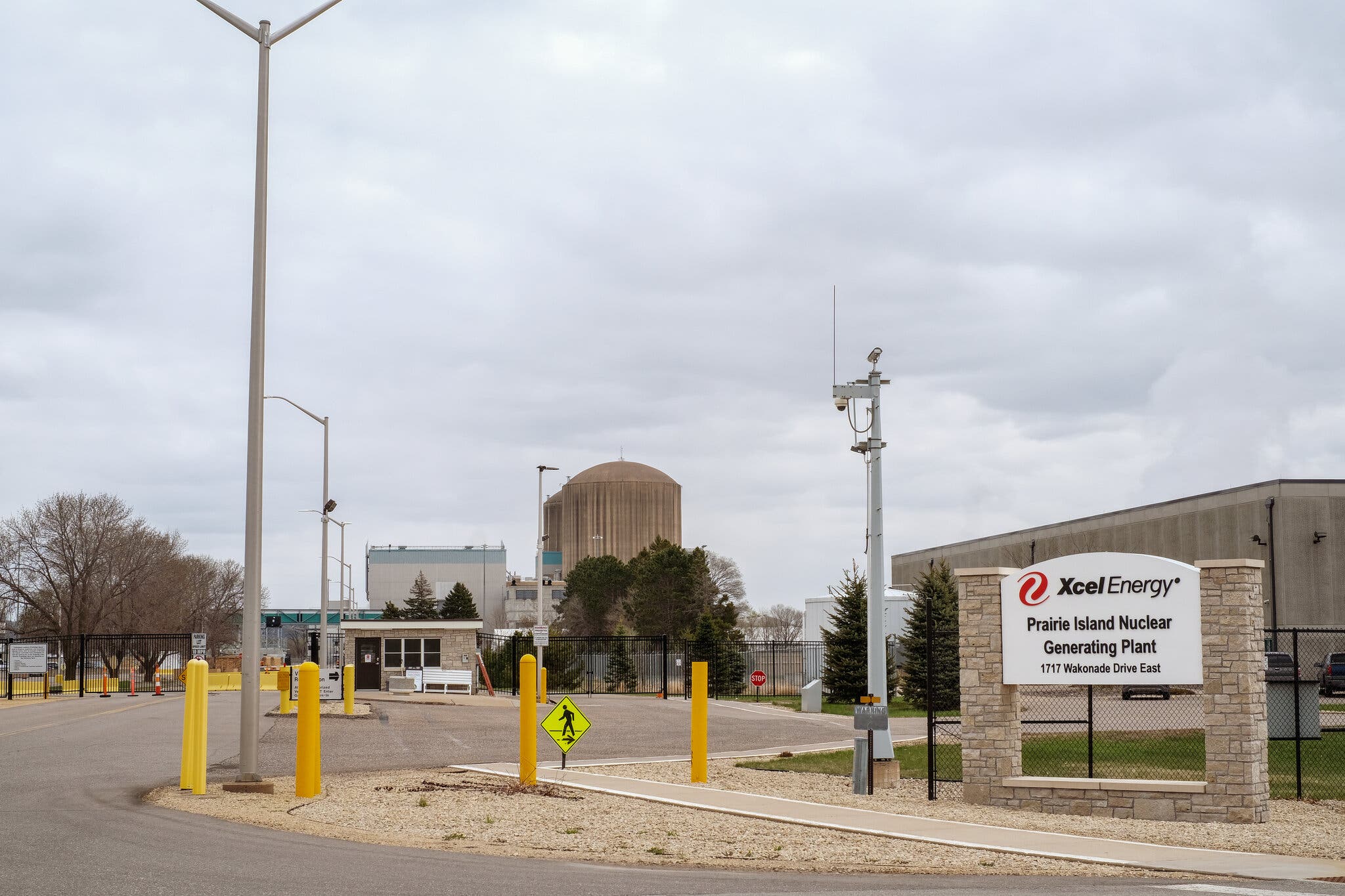
For decades, chronic flooding and nuclear waste have encroached on the ancestral lands in southeastern Minnesota that the Prairie Island Indian Community calls home, whittling them to about a third of their original size.
Two years after the tribe received federal recognition in 1936, the Army Corps of Engineers installed a lock-and-dam system just to the south along the Mississippi River. It repeatedly flooded the tribe’s land, including burial mounds, leaving members with only 300 livable acres.
Decades later, a stockpile of nuclear waste from a power plant next to the reservation, which the federal government reneged on a promise to remove in the 1990s, has tripled in size. It comes within 600 yards of some residents’ homes.
With no room to develop more housing on the reservation, more than 150 tribal members who are eager to live in their ancestral home are on a waiting list.
Cody Whitebear, 33, who serves as the tribe’s federal government relations specialist, is among those waiting. He hopes he can inherit his grandmother’s house, which is on the road closest to the power plant.
“I never had the opportunity to live on the reservation, be part of the community,” said Mr. Whitebear, who began connecting with his heritage after the birth of his son, Cayden. “In my mid-20s I had the desire to learn about my people and who I am and who we are.”
Proposed plutonium shipments concern New Mexico lawmakers
“The agency has said little overall about its plans, despite the potential hazards, said Cindy Weehler, who co-chairs the watchdog group 285 ALL.”
By Scott Wyland swyland@sfnewmexican.com Santa Fe New Mexican santafenewmexican.com

A panel of state lawmakers expressed concerns Friday about plans to truck plutonium shipments through New Mexico, including Santa Fe’s southern edge, and will send letters to state and federal officials asking for more information on the transports.
Two opponents of the shipments — a Santa Fe County commissioner and a local activist — presented the Department of Energy’s basic plan to the Legislature’s Radioactive and Hazardous Materials Committee, provoking a mixture of surprise and curiosity from members.
Several lawmakers agreed transporting plutonium is more hazardous because it is far more radioactive than the transuranic waste — contaminated gloves, equipment, clothing, soil and other materials — that Los Alamos National Laboratory now ships to the Waste Isolation Pilot Plant, an underground disposal site near Carlsbad.
Nuclear Power Is COP26’s Quiet Controversy
“We have to get everything done in the next 25 years…The idea that you’re going to scale up a technology you don’t even have yet, and it’s going to be commercially viable [in that time], just seems to me like la la land.” — Tom Burke, co-founder of climate think tank E3G.
BY ALEJANDRO DE LA GARZA time.com
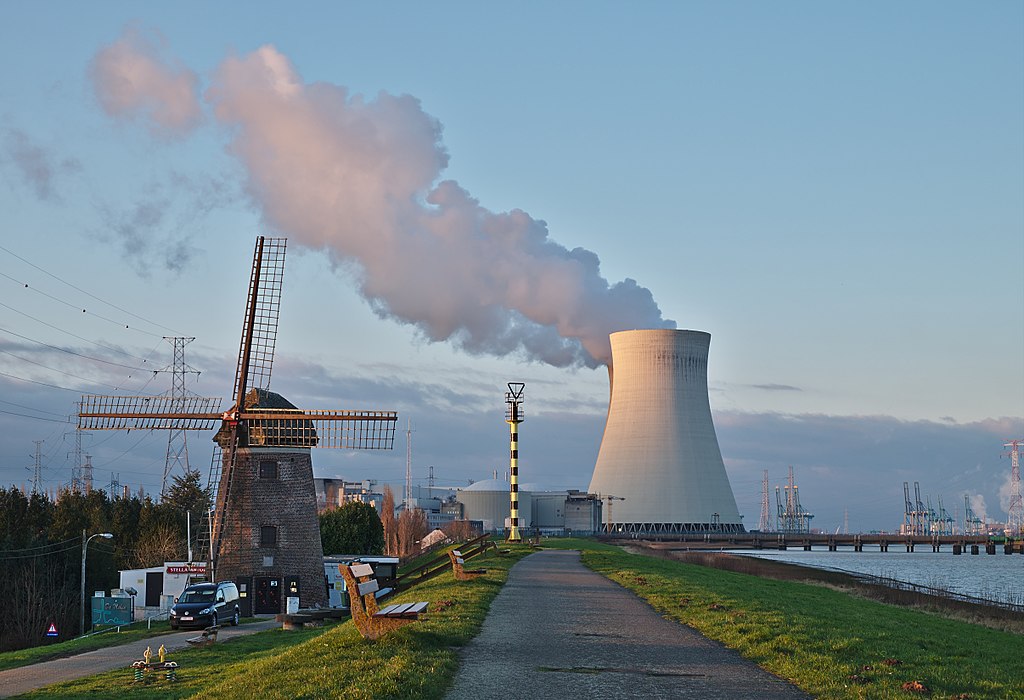
In the midst of the COP26 climate talks yesterday, U.S. and Romanian officials stepped aside for a session in the conference’s Blue Zone, establishing an agreement for U.S. company NuScale to build a new kind of modular nuclear power plant in the southeastern European country. The company’s plants—designed to be quickly scaled up or down based on need—are intended to be quicker and cheaper to build than the traditional kind, with some considering them to be a promising alternative for countries seeking to wean themselves off fossil fuels.
NuScale CEO John Hopkins sees the agreement as part of a broader recognition that nuclear power has a big role to play as the world decarbonizes. “I’ve seen a significant shift here,” Hopkins said, speaking to TIME from Glasgow yesterday. “It used to be the only thing really discussed was renewables, but I think people are starting to be a little more pragmatic and understand that nuclear needs to be in the mix.”
But others at COP26 aren’t convinced that NuScale’s small reactors can help avoid climate catastrophe. Some point to the fact that NuScale has yet to build a single commercial plant as evidence that the company is already too late to the party.
US Government Works to ‘Cocoon’ Old Nuclear Reactors
Costs to clean up a massive nuclear weapons complex in Washington state are usually expressed in the hundreds of billions of dollars and involve decades of work.
Hanford watchdogs generally agree with this process, said Tom Carpenter, director of the Seattle-based watchdog group Hanford Challenge.
“Nobody is raising any concerns about cocooning,” Carpenter said. “We’re all worried about the tank waste that needs immediate and urgent attention.” The bigger question is whether future generations will be willing to pay the massive costs of Hanford cleanup, he said.
By NICHOLAS K. GERANIOS Associated Press November 4, 2021 abcnews.go.com
SPOKANE, Wash. — Costs to clean up a massive nuclear weapons complex in Washington state are usually expressed in the hundreds of billions of dollars and involve decades of work.
But one project on the Hanford Nuclear Reservation is progressing at a much lower price.
The federal government is moving forward with the “cocooning” of eight plutonium production reactors at Hanford that will place them in a state of long-term storage to allow radiation inside to dissipate over a period of decades, until they can be dismantled and buried.
“It’s relatively non-expensive,” Mark French, a manager for the U.S. Department of Energy, said of cocooning. “The cost of trying to dismantle the reactor and demolish the reactor core would be extremely expensive and put workers at risk.”
The federal government built nine nuclear reactors at Hanford to make plutonium for atomic bombs during World War II and the Cold War. The site along the Columbia River contains America’s largest quantity of radioactive waste.
Is it green, or forever toxic? Nuclear rift at climate talks
“Whether we decide to go on with the nuclear energy or not…We will need to find a solution for the management of that nuclear waste” that humankind has already produced.” — Audrey Guillemenet, geologist and spokesperson for one of France’s underground waste repositories.
By ANGELA CHARLTON Associated Press November 4, 2021 apnews.com
SOULAINES-DHUYS, France (AP) — Deep in a French forest of oaks, birches and pines, a steady stream of trucks carries a silent reminder of nuclear energy’s often invisible cost: canisters of radioactive waste, heading into storage for the next 300 years.
As negotiators plot out how to fuel the world while also reducing carbon emissions at climate talks in Scotland, nuclear power is a central sticking point. Critics decry its mammoth price tag, the disproportionate damage caused by nuclear accidents, and radioactive leftovers that remain deadly for thousands of years.
But increasingly vocal and powerful proponents — some climate scientists and environmental experts among them — argue that nuclear power is the world’s best hope of keeping climate change under control, noting that it emits so few planet-damaging emissions and is safer on average than nearly any other energy source. Nuclear accidents are scary but exceedingly rare — while pollution from coal and other fossil fuels causes death and illness every day, scientists say.
U.S. Discloses Nuclear Stockpile Numbers
The Biden administration has publicly released the total number of nuclear weapons in the U.S. stockpile, a sharp reversal of the previous administration’s refusal to do so for the past three years.
By: Shannon Bugos ARMS CONTROL ASSOCIATION • armscontrol.org
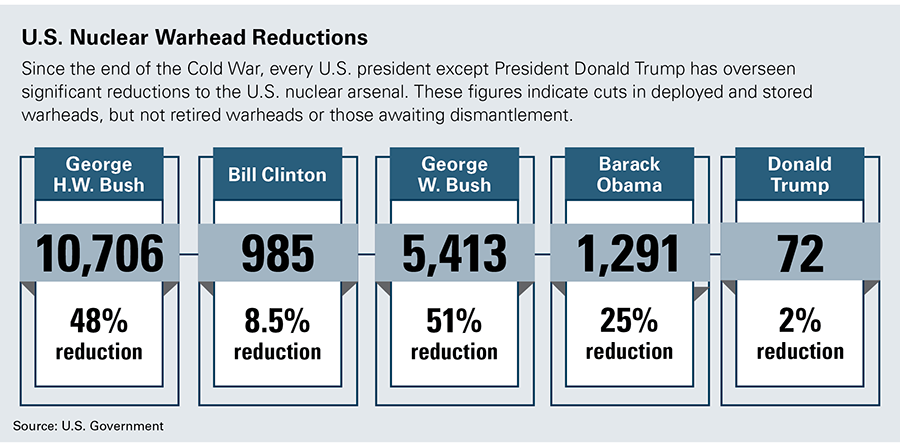
“Today, as an act of good faith and a tangible, public demonstration of the U.S. commitment to transparency, we will present data which documents our own record of continued progress toward the achievement of the goals” of the 1968 nuclear Nonproliferation Treaty (NPT), said Bonnie Jenkins, undersecretary of state for arms control and international security, on Oct. 5.
The U.S. stockpile of nuclear warheads was at 3,750 as of September 2020, according to the administration document. This number captures active and inactive warheads, but not the roughly 2,000 retired warheads awaiting dismantlement. The document lists stockpile numbers going back to 1962, including the warhead numbers from the years when the Trump administration refused to declassify the information.
Jellyfish Keep Attacking Nuclear Power Plants
Jellyfish are continuing to clog the cooling pipes of nuclear power plants around the world.
By Gabriel Geiger • vice.com
Jellyfish are continuing to clog the cooling intake pipes of a nuclear power plant in Scotland, which has previously prompted a temporary shutdowns of the plant.
The Torness nuclear power plant has reported concerns regarding jellyfish as far back as 2011, when it was forced to shut down for nearly a week—at an estimated cost of $1.5 million a day—because of the free-swimming marine animals.
In a short comment to Motherboard, EDF energy, which runs the Torness plant, said that “jellyfish blooms are an occasional issue for our power stations,” but also said that media reports claiming the plant had recently been taken offline because of jellyfish are “inaccurate.” “[There were] no emergency procedures this or last week related to jellyfish or otherwise,” a spokesperson said.
Like many other seaside power plants, the Torness plant uses seawater to prevent overheating. While there are measures in place to prevent aquatic life from entering the intake pipes, according to the Bulletin of the Atomic Scientists, they are no match for the sheer number of jellyfish that come during so-called “jellyfish blooms.”
Art and “un-forgetting”: How to honor the atomic dead
“The hibakusha narrative has expanded over time to include victims beyond the city limits of Hiroshima and Nagasaki—and as far away as the Navajo Nation, which still suffers the radiation effects of uranium mining; the Marshall Islands, where the United States conducted so many nuclear tests that, on average, the equivalent of 1.6 Hiroshima-size bombs was detonated every day for 12 years; Kazakhstan, where the Soviet Union tested its nuclear weapons for four decades; and other places around the world adversely affected by the development and maintenance of nuclear weapons.”
Noguchi himself considered the term hibakusha to include the victims of nuclear weapons worldwide; he changed the name of his proposed “Memorial to the Dead of Hiroshima” to the more inclusive “Memorial to the Atomic Dead.”
![]() By Molly Hurley | November 26, 2021 thebulletin.org
By Molly Hurley | November 26, 2021 thebulletin.org
As I eagerly await Spotify’s year-end report on my most-played songs of 2021, I wonder which ones will remind me of my summer in New York City—of off-pitch Karaoke Television with friends, or the distinct “popping” sound of a pigeon being run over by a taxi not more than two feet in front of me. Though I thrived amid the frenzied surprises of the city, I also found sudden moments of quiet solemnity while sketching inside the many art museums of the Big Apple. One of those museums was the Noguchi Museum, established in 1985 by its namesake Isamu Noguchi, a Japanese-American sculptor who is also well known for his landscape architecture and modern furniture designs such as the iconic Noguchi table.Continue reading
HIDDEN AGENDA: The unspoken argument for more nuclear power
Nuclear power is so slow and expensive that it doesn’t even matter whether or not it is ‘low-carbon’ (let alone ‘zero-carbon’). As the scientist, Amory Lovins, says, “Being carbon-free does not establish climate-effectiveness.” If an energy source is too slow and too costly, it will “reduce and retard achievable climate protection,” no matter how ‘low-carbon’ it is.
By Linda Pentz Gunter beyondnuclearinternational.org
 So here we are again at another COP (Conference of the Parties). Well, some of us are in Glasgow, Scotland at the COP itself, and some of us, this writer included, are sitting at a distance, trying to feel hopeful.
So here we are again at another COP (Conference of the Parties). Well, some of us are in Glasgow, Scotland at the COP itself, and some of us, this writer included, are sitting at a distance, trying to feel hopeful.
But this is COP 26. That means there have already been 25 tries at dealing with the once impending and now upon us climate crisis. Twenty five rounds of “blah, blah, blah” as youth climate activist, Greta Thunberg, so aptly put it.
So if some of us do not feel the blush of optimism on our cheeks, we can be forgiven. I mean, even the Queen of England has had enough of the all-talk-and-no-action of our world leaders, who have been, by and large, thoroughly useless. Even, this time, absent. Some of them have been worse than that.
Not doing anything radical on climate at this stage is fundamentally a crime against humanity. And everything else living on Earth. It should be grounds for an appearance at the International Criminal Court. In the dock.
‘Ignored for 70 years’: human rights group to investigate uranium contamination on Navajo Nation
Boost for advocates’ group is step further in decades-long fight against mining pollution
By: Cody Nelson THE GUARDIAN • theguardian.com
Rita Capitan has been worrying about her water since 1994. It was that autumn she read a local newspaper article about another uranium mine, the Crownpoint Uranium Project, getting under way near her home.
Capitan has spent her entire life in Crownpoint, New Mexico, a small town on the eastern Navajo Nation, and is no stranger to the uranium mining that has persisted in the region for decades. But it was around the time the article was published that she began learning about the many risks associated with uranium mining.
“We as community members couldn’t just sit back and watch another company come in and just take what is very precious to us. And that is water – our water,” Capitan said.
To this effect, Capitan and her husband, Mitchell, founded Eastern Navajo Diné Against Uranium Mining (Endaum). The group’s fight against uranium mining on their homeland has continued for nearly three decades, despite the industry’s disastrous health and environmental impacts being public knowledge for years.
Capitan’s newest concerns are over the Canadian mining company Laramide Resources, which, through its US subsidiary NuFuels, holds a federal mining license for Crownpoint and nearby Church Rock. Due to the snail’s pace at which operations like this can move, Laramide hasn’t begun extraction in these areas, but is getting closer by the day.
An Unearthly Spectacle: The Untold Story of the World’s Biggest Nuclear Bomb
Take a minute to visit the Bulletin of Atomic Scientists website to read this brilliant photo essay on the Tsar Bomba by Associate Professor and Director of the Science and Technology Studies program at the Stevens Institute of Technology Alex Wellerstein. His first book, Restricted Data: The History of Nuclear Secrecy in the United States, was published by the University of Chicago Press in April 2021.
By Alex Wellerstein October 29, 2021 thebulletin.org
In the early hours of October 30, 1961, a bomber took off from an airstrip in northern Russia and began its flight through cloudy skies over the frigid Arctic island of Novaya Zemlya. Slung below the plane’s belly was a nuclear bomb the size of a small school bus—the largest and most powerful bomb ever created.
At 11:32 a.m., the bombardier released the weapon. As the bomb fell, an enormous parachute unfurled to slow its descent, giving the pilot time to retreat to a safe distance. A minute or so later, the bomb detonated. A cameraman watching from the island recalled:
A fire-red ball of enormous size rose and grew. It grew larger and larger, and when it reached enormous size, it went up. Behind it, like a funnel, the whole earth seemed to be drawn in. The sight was fantastic, unreal, and the fireball looked like some other planet. It was an unearthly spectacle! [1]
The flash alone lasted more than a minute. The fireball expanded to nearly six miles in diameter—large enough to include the entire urban core of Washington or San Francisco, or all of midtown and downtown Manhattan. Over several minutes it rose and mushroomed into a massive cloud. Within ten minutes, it had reached a height of 42 miles and a diameter of some 60 miles. One civilian witness remarked that it was “as if the Earth was killed.” Decades later, the weapon would be given the name it is most commonly known by today: Tsar Bomba, meaning “emperor bomb.”
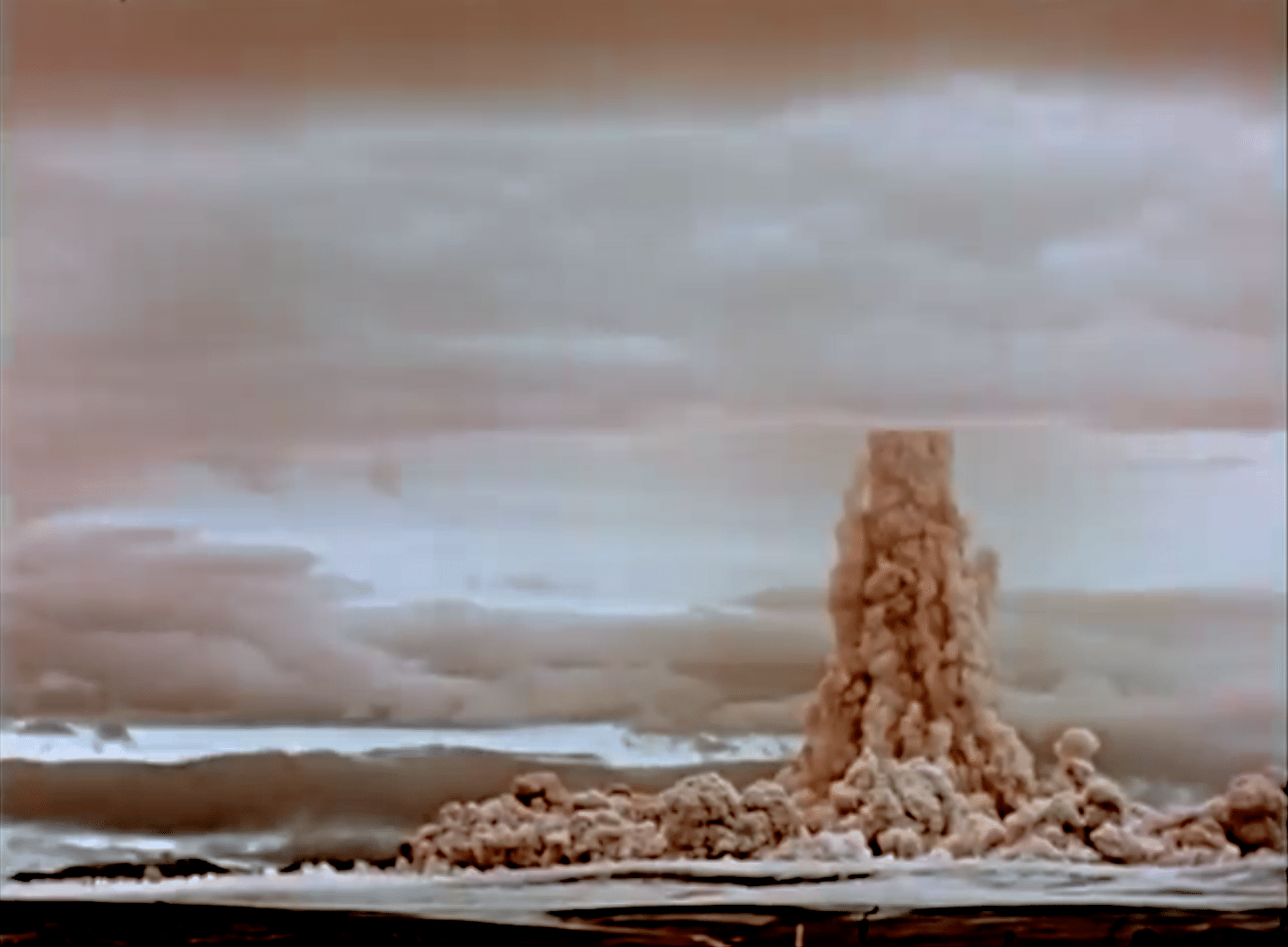
Designed to have a maximum explosive yield of 100 million tons (or 100 megatons) of TNT equivalent, the 60,000-pound monster bomb was detonated at only half its strength. Still, at 50 megatons, it was more than 3,300 times as powerful as the atomic bomb that killed at least 70,000 people in Hiroshima, and more than 40 times as powerful as the largest nuclear bomb in the US arsenal today. Its single test represents about one tenth of the total yield of all nuclear weapons ever tested by all nations.[2]
At the time of its detonation, the Tsar Bomba held the world’s attention, largely as an object of infamy, recklessness, and terror. Within two years, though, the Soviet Union and the United States would sign and ratify the Limited Test Ban Treaty, prohibiting atmospheric nuclear weapons testing, and the 50-megaton bomb would fall into relative obscurity.
“What’s Yours Is Mine”
“The federal government knew, from at least the early 1950s, of severely harmful health effects from uranium mining, but it kept that information from the Diné, as Navajo people call themselves.”
The wheels of justice can move exceedingly slowly, if at all, and it often depends on whether an aggrieved group has much political recognition or clout. Issues linked to mainstream religious freedom can speed their way to the Supreme Court’s shadow docket in record time, while religious and environmental justice issues for Native Americans can simmer on the system’s back burner for a lifetime.
The sprawling Navajo reservation, located in parts of Arizona, Utah, and New Mexico, is the largest and most populous Native American reservation, almost 28,000 square miles. Its Four Corners area (the three states plus Colorado) is rich in radioactive uranium ore. From 1944 to 1986, nearly four million tons of uranium ore were extracted from the reservation under leases with the Navajo Nation. Many Navajo worked the mines, often living and raising families close by.
Reactor at Japan’s nuclear power plant suspended over counter-terrorism demands: Reports
The third reactor at Japan’s Mihama nuclear power plant was suspended by the operator, the Kansai Electric Power company, over inability to enhance counter-terrorism infrastructure in time, the Japanese public broadcaster NHK reported on Sunday.
ANI | Tokyo • devdiscourse.com
Tokyo [Japan], October 24 (ANI/Sputnik): The third reactor at Japan’s Mihama nuclear power plant was suspended by the operator, the Kansai Electric Power company, over inability to enhance counter-terrorism infrastructure in time, the Japanese public broadcaster NHK reported on Sunday.
All the required measures to strengthen security are expected to be completed in September 2022, and the reactor might resume operations in mid-October of that year, the outlet said, citing the operator.
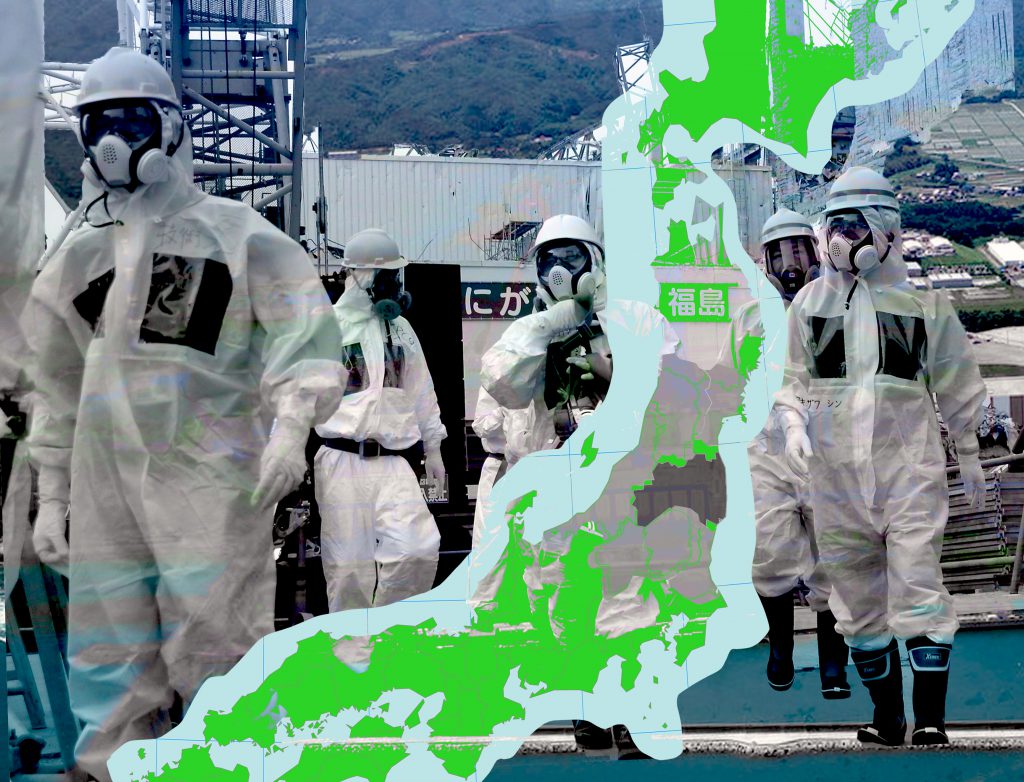
The reactor was restarted on June 23, 2021, after more than 40 years of work. The law limits the maximum lifespan of reactors to 40 years, but if additional requirements are met, a reactor can work more. Mihama’s third reactor was stopped for a decade after the Fukushima earthquake and tsunami, which in 2011 claimed over 15,000 lives, displaced thousands of people and caused a meltdown at the power plant. (ANI/Sputnik)
Groups Fire Back at Feds’ Move to Dismiss Plutonium Pit Lawsuit
Federal agencies continue to reject a full review of the public safety and environmental risks of producing nuclear bomb cores at multiple DOE sites.
Jay Coghlan, director of Nuclear Watch New Mexico, commented, “The government has yet to explain to American taxpayers why it will spend more than $50 billion to build new plutonium pit bomb cores for new-design nuclear weapons when we already have thousands of existing pits proven to be reliable for a century or more. This has nothing to do with maintaining the safety and reliability of the existing stockpile and everything to do with building up a new nuclear arms race that will threaten the entire world.”
SRS WATCH / EIN PRESSWIRE October 26, 2021
AIKEN, SOUTH CAROLINA — Public interest groups shot back at the U.S. Department of Energy and the National Nuclear Security Administration’s attempt to suppress a lawsuit seeking a comprehensive environmental review of the agencies’ plans to produce large quantities of nuclear bomb cores, or plutonium pits, at DOE sites in New Mexico and South Carolina.
U.S. nuclear envoy visits S. Korea amid N. Korea missile tension, stalled talks
The U.S. envoy for North Korea arrived in South Korea on Saturday amid stalled denuclearization talks and tension over Pyongyang’s recent missile tests.
Special Representative Sung Kim’s visit came days after North Korea fired a new submarine-launched ballistic missile (SLBM), which prompted criticism from Washington and calls for a return to talks aimed at denuclearizing the North in return for U.S. sanctions relief.
Kim, after talks in Washington with South Korean and Japanese counterparts on Tuesday, urged North Korea “to refrain from further provocations and engage in sustained and substantive dialogue.”
Pyongyang so far has rejected U.S. overtures, accusing the United States and South Korea of talking diplomacy while ratcheting up tensions with their own military activities.
On Thursday, the North said the United States was overreacting to its self-defensive SLBM test and questioned the sincerity of Washington’s offers of talks, warning of consequences.
Arriving in South Korea, Kim said he looks forward to having “productive follow up discussions” with his counterpart, without elaborating.
WIPP Shipments Stopped Due to Maintenance Problems at Site
Joni Arends, of CCNS, said, “As early as November 2013, Nuclear Waste Partnership, LLC, began to physically expand the WIPP underground. The fire and explosion shutdown that work. It remains evident that NWP is more interested in doubling the size of the WIPP underground and keeping it open forever than doing preventive maintenance.”
CONCERNED CITIZENS FOR NUCLEAR SAFETY October 23, 2021
Due to on-going maintenance problems in the underground disposal facility, the Waste Isolation Pilot Plant (WIPP) requested an extension of time from the New Mexico Environment Department to store waste in the Waste Handling Building. https://wipp.energy.gov/
The request for a 45-day extension to store 13 shipments of plutonium- contaminated waste comes on the heels of on-going maintenance problems at WIPP [PDF]. On October 14th, 2021, the Environment Department approved the extension to November 30th, 2021 [PDF]. All waste shipments to WIPP had previously been stopped from August 25th until September 30th.
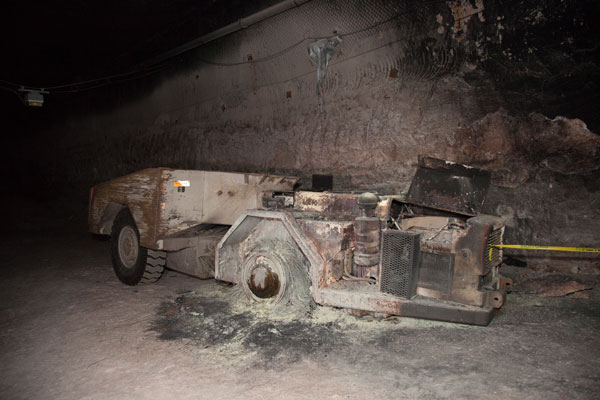
Maintenance problems include ventilation problems on the surface in the Waste Handling Building and managing the floors in the underground. The salt can heave and create uneven surfaces where waste is transported for disposal.


